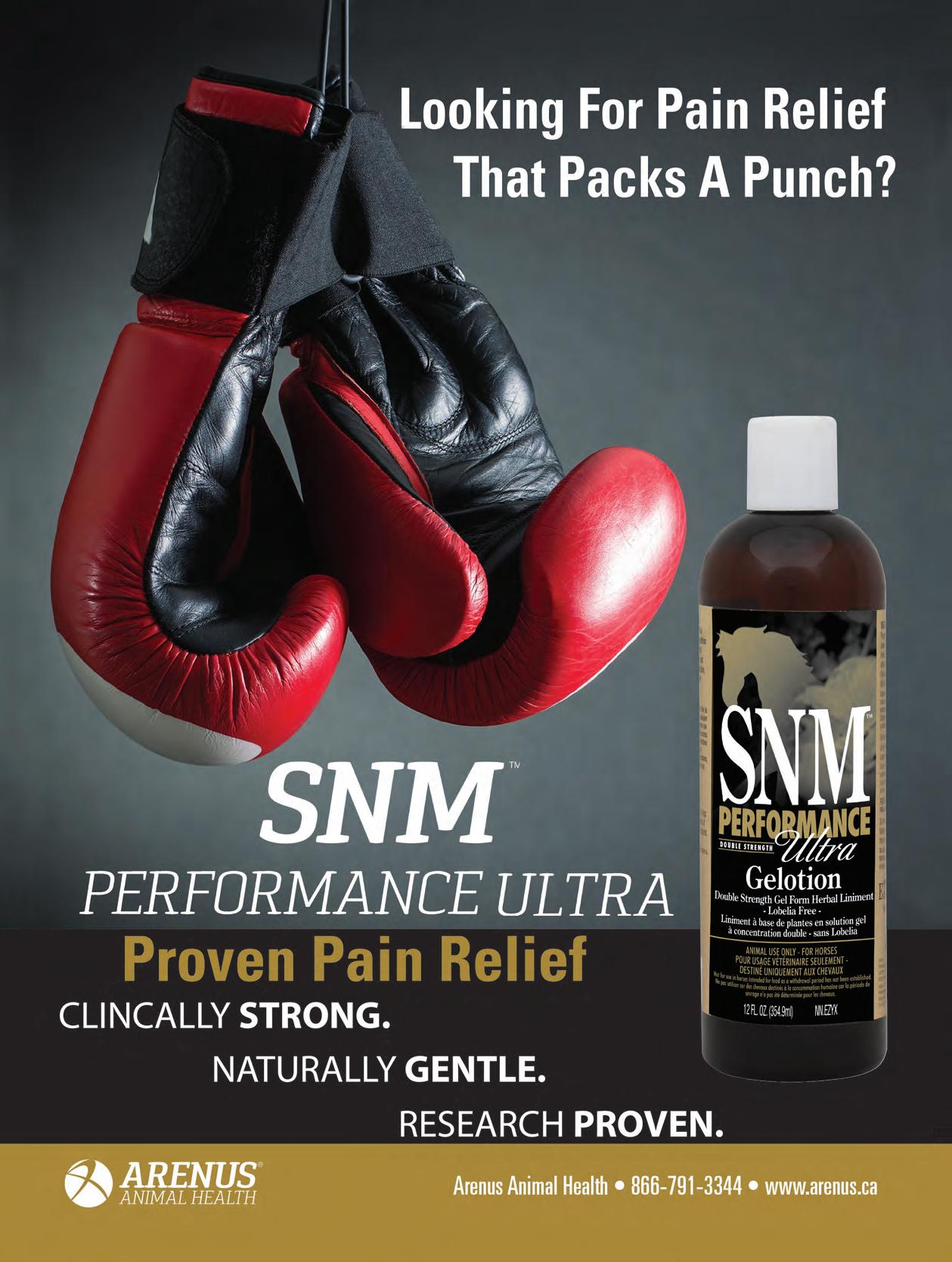





















n
n
Beautiful
Depicting
n HORSES
Performance,
n HORSES
n
Humour,
Sleigh
n
































n
n
Beautiful
Depicting
n HORSES
Performance,
n HORSES
n
Humour,
Sleigh
n










10 Horse Community Heroes: Gillian Allan
Gillian Allan has become a “driving force” in Nova Scotia by promoting driving and connecting youth and seniors to horses.
68 Safe Horses, Safe Spaces, and Farriers Today
How 30 years of experience as a cowboy, trainer, and farrier have shaped the way one farrier works today.
74 Painted Warriors
Backcountry Boot Camp
Building skills and creating authentic outdoor experiences, from an Indigenous perspective.
80 Packing into the Cloud Peak
Wilderness Area of Wyoming
Navigating challenging trails to view spectacular scenery during a memorable four-day horseback trek.
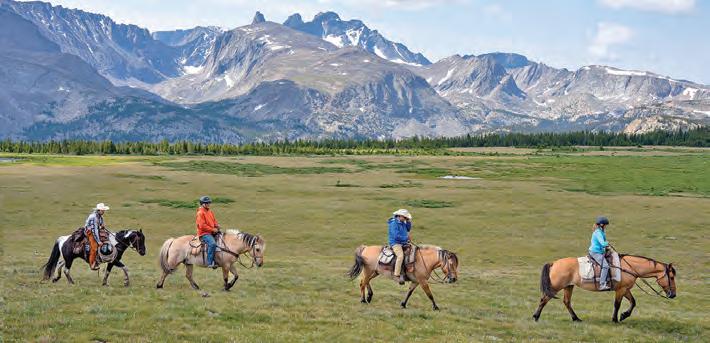
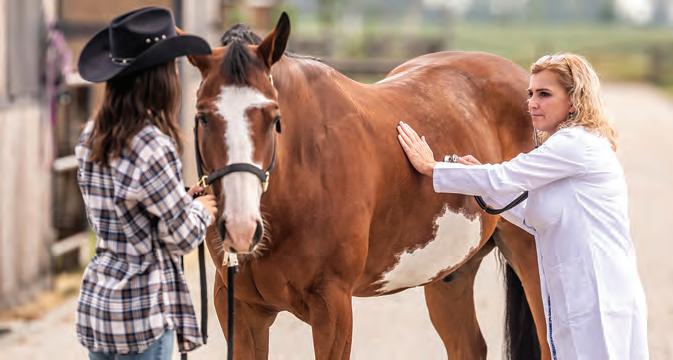
12 What is a Grain-Free Diet?
What does “grain-free” mean, and can these diets be acceptable for active horses?
18 Horse Care During Wildfire Season
Strategies to minimize contact with toxic wildfire smoke and support your horse’s recuperation from exposure to it.
24 Emergency!
If you own horses, you’ll experience an emergency with them sooner or later. Think about worst case scenarios and have a plan in place to deal with them.
30 Tick Talk…
Ticks are increasingly common throughout Canada. Learn how to manage exposure, recognize ticks, and safely remove these disease-carrying pests.
36 Understanding Strangles
How to reduce the risk and recognize the symptoms, and the steps to take to manage an outbreak.

ON THE COVER:
I have seen things so beautiful they have brought tears to my eyes. Yet none of them can match the gracefulness and beauty of a horse running free.
UNKNOWN

























42 Navigating the Gate
Learning to work a gate can be part of your horse’s training transition into a more attentive, patient, and handy partner.
46 Groundwork aka “Secret Conditioning”
When consistently and strategically practiced, groundwork offers the possibility of a notable amount of conditioning.
50 The Five Rein Aids
As fundamental communication tools between rider and horse, each of the five rein aids serves a specific purpose.

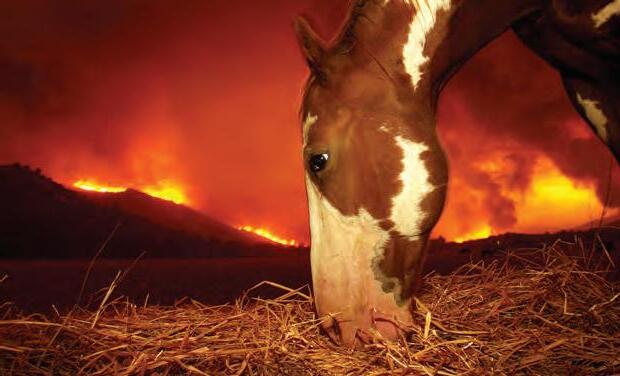
54 The Importance of Fitness for Young Riders
Calling all young riders! Try these exercises to have fun, improve your riding, and keep your horse happy.
60 Karen Rohlf’s Dressage Naturally
An approach that prioritizes the horse’s happiness over performance and competition.
64 Why Curiosity is an Essential Mindset
Curiosity is a secret weapon for the mental game of performance.
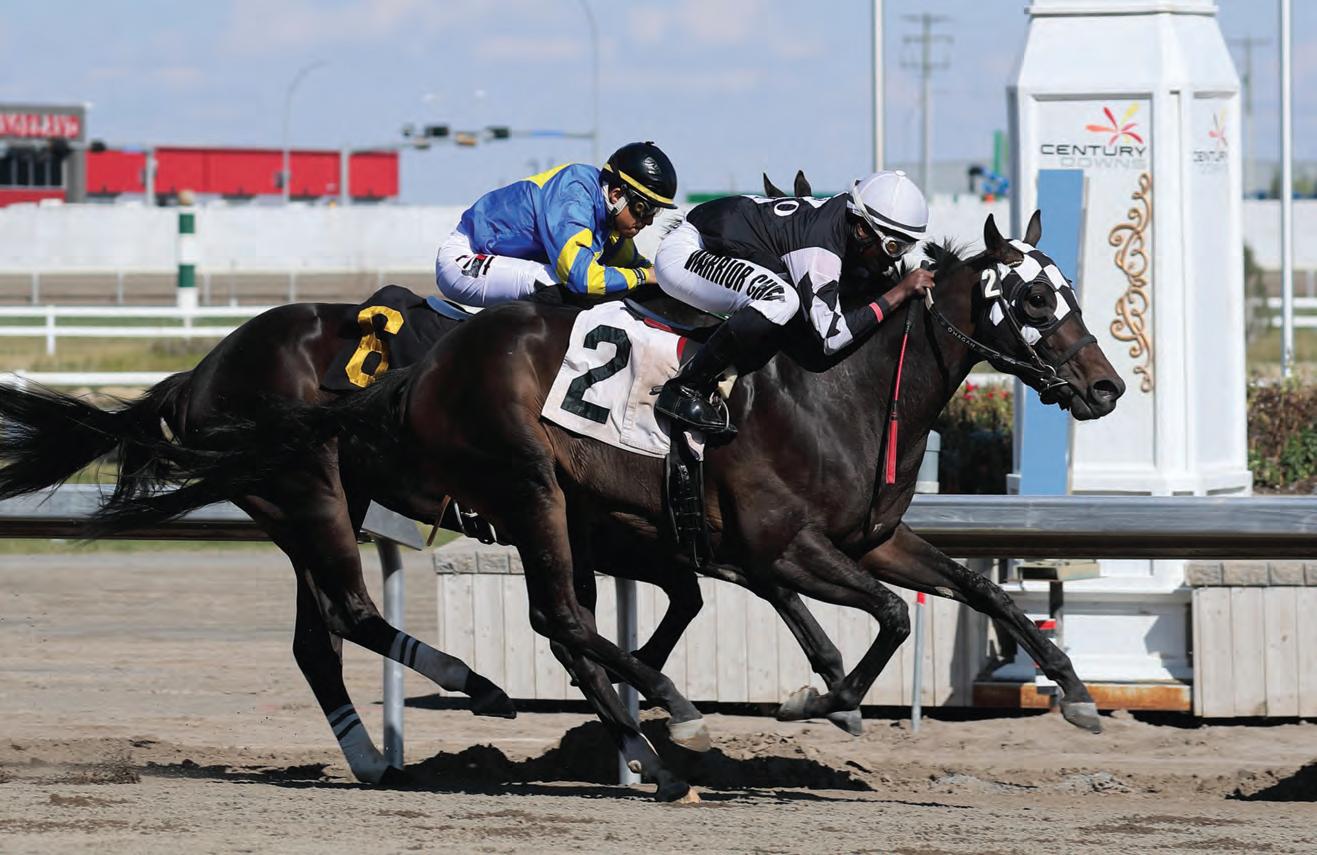






Reading is still the main way that I both learn new things and test my understanding. Bill Gates
People often wonder how we keep our magazine fresh after 33 years. Well, there are countless topics still waiting to be explored, making our possibilities truly endless. Every day, I stumble upon ideas that I know will captivate readers, and our writers pitch in with their own intriguing concepts.
Take, for instance, the ever-evolving ways horses impact our lives. The history and bond between humans and horses alone are fascinating. In today’s tech-driven world, where screens dominate, our genuine connections with family, friends, pets, and yes, our horses, keep us grounded and, well, human.
Now, you might be wondering why someone would pay for a magazine when there’s so much free content available online and in other publications.
Let me break it down for you. Paid magazines invest in top-notch writing, editing, and design, delivering content that’s polished and informative. We owe our expertise to seasoned journalists, experts, and industry professionals who offer more than just catchy headlines — they provide deep analysis, research,
context, and insights, making our content reliable and credible.
Subscribers also get access to exclusive articles, interviews, and features you won’t find anywhere else.
Plus, there’s something special about holding a magazine in your hands. In a digital world, the tactile experience of flipping through pages can’t be beaten. The smell of ink, the feel of the paper — it’s a nostalgic, immersive experience that lets you disconnect from screens and dive into content without distractions.
By supporting paid magazines, you’re backing quality, independent journalism and helping sustain the livelihoods of writers, editors, and staff.
In short, while free content is plentiful, paid magazines offer a curated, premium experience with added value for readers who appreciate quality journalism.
We’re not just a magazine — we’re a community of horse enthusiasts. Our goal is to represent and unite horse lovers from all corners of the country, sharing their passion for these magnificent animals.
Kathy Smith
Horse Community Heroes recognizes people and horses who make a difference to Canada’s horse industry.
Horse Community Heroes provide unending support to others regardless of whether they’re employed in Canada’s horse industry or not, are strongly committed to their regional equine communities, and often operate behind-the-scenes.
“We’re showcasing horse people and horses who are not necessarily big household names but who have made significant contributions to their horse communities,” says Kathy Smith, publisher of Horse Community Journals.
To tell us about a horse person or horse you believe should be recognized as a Horse Community Hero, please email the editor at: editor@horsejournals.com.
Please include your full name, address, telephone number, and email address.
Your Horse b Your Passion b Your Magazine
Published by Horse Community Journals Inc.
Volume 24 • Issue 4
Spring 2024 Issue of Canadian Horse Journal
EDITOR / PUBLISHER
Kathy Smith
ACCOUNTS accounts@horsejournals.com
ADVERTISING
Terry Andrucko • Janna Reimer
SOCIAL MEDIA
Sarah Mellings
SUBSCRIPTIONS
Steve Smith
MARKETING & DISTRIBUTION
Janna Reimer
ART DIRECTION, PRODUCTION
Elisa Crees
CONTRIBUTORS
Tania Millen • Lindsay Grice • Annika McGivern
Jec Ballou • Shawn Hamilton • Sandra Verda-Zanatta
Madeline Boast • Monique Noble • Crystal Lee, DVM
Jacqueline Louie • Li Robbins • Sarah Mellings • Will Clinging
Equine Guelph • CQHA • CanTRA
Horse Council BC • Manitoba Horse Council
ADVERTISING, SUBSCRIPTIONS & GENERAL INQUIRIES 1-800-299-3799 • 250-655-8883 or email: sales@horsejournals.com
ADVERTISING DEADLINE 4 weeks prior to issue date
WEBSITE www.horsejournals.com
MAIN OFFICE EMAIL editor@horsejournals.com
PRODUCTION DEPARTMENT EMAIL design@horsejournals.com
Publishing 4 issues per year
SUBSCRIPTIONS – REGULAR RATES 1 year: $27+tax 2 years: $42+tax US 1 year: $35 US 2 years: $60
ORDERS FOR SUBSCRIPTIONS, CHANGE OF ADDRESS NOTICES, & UNDELIVERABLE COPIES ARE TO BE SENT TO: THE CANADIAN HORSE JOURNAL 10148 Bowerbank Road, Sidney, BC, V8L 3T9 (250) 655-8883 • 1-800-299-3799

Horse Community

PUBLICATIONS MAIL REG. NO. 40009439 GST REG. NO. 829298140 ISSN. NO. 1496-1733

We acknowledge the financial support of the Government of Canada.
REPRODUCTION IN WHOLE OR IN PART OF ANY MATERIAL CONTAINED IN THIS PUBLICATION WITHOUT THE WRITTEN PERMISSION OF THE PUBLISHER IS STRICTLY PROHIBITED.
The information and services listed herein are intended to facilitate accessibility to the professionals, products and services that play a part in the horse industry. While readers are encouraged to use the products and services of the merchants listed in this publication, Horse Community Journals Inc. does not recommend or guarantee the products and services of advertisers or associates listed. Manuscripts and photographs will be returned only if SASE is provided. The return of unsolicited material is not guaranteed. Contributors and advertisers warrant all materials supplied are free of copyright and they have the legal right to use the same. All material accepted for publication is subject to such revisions as are deemed appropriate by Canadian Horse Journal (CHJ). The opinions expressed in CHJ are not necessarily those of the publisher. CHJ reserves the right to refuse any advertising or submission. Contributors consent to have their submissions published in CHJ and on www.HorseJournals.com and elsewhere as determined by the publisher. Printed in Canada. Please recycle.
Equestrians in every province of Canada are supported and represented by horsespecific provincial organizations. A perk of membership in those organizations is access to highly specialized third-party liability insurance. Other perks include education, funding, community, and representation. Here’s a summary:
INSURANCE
Any activity that involves horses carries risks. This is why membership with a provincial sport organization (PTSO) automatically includes two insurance policies: personal liability insurance and accident, death, and dismemberment (AD&D) coverage (except in Quebec). These policies are provided by Acera Insurance, a Canadian insurance company which has been instrumental in developing a culture of risk management in Canada’s horse industry for over 25 years.
1. $5,000,000 of Personal Liability Insurance covers PTSO members against legal actions made against them because of something their horse does. For example, damaging property at a boarding facility; a horse getting loose and causing a car accident; a friend riding someone else’s horse, falling off and getting hurt; someone getting kicked at a horse show; or one horse injuring another in a paddock. This insurance can save members from paying legal and settlement costs out of their own pocket.
2. Accident, Death, and Dismemberment (AD&D) protects PTSO members if they’re seriously injured — or worse — as a result of an interaction with a horse. The Principal Sum Limit is $40,000 plus there are additional coverage options.
3. Beyond these important included products, Acera Insurance has built a suite of “member only” insurance options to cover your horse, your tack, and more.
EDUCATION PTSOs offer valuable educational resources and opportunities that enhance equestrian knowledge and skills for all ages and levels. PTSOs can help members source certified coaches, beginner programs, specialized courses, or long-term athlete development programs.

They provide free webinars on road safety, first aid, nutrition, parasites, hoof care, horse camping, and other topics.
Ontario Equestrian offers a Ticket to Ride program where people who are new to horse sports receive a free ticket to take a “learn to groom” session or an assessment ride at an accredited facility. Horse Council of British Columbia (HCBC) has a free Horse Play Program which encourages riders to record the hours they spend with their horse.
PTSOs also offer P’Tit Trot and Rookie Riders programs for young children, plus support long-term athlete development for riders working towards upper-level competition. They subsidize the cost of Equine Guelph courses on topics such as equine business, senior horse care, gut health, horse welfare, sickness prevention, youth safety, injury prevention, rescue, and emergencies. Additionally, some PTSOs mail a free magazine to their members.
FUNDING Every PTSO offers unique benefits tailored to its members' needs, and those include funding for clinics, shows, and education. For instance, Alberta Equestrian Federation (AEF) provides funding for individual members to participate in a clinic or an event, or to buy a Western helmet. AEF also offers scholarships, bursaries, and club funding, plus funds trail development province-wide. They also have over 100 business members who offer discounts to individual members. HCBC offers similar funding options — athlete assistance, funding for trails projects, funds for regional clubs, educational grants, and travel assistance to individuals. Ontario Equestrian members can access similar programs plus a youth bursary, which funds members who are still in high school.
Beyond insurance, educational benefits, and financial help, PTSOs foster a sense of community within the equine industry of each province. They’re the recognized organization for horse use in each province and provide a platform for members to connect, regardless of their discipline or level of involvement. PTSOs also address community-wide issues and by joining forces with thousands of fellow horse enthusiasts, members can ensure their collective concerns are heard.
Provincial governments look to PTSOs of all different sports to provide a unified voice from their members. Hence, it’s imperative that equestrians join their PTSO to ensure that horse sports are visible to provincial governments. Numbers matter. The more members, the more likely that lands will remain accessible to horseback riders and that horseback riding itself will remain socially acceptable within Canadian society.
With all these benefits, it makes good sense to become a member of your provincial horse sport organization, regardless of your area of interest in the industry. Plus, every member strengthens the collective voice of the horse industry. Join your PTSO today to access these advantages and contribute to a vibrant and united equestrian community both now and into the future.b www.CapriCMW.ca/equine
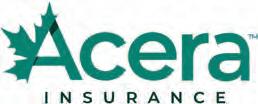

By Tania Millen, BSc, MJ
Like many horse people, Gillian Allan wears lots of hats.
“When I’m working with my Halflingers, I’m a breeder,” says Allan from her Folly Farm along the Wallace River in Middleboro, Nova Scotia. “When I’m coaching carriage driving, I’m a coach. When I’m volunteering with any one of the boards that I’m on, I’m a community volunteer. When I’m training ponies, I’m a trainer. But I’m really just Gillian.”
Allan started riding when she was quite young and still has her first hobby horse in her house. But she always dreamed of driving.
“I used to sit up in the barn loft in an old sleigh with a bridle hooked to the wall and the reins in my hands, driving my imaginary horse,” says Allan.
However, it wasn’t until she was an adult that Allan pursued her dream.
“I bought two Welsh ponies in about 1995 that were trained to drive, along with the wagon and harness for them,” says Allan. “That was my first driving experience and it was awesome. After a while, I wanted to learn how to do it properly and be safe, so I started taking clinics.
“When the Welsh ponies finally aged out, I decided to step up to Halflingers so that I could learn how to drive a carriage and pull more people around,” Allan says.
Taking clinics herself, Allan realized how many horse people were seeking knowledge and she’s been helping fill that gap ever since.
“Continuous learning is really important and
so is supporting our horse community,” says Allan, who has been or is involved with Equestrian Nova Scotia, Nova Scotia Driving Society, Nova Scotia Haflinger Club, Canadian Haflinger Association, and her group of drivers who have created the Wallace River Carriage Club.
Allan is an Equestrian Canada (EC) driving coach; has organized many combined driving and pleasure driving clinics and shows at her farm with renowned judges and clinicians; and has promoted the EC “Learn to Drive” program and US Carriage Driving Association
“Driving Proficiency Level 1.”
“I’ve had some wonderful mentors over the years, from the United States, United Kingdom, Nova Scotia, Quebec — our clubs bring in great mentors for
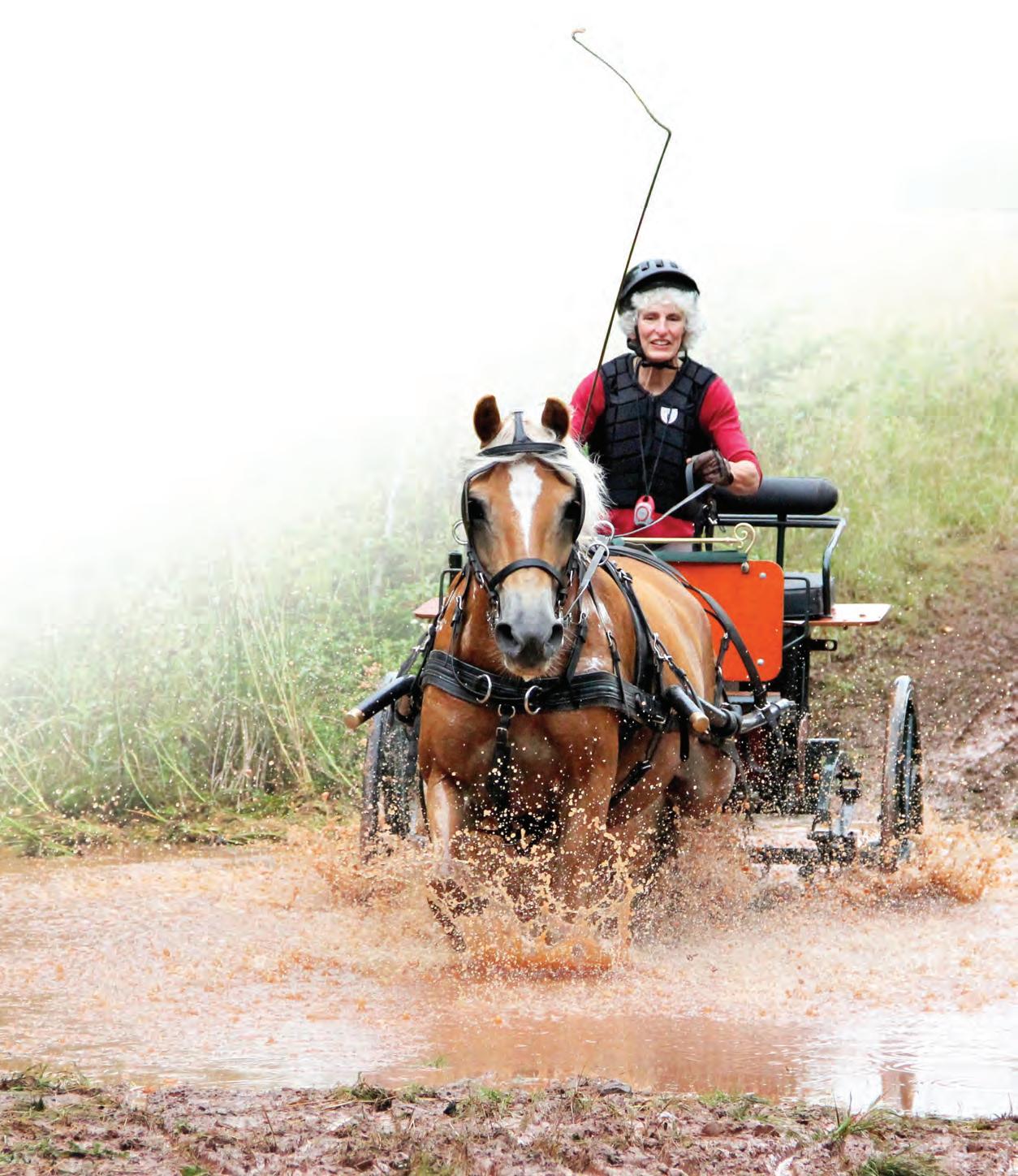
coaching,” explains Allan.
Along the way, Allan realized there was a shortage of horses suitable for driving. So, having fallen in love with Halflingers, she started breeding them.
“I bought a lovely stallion and then kept on improving my mare stock,” she says. “We’ve been breeding for about 15 years, but my husband and I are aging, so our breeding program is slowing down.”
More recently, Allan and her supporters developed their own “Ponies and Pals” program to help youth learn horsemanship and driving skills.
“We felt there was a lack of education in children who were starting riding and driving,” says Allan. “We have people who have horses, equipment, expertise, and knowledge, so we created a program.
“The first six weeks are ground lessons on how to handle and read horse body language, plus basic care of horses,” Allan explains. “Each child has a mentor and I’m a certified coach, so we provide a safe and structured environment at our barn.”
The second six-week session introduces the children to driving.
“Each child is taught by their mentor to harness and hitch and drive a horse or pony,” says Allan. “It’s a way to get kids involved. Plus, most of the mentors are seniors, so it’s a wonderful way to engage them in life — by helping other people. It’s about more than horses.”
Allan’s group also hosts adult learn-todrive programs.
“We spend a day with 30 or 40 adults who want to learn how to drive,” she explains. “We do everything from safety to harness fitting to ground driving and then they all get a chance to drive.”
Allan and her friends have supported their communities in other ways, too.
“We did a carriage drive to feed Nova Scotia where we all recorded our driving hours for six months and raised money for the provincial food banks,” says Allan. “Our group also just finished making a full-size gastrointestinal tract of a horse so that we can take it to education sessions to illustrate how colic is the leading cause of death in healthy horses.”
All told, Allan has been instrumental in promoting driving in Nova Scotia, and along the way, helping connect youth and seniors to horses.
“I love teaching, I enjoy horses, and I know how much fun driving is,” says Allan. “I’ve been fortunate to combine all those together.” b
> Tania Millen is a regular contributor to this magazine — read her bio on page 94.

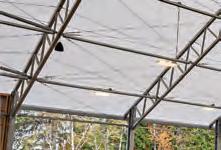

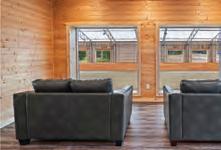































By Madeline Boast, MSc. Equine Nutrition
Q: Fact or fiction? Horses require grains to be fed in their diet to meet their nutritional needs.
A: Fiction!
Grains are not a required feed ingredient for horses, and reducing the amount of grain-based products fed to horses has been a popular trend in recent years.
Grains have developed a poorer reputation in equine nutrition due to their higher nonstructural carbohydrate content. Most horse owners understand that forage is
almost always the preferable energy source to promote gastrointestinal health; however, understanding optimal feed supplementation for the varying needs of horses is imperative to well-being. With “grain-free” becoming a hot topic, there are many misconceptions throughout the industry. Understanding what grain-free means is valuable when designing your own horse’s nutritional plan, especially for active horses.
The Association of American Feed Control Officials defines grains as “a seed from cereal
plants.” A few examples of various grains are oats, corn, wheat, and barley. Where the confusion often begins is when a different part of the grain is used.
There are four distinct parts to a grain: the germ, the endosperm, the hull, and the bran. This can be confusing for horse owners to navigate as even though the product may not contain full oats, corn, barley, or wheat, the feed product may still contain the hulls, for example.
A product can be labelled as grain-free if the intact seed portion is not included. This means that other parts such as the hull may be used despite the product being labelled as grain-free. In equine

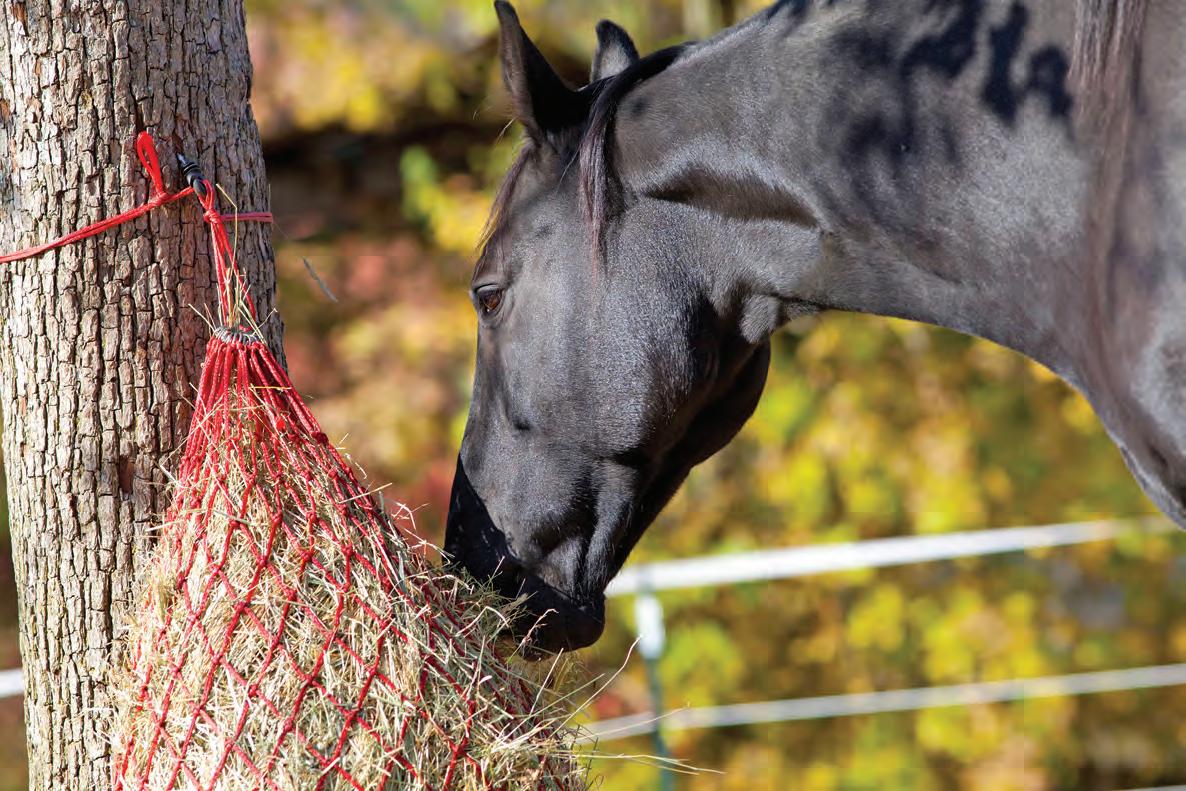

nutrition it is extremely common for the hull and bran to be used as they are very fibrous. Therefore, even if a product is labelled grain-free, it may have parts of the grain used as ingredients.
Another popular misconception regarding grains for horses is that any product that is pelleted is commonly referred to as “grain.” Therefore, a key part of understanding grain-free diets is understanding what a grain is.
In addition, it is important to note that concentrate products are processed (e.g., extruded, pelleted, cracked) to improve digestibility, palatability, reduce the ability of the horse to sort ingredients, and eliminate dust.
Investigating concentrate products comes down to reviewing the guaranteed analysis and reading the ingredient list. There are a variety of products on the market that are pelleted or extruded concentrates and labelled “grain-free” but do contain the hull, for example. This does
As forage alone will not meet your horse’s nutritional requirements, the first step to designing your horse’s nutritional plan is to have your hay analyzed to determine its nutritional value.
not tend to be problematic as those products are high in fibre and lower in starch and sugar than the grain-based products.
Although grains are not required for a balanced diet, forage alone will not suffice. The majority of a horse’s diet is almost always hay, which is recommended for gastrointestinal health, but hay alone will not meet nutrient requirements.
The Nutrient Requirements of Horses, Sixth Revised Edition (2007), published by the National Research Council (NRC), has published recommendations to prevent nutritional deficiency. The six required nutrient categories for horses are water, protein, carbohydrates, fat, vitamins, and minerals. A quality forage will typically meet the energy and protein requirements of most inactive or light riding horses, but vitamins and minerals must be supplemented.
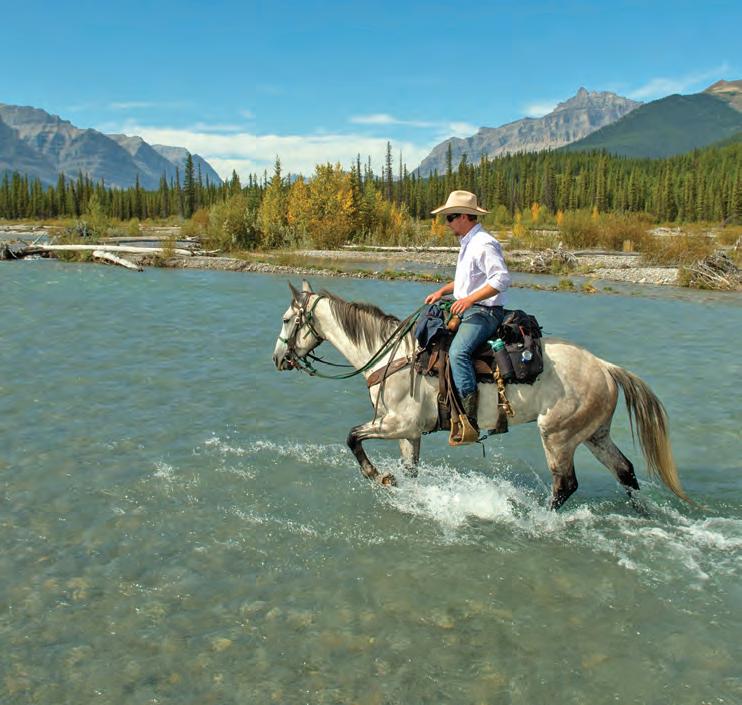
Horses performing long-term work (shown here) primarily use slowtwitch muscle fibres which utilize fat for fuel. Horses in fast work of a shorter duration (below) have more fast-twitch muscle fibres and utilize glucose for fuel.

It is impossible to remove all the carbohydrates from your horse’s daily ration, and prior to trying to remove the starch and sugar it is critical to understand the different types of carbohydrates. As mentioned, carbohydrates are one of the six essential nutrient classes for horses and are therefore required in the diet.
Carbohydrates are divided into two broad categories: structural and nonstructural (NSC). Structural carbohydrates are the fibrous portion of the plant (hemicellulose, cellulose, polysaccharides); therefore, hay is a significant source of these. Structural carbohydrates will be the highest in
mature and overly mature forages and lower in immature hay and pasture. In the foregut, structural carbohydrates cannot be digested. The horse relies on the microbial fermentation in their hindgut to break down these nutrients into a usable energy form (volatile fatty acids).
In contrast, NSCs are the nonfibrous carbohydrates (mono-, di-, oligosaccharides, and polysaccharide starch). NSCs are the highest in cereal grains and will also be high in immature forages such as fresh pasture. This type of carbohydrate can be digested in the foregut by the digestive enzymes present. The energy from these carbohydrates can be absorbed by the horse earlier on in the digestive tract and therefore used immediately for energy.
It is well-known that horses do not thrive on high starch rations. When high NSC meals are fed, the horse is unable to digest and absorb all the starch and sugar in the foregut and therefore, some of it reaches the hindgut. When this occurs, there is a disruption of the hindgut microbial population and an increased risk of gastrointestinal upset.
Excessive carbohydrate intake has also been linked to equine obesity, equine metabolic syndrome (EMS), laminitis, colic, and undesirable behaviour. A high NSC diet can also exacerbate equine muscle conditions (e.g., polysaccharide storage myopathy). Therefore, if you are considering a grain-free diet for your horse, consider the reason. For example, does your horse require a low starch ration for health reasons? Are gastrointestinal issues arising?
A horse owner may investigate a grain-free diet for a variety of reasons. Easy-keepers and horses at maintenance are quite simple to maintain on a grainfree ration. Chances are, they are already on one. Grain-free is an option for active and working horses too; however, before making the switch, educate yourself on other options for nutritional supplementation.
Hay testing is the critical first step when designing any balanced diet plan for a horse. It is impossible to be confident that your horse’s nutritional requirements are being met if you do not know the nutritional value of the hay. A hay analysis will provide you with a significant amount of information that can then be used to choose optimal products when formulating a nutrition program.
If your horse requires a low NSC diet, testing your hay to ensure it is low in NSCs is critical for safety. Your hay analysis will also provide information on how much protein and energy the forage supplies. This is key information as you can then rely on it as a base for supplemental product decisions. For example, if you have a senior horse being maintained on a vitamin and mineral supplement mixed with beet pulp, but new hay is much lower in protein compared to previous hay, you may need to add a quality protein source such as alfalfa cubes or pellets.
If you have a horse that readily maintains weight on hay, it is easy to source a grain-free ration balancer. These products are designed to provide vitamins, minerals, and often supplemental protein as well to the horse without adding a significant number of calories. When investigating the ingredient list on pelleted ration balancers, the hulls of grains are commonly included. This should not be a concern, even for your easy-keeper, as they are fibrous and not high in starch or sugar.
If you are looking to curate a ration that does not have any grain, or even grain parts in it, a vitamin and mineral powdered supplement at a minimum is what you would need to feed your easykeeper. These products work well for balancing a ration as long as the hay is meeting your horse’s protein requirements. For palatability, they are typically mixed with a soaked fibre source such as hay cubes or beet pulp.
Active and hard-working horses generally need additional nutritional supplementation above and beyond hay and a ration balancer. In these cases, a fortified performance feed that includes vitamins, minerals, protein, and additional carbohydrates and fats, is fed. These products are often pelleted or extruded and contain an array of various ingredients. As previously mentioned, it is important to understand that just because a product is pelleted does not mean that it is high in starch or contains large amounts of grains. In fact, many of these products include fibre-based ingredients such as alfalfa meal, oat hulls, beet pulp, and fat sources like oils and rice bran. Of course, often there will also be grain ingredients such as steam-rolled oats or cracked corn to list a couple of the many examples. Therefore, if you are beginning to investigate grain-free due to concerns over starch intake or gastrointestinal upset, consulting an equine nutritionist to critically review the ingredient list of various performance products is recommended. To reiterate, just because a product is pelleted or processed does not mean it is high in starch and sugar. Lowstarch feeds will generally rely on fat and fibre as the primary energy source, instead of NSCs.
Although there may be various situations in which a low NSC diet is recommended, it does not mean there

Musculoskeletal disease is a widespread problem, especially in performance horses. Fortunately, it does not have to be a career-ending disease. Regenerative therapies are revolutionizing equine health care, offering versatile solutions for a wide range of conditions. From promoting tissue regeneration to supporting overall health, these cuttingedge treatments are transforming the way we care for our horses.

carefully collects a blood sample, using sterile techniques to prevent bacterial contamination, and mixes it with an anticoagulant solution. Next, the blood sample is spun in a centrifuge, such as the ProVet APC system, to separate the blood into its components. After the blood is separated, PRP can be harvested. Finally, PRP is injected at the site of the horse’s injury.
Regenerative therapies use substances from an animal’s own body to treat a tissue injury. These therapies, also called autologous blood products (ABPs), are biologically compatible and less likely to trigger adverse reactions.
Regenerative therapies concentrate beneficial substances found in the blood. These substances include stem cells, white blood cells, platelets, scaffolding materials, and chemical signals. When these substances are concentrated in a small volume, they can be injected at an injury site to promote healing, stimulating the immune system to replace or regenerate body cells.
Platelet-rich plasma (PRP), a common regenerative therapy, delivers platelets and white blood cells to a site of tissue damage to help heal damaged tissue. To create PRP, a veterinarian first
Use the QR code below to see a brief video showing the collection and use of PRP. Platelet-rich plasma can treat a variety of injuries and diseases in horses. If you think PRP or other regenerative therapies may help your horse, talk to your veterinarian to learn more. b



Structural carbohydrates, the fibrous portion of the plant, are high in mature forages and lower in immature hay and pasture. Non-structural or nonfibrous carbohydrates are highest in cereal grains and high in immature forages such as fresh pasture.

aren’t benefits to including grains in the ration of working horses. Energy is a requirement for survival, and horses that are performing or working have a greater energy requirement. But it is important to note that not all energy sources are equal. Different types of work have different types of fuel which relates to the primary muscle fibre type in the particular horse. Horses in fast work of a shorter duration (e.g., racehorses, showjumpers) will have
more fast-twitch muscle fibres, which only utilize glucose for fuel. This work is characterized by a heart rate above 170 bpm. On the other hand, horses performing long-term work such as endurance will primarily make use of slowtwitch muscle fibres, which only utilize fat for fuel. This work is characterized by a heart rate below 170 bpm.
There are also trainable muscle fibres which comprise about 50 percent of the

muscle fibres in horses. These muscle fibres can use both fat or glucose for fuel, and what they use for fuel will depend on the horse’s diet. With the training of these muscle fibres, it takes a minimum of three weeks to effectively change fuel sources.
Fat sources are higher in caloric content than starches/sugars but are not an ideal fuel source for work that relies on fast-twitch muscle fibres. If the horse is required to do short speed work at a high intensity, NSCs are a crucial energy source as they can be immediately available for the horse to use.
Horses do receive some NSCs from their hay, and in most cases our riding horses in light or moderate work can be well-maintained on a grain-free diet. However, horses in very heavy work that results in a heart rate over 170 bpm may benefit from some carbohydratecontaining grains.
Both grass and legume hay will contain a small amount of starch, about two to three percent, and the sugar content will vary greatly depending on a variety of factors such as harvesting conditions, drying time, cutting time, and plant species in the forage. The starch content of grains will vary depending on the type; for example, oats are about 40 to 50 percent starch, whereas corn is about 70 percent.
• Massage Therapy
• Craniosacral Therapy
• Kinesiology Taping • First Aid • Aromatherapy • Body Alignment • Holistic Nutrition • Hoof & Mouth Anatomy



A performance horse in moderate work can likely be maintained on a grainfree ration with a supplemental source of vitamins and minerals, additional protein, and fats for calories. For horses in very heavy work that relies on fasttwitch muscle fibres (e.g., racing), having grains incorporated into the diet is beneficial to increase the amount of NSCs available for energy.
If you have a horse in heavy work that benefits from the inclusion of some grains, there are ways to feed these highstarch products to minimize the risk of gastrointestinal upset. The first consideration is meal size. As previously discussed, when large meals high in NSCs are fed, starch will reach the hindgut as the horse is not able to digest it all in the foregut. This negative situation can be avoided by feeding any high NSC products in small amounts to prevent the excess starch and sugar reaching the hindgut. Additionally, opting for processed grains (cracked, pelleted, extruded) improves the digestibility of the starch and lessens the risk of the undigested starch reaching the hindgut.
Senior horses are often unique as they do not require starch and sugar for heavy work requirements, but generally need additional calories and protein above and beyond what their hay offers. When designing a grain-free ration for a senior horse, of course you must always start with a vitamin and mineral supplement at the bare minimum. From there, rely on your hay analysis to decide how much protein to add to the diet. Alfalfa, or other legumes and clovers, can be used to increase the protein content in a ration without adding grains. Alfalfa cubes and pellets are readily available and can be a great option for many senior horses. Adding fat sources is also recommended if your senior horse requires additional caloric supplementation but you wish to feed grain-free. Oils such as flax or camelina are popular, and other fat sources include ground flaxseed or products such as rice bran. These diets with vitamin and mineral supplementation, a quality protein source, and added fat are often great options for senior horses struggling to maintain weight but diagnosed with PPID or EMS.
The senior horse’s diet should always be based on a hay analysis. In addition to a vitamin and mineral supplement, they usually need additional calories and protein.

Soaked hay cubes for a senior horse
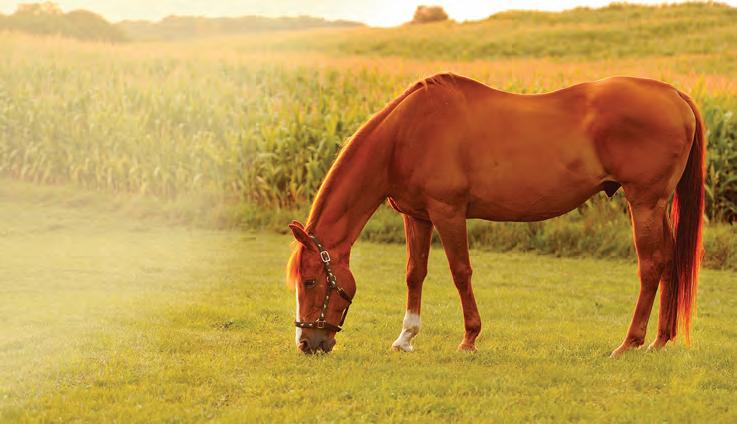
To summarize, carbohydrates are an essential component of equine nutrition and must be provided to our horses. However, grains are high in NSCs and when fed in large amounts or to horses that do not require the additional supplementation, they can have a variety of negative health implications. There are also various health issues such as horses diagnosed with PSSM or EMS that require low NSC diets. In these situations,
designing a grain-free diet is recommended. Grain-free is an option even for senior horses and many active horses. Remember that grains are not all bad and there is a time and a place for them in equine nutrition; however, they need to be fed in a way that minimizes the risk of digestive upset for our hard-working performance horses.
b
> Madeline Boast is a new contributor to this magazine — read her bio on page 94.

By Monique Noble

Canadian equestrians breathe a sigh of relief when long-awaited spring weather finally arrives and the outdoor riding season begins in earnest. Time to fit up our horses and ourselves for trails, competitions, and the pleasure of spending time outdoors, finally free of the layers of winter gear and horse hair that come with the chillier seasons…
As we head for the outdoor ring or start down our favourite trail, it’s heartbreaking to see that tell-tale orange tint in the sky. Fire doesn’t have to be close for your plans to go, well, up in smoke. Equestrians across the country are getting used to seeing smoky skies as researchers recommend “learning to live with fire.”
An extended and record-breaking 2023 wildfire season saw states of emergency and evacuations across Canada. With plumes of smoke drifting across the country, even those not among the nearly 200,000 evacuees were impacted by poor air quality, the oppressive pall of smoke in the air, and devastating losses as over 18 million hectares of land went up in smoke.
Quebec had more than 120 fires ignite in one day in 2023, as arid conditions associated with climate change led to incredibly dry underbrush that could light with a single spark.
As predicted, the 2024 wildfire season has arrived early, and as if to prove this point, the fire threat here in Alberta was made abundantly clear just yesterday as I drove past a smouldering coulee sparked by a blown tire; thankfully, it was quickly tamed by local firefighters.
My local grassfire may have been subdued but some overwintered fires from 2023 that burned under blankets of snow are still smouldering and will reemerge in spring as temperatures rise. On February 21, 2024, CBC News reported

that there were still 92 active overwintering fires in British Columbia (BC) and 54 in Alberta.
With little snowpack accumulated over an unseasonably warm winter and increasing temperatures bringing hot and dry conditions across Canada, an above normal spring fire risk is predicted for Southern Quebec, Eastern Ontario, and Northern BC with similar conditions affecting the rest of BC, the prairies, and Northern Ontario later in the season.
The Northwest Territories (NWT) is also expected to have drought conditions until later in the year and is preparing for another difficult wildfire season. In 2023, the NWT saw more than four million hectares of forest burned and the


evacuation of 12 communities including the entire city of Yellowknife and its environs. Hot, dry conditions and low water levels throughout the NWT and Alberta also cause water sources required for fighting fires to be less reliable for water procurement. First responders, environmentalists, and horse enthusiasts alike are all hoping that El Niño will give way to his somewhat gentler, cooler sister
La Niña this fall. Unfortunately, with abnormally dry conditions present across most of Canada it seems that this summer we can expect more smoky, hazy days ahead of us, and we should be prepared for them.
There is very little you can do to prepare your horse for smoke inhalation. Even horses housed indoors are exposed to smoke as it circulates through ventilation systems and pervades the air. As horse owners, the best thing we can do is educate ourselves and pay attention to air quality and the signs our horses are giving us.
A horse’s lungs are massive; they move more than 2,000 litres of air per minute during heavy exercise, and they also have 50 times more alveoli than human lungs. Alveoli are the microscopic air sacs within our lungs where gas exchange occurs. That alone makes horses incredibly susceptible to respiratory issues when there are impurities like smoke in the air. Horses are also obligate nose breathers, which means they cannot breathe through their mouths like humans can. With only one way to breathe it is vital our horses’ nasal passages remain free of blockages and irritants.

Canada, the third most-forested country in the world with about nine percent of the world’s forests, has seen about 7,300 wildland fires each year for the past 25 years.


Look away from the sun and use a landmark at a known distance as a benchmark. Once you have picked your benchmark, if visibility is easily over 5 miles the air quality is good, if visibility is 5 miles away but hazy the air quality is still moderate but beginning to deteriorate, should be monitored and may be a hazard to sensitive individuals.
If visibility is under 5 miles the air quality is unhealthy and outdoor activity should be limited for young children, seniors (65 and older), expectant mothers, and people
or horses with compromised respiratory systems.
If visibility is under 3 miles the air quality is bad for everyone and outdoor activity should be avoided.
If visibility is under 1 mile the air quality is hazardous for everyone, outdoor activity should be avoided, and it might be a good idea to leave if you can.
Note: Loosely translated to kilometres the 5-3-1 visual index can be remembered as 8-5-2. High humidity can reduce the effectiveness of this method.
Wildfire smoke is incredibly toxic to lungs — whether horse or human — and while normal healthy lungs can fend off a bit of exposure, prolonged exposure is decidedly unhealthy. A mixture of particulate matter from whatever was in the fire’s path, carbon monoxide, ammonia, and a litany of other gases and toxins, can lead to both chemical and heat irritation of the delicate respiratory system. The horse’s fantastic lung capacity can cycle and store an incredible amount of minute smoke particles, which are small enough when inhaled to settle deep within the lungs after exposure, causing damage to delicate lung tissue. This damage can make a horse’s respiratory tract more susceptible to bacteria and pollen agitation and can lead to chronic respiratory issues if not addressed. Damage from smoke exposure often appears as lethargy, coughing, fast shallow breathing, wheezing, nasal discharge, irritated eyes, and an increased heart rate. In some cases, this will be accompanied or followed by pneumonia and fever. Left untreated, and sometimes even after treatment, smoke exposure can turn into chronic equine asthma.
If there is a good chance that smoke is going to be in your area, you could choose to proactively feed a supplement proven by research to provide respiratory support and improve lung function, in addition to diligently monitoring air conditions and being prepared to manage your horse’s exercise and turnout schedules accordingly.
As a rule of thumb, when the air quality is not good for humans to exercise in, it’s not good for horses either. Canada has a very thorough and real time Air Quality Index (AQI) online at www.weather.gc.ca/airquality/pages/ index_e.html to help us make the right decisions regarding air quality. If your horse has a history of respiratory issues such as asthma, a pre-existing cough, or recurrent airway obstruction (also known as “heaves”), it is wise to consider them to be in the at-risk category and more susceptible to the effects of smoke.
If you do not have access to the online AQI Index, such as when out on the trail, you can use the 5-3-1 visual index to assess the air quality in the area (see Sidebar).
We try our best to avoid exposing our horses to hazardous environments, but sometimes it is out of our hands. So,

Respiratory disease is one of the most important health concerns facing the horse industry, and accounts for one of the biggest reasons why horses miss training days (Rossdale et al., 1985). Equine asthma, also known as “heaves,” is one of the more troublesome small airway diseases which causes an elevated rate, chronic coughing, and runny nose, and affected horses often find it difficult to exhale.


In an experiment using six horses with equine asthma at a research barn at the University of Guelph, Ontario, investigators evaluated the ability of an herbal mixture (Breathe) to reduce symptoms of this chronic, debilitating disease. Horses were housed indoors under typical management conditions, half of them receiving Breathe (half cup twice daily) and the other half receiving a placebo (equal weight of chopped alfalfa) for three weeks. After three weeks, the horses were given a two-week break. The groups were then reversed and the trial was repeated with horses fed their supplements for another three weeks. Thus, each horse received the herbal supplement in one of the two experimental periods, each lasting 21 days.
A ventigraph was used once a week to very accurately measure each horse’s respiratory rate and the effort required for them to breathe. Blood was also analyzed for changes in basic hematology and biochemistry to identify any possible side-effects.
Results of this experiment demonstrated that when horses were receiving the herbal supplement, there was a significant decline in respiratory rate compared with when they were receiving the placebo. The
difference between the herbal supplement and the placebo was statistically significant after one week and remained so for the remainder of the experiment. The product was found to be safe, with no adverse effects evident through the blood screens. These results demonstrate that this herbal mixture can be used to treat symptoms of equine asthma.
Respiratory disease is a major concern in performance horses, and intensive research has not yet been able to find a cure for equine asthma. Herbs have been used with some success in treating chronic respiratory disease in horses (Sommer et al., 1986) and other species (Aqel 1991), and this research provides additional support for this application. An increase in respiratory rate is a fundamental symptom of equine asthma caused by a combination of constricted airways, accumulated mucous, and smooth muscle spasms. A reduction of the resting respiratory rate may reflect improvement in any one or a combination of these factors. Further research is required to discover the mechanism by which Breathe was able to reduce the respiratory rate in these horses. b

Learn more about Breathe at bit.ly/Breathe-HFH (case sensitive) or scan the QR code.
For more information, visit www.horseherbs.com.
If you encounter smoke while on the trail, move to lower ground immediately then slowly and calmly make your way out of the area.

UC Davis
Horses exposed to fire smoke can suffer respiratory injury of varying degrees, ranging from mild irritation to severe smoke inhalation-induced airway or lung damage.
Knowing what is normal versus concerning can help to know whether a veterinarian should evaluate your horse.
Respiratory rate at rest should be 12-24 breaths/minute.
Horses should be examined by a veterinarian if any of the following are noted:
• Respiratory rate is consistently greater than 30 breaths per minute at rest;
• Nostrils have obvious flaring;
• There is obvious increased effort of breathing when watching the horse’s abdomen and ribcage;
• There is repetitive or deep coughing OR abnormal nasal discharge;
• Horses should also be monitored for skin and tissue injury, especially for the first few days after exposure.
what to do after a horse has been exposed to smoke? The first thing is to have them assessed by a veterinarian to determine how severe the exposure is, especially if there is any shortness of breath, coughing, or nasal mucus being expelled. If the smoke exposure is minor there are a few options to help your horse recover a little faster. But after acute exposure an extended rest period is required.
University of California, Davis recommends to: “Give your horse ample time to recover from smoke-induced airway insult. Airway damage resulting from wildfire smoke takes four to six weeks to heal. Ideally, plan on giving your horse that amount of time off from the time when the air quality returns to
normal. Attempting exercise may aggravate the condition, delay the healing process, and compromise your horse’s performance for many weeks or months. It is recommended that horses return to exercise no sooner than two weeks post smoke-inhalation, following the clearance of the atmosphere of all smoke. Horses, like all other mammals, tend to have an irritation to particles, but should recover from the effects within a few days.”
While you are waiting for your horse to recover from exposure there are things you can do. Ensuring your horse has access to plenty of fresh water is very important, and wetting down their hay is also helpful as it reduces feed dust and increases the horse’s fluid intake while helping keep their inner passages hydrated.
A horse that has had more acute smoke exposure or a history of respiratory issues may need a little more help in recovery and should be assessed by a veterinarian. A veterinary exam may result in prescribed mucolytics, nebulizers, and/or equine inhalers. These should only be used on the advice of a vet, as incorrect usage could exacerbate the horse’s health problem.
Allowing the horse the time needed to recover is of utmost importance, but they need our time too. Horses are incredibly sensitive to their environment, and they are instinctively driven to move away from smoke. In most cases, the modern domestic horse does not have the option of moving away from smoke, so they need their owners to take the time to be with them and give them a sense of safety. Grooming, bathing, hand walking, and calm groundwork are all positive, fun ways to safely pass the time with your horse while the smoke clears. b
> Monique Noble is a new contributor to this magazine — read her bio on page 94.

Dangerous beauty in an Alberta sunrise as smoke obscures visibility less than two miles away.





By Crystal Lee, DVM, DACVS, Burwash Equine Services
If you own horses, you will experience an emergency with them at one point or another. Whether it’s a pawing, painful, thrashing gelding showing signs of colic or a mare who came up suddenly lame because she stepped on a nail during your trail ride, it is important that you know what to expect and what to do.
Colic is the most common emergency that horses experience and that equine veterinarians treat. Although less than 10 percent of all colics are severe enough to require surgery or result in the death of
the horse, it can be very difficult (if not impossible) to know at the onset of the emergency which direction things will go.
A horse experiencing signs of colic will be disinterested in feed, and will
potentially show signs of abdominal pain such as pawing, looking at their flank, and rolling. Less commonly known signs include stretching out as if to urinate, inappropriate sweating, and depression. The range of causes of colic can include anything from a buildup of gas in the intestines to the death of certain sections of the intestines resulting from the loss of the blood supply to those intestines.
A veterinarian treating a colic will be looking to ascertain what might be causing the colic signs to determine how best to treat the problem. Most often, the veterinarian will perform a rectal exam.
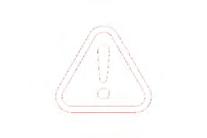


This allows them to palpate portions of the abdomen to feel gas or fluid-distended intestines, intestines impacted with feed material, or intestines displaced within the abdomen. The veterinarian will usually also pass a stomach tube in order to see whether there is any intestinal reflux that flows out of the stomach through the tube. Horses with obstructions or inflammation of their small intestine will have the fluid from the small intestine back up into the stomach, causing reflux. Since horses can’t vomit, it is essential to release the fluid from their stomach with the tube so that their stomach doesn’t rupture.




Sometimes, colic can be treated onfarm with a dose of pain medication and withholding feed. Sometimes, intravenous fluids and repeated sedation are necessary. Less commonly, surgery becomes necessary to remove feed impactions, replace displaced intestines where they belong, or remove dying portions of intestine.
Wounds are another very common emergency for all types of horses. Some large wounds require extensive suturing, and some heal better without suturing. Some tiny wounds are not a big deal, and others are puncture wounds that have introduced infection to a joint and can prompt arthroscopic surgery and intensive care. The best thing to do when





A
your horse gets a wound is to have a veterinarian determine what structures may be affected so that the best treatment plan can be made.
Did you know that if your horse is “choking” it does not mean they are unable to breathe? Horses can get feed material obstructing their esophagus (the tube between their throat and their stomach), which we refer to as “choke.” It does not affect their airway (they can still breathe), but it can still be very distressing, and if not quickly resolved, can lead to pneumonia if they inhale feed particles. Horses with “choke” will often have feed material and saliva draining out of their nostrils and will be unable to eat. Your veterinarian will administer sedation and pass a stomach tube up to the obstruction to resolve it by lavaging it with water.
Have you ever thought about what you would do if you were picking out your horse’s foot and there was a nail embedded in it? Would you get pliers and yank out the nail? It’s very important to know that the right answer is to leave the nail where it is and get a veterinarian out to take an x-ray. If we take an x-ray while the nail is still in place, we can know exactly which structures inside the foot may have been affected and make a plan to treat them. Inside the horse’s foot, a nail can cause infection in the coffin bone, the deep digital flexor tendon, the navicular bursa, the coffin joint, the flexor tendon sheath, and many other structures. Without the x-ray, it is sometimes difficult to know whether the nail was a life-threatening issue warranting surgery or a minor superficial problem.





If you decide that you would like your mare to have a foal, did you know that foaling quickly becomes an emergency if the foal is not born within 30 minutes? If you are foaling your mare out at your place and not at a veterinary hospital, you need to have a plan for hobw to monitor her for foaling and for what you will do if the foal is not positioned normally. In many circumstances, it will take too long for a veterinarian to drive to your farm to be able to save the life of the foal, and the veterinarian may advise you over the phone on ways that you can try to assist your mare. Often, the best thing you can do if you are not able to quickly assist your mare yourself is to put her on a trailer and start driving to a veterinary
clinic, where delivering the foal with the mare under anesthesia is an option. Overall, these are not options to figure out once the mare is having problems; if you decide to foal out a mare at home, have a discussion with your veterinarian about the best contingency plans in case of an emergency.
It is also worth knowing that foals themselves can become an emergency very quickly. If a young foal develops sepsis (an infection throughout their body), it needs to be treated as quickly as possible to save the foal’s life and prevent life threatening complications. Any time a foal shows lethargy, fever, swelling of a joint, or lameness, they should be evaluated as soon as possible by a veterinarian.
Diarrhea (in either a foal or an adult horse) can also quickly become an emergency. Horses can lose a lot of fluid and become dehydrated quite quickly when they develop colitis. Often, this is from a contagious cause, and the horse needs to be isolated during treatment. It’s in circumstances such as those


described above that you need to be an advocate for your horse. If you have taken the time to prepare for an emergency to happen, it’s much more likely that you will have a successful outcome when it does.
Do you have a relationship with a local veterinary clinic that provides emergency services? There is a shortage of veterinarians in North America right
now, and an even more acute shortage of equine veterinarians in many parts of the country. Along with this, some equine veterinarians are setting boundaries by only providing emergency care to active clients, only providing emergency care at certain times of the day, or referring all after-hours emergencies to a referral hospital. If the veterinarian who looks


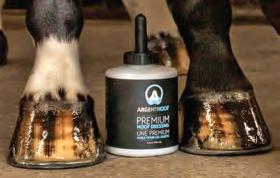
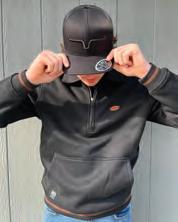

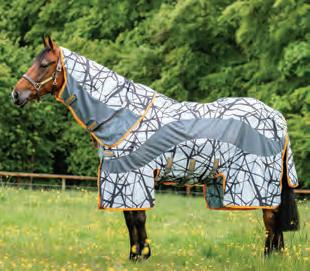





An abdominal tap is done to assess the peritoneal fluid during the workup of a colic that may need surgery.

after your routine veterinary care will not be available in an emergency, do you know who they recommend you call?
If you don’t have a relationship with a veterinary clinic, the time to establish one is before an emergency ever arises. You should know exactly who you are going to call in an emergency and how to reach them. When
you’re making decisions during a crisis, it is very helpful if you have some degree of trust in the professional helping you make those decisions. As well, it can be extremely helpful for the veterinarians treating your emergency to have all the previous medical history on your horse. From a financial perspective, many veterinarians have
Puncture wounds are a common emergency with horses and should be assessed by a veterinarian

instituted a cost differential for non-client after-hours fees compared to the after-hours fees for their regular clients.


Have you looked into whether equine insurance is right for you and your horses? Many people haven’t even thought about insurance as an option but having it might make the difference between being able to treat an emergency such as a surgical colic or an infected joint and having to euthanize the horse. When you compare the coverage on offer by different companies, understand what they are offering so you are comparing apples-to-apples. Many times, people think they have medical coverage for their horse when they truly only have mortality insurance, or even only liability insurance. Know what type of insurance you have and choose a company for medical insurance that will cover diagnostic tests so that you are able to get all the available information needed to make the best choice to treat your horse.
Do you have a plan for how to cover the costs of emergency medical care for your horses? Even if you do have medical insurance, veterinary bills often need to be covered before you are reimbursed by the insurance company, which can be several months down the road. If you don’t have medical insurance, you should establish an emergency fund so that you are able to make decisions that you feel are right for your horse in an emergency without being strictly limited financially.
Do you have a way to reliably transport your horse in an emergency? It is incredibly stressful to need emergency transport and
not be able to find it. If you don’t own a trailer, make sure you have a plan for who you can call to help in an emergency. If you do own a trailer, make sure it’s in good repair and available for use. Although many emergencies can be treated in the field, there are many emergencies that can only be effectively managed in a hospital situation: colic requiring surgery, infected joints requiring arthroscopy, and horses with colitis requiring intravenous fluids and intensive care are just a few examples. As well, depending on where you live, it is becoming more difficult to find reliable emergency care on-farm, and some veterinarians provide haul-in care only after hours.
Have you practiced trailering if your horse isn’t often hauled? If your horse needs to be hauled to a referral hospital with a fractured leg, it’s not a good time to be teaching trailering. You need to make sure your horse is trained to load in a timely fashion, both for the horse’s safety and your own.
Is your horse trained to be safe to work around? This becomes even more important in an emergency, when being able to safely and efficiently give injections and work around the hindlimbs can mean the

difference between life and death for that horse.
Horses are flight animals and can injure themselves in a situation where you couldn’t imagine that they could. They can also get very sick very quickly and need definitive veterinary care to survive. Taking the time to think about
worst case scenarios and having a plan in place for how you would deal with them is one of the best things you can do to ensure a successful future for you and your horses.
> Dr. Crystal Lee is a frequent contributor to this magazine, read her bio on page 94.









Guards
Fights Arthritic
Stimulates
Improves Urinary System




By Monique Noble

Not much can gross out a horse person. We happily pick out hoofs, observe the quality of manure, scrape bot eggs off our horses’ legs, and get a weird sense of satisfaction from an expressed abscess. But ticks… ticks are just nasty.
Ticks have been found in almost every region of Canada and are becoming more prevalent. There are many theories as to why. Migratory birds and animals transport ticks from one area to another, and shorter, less intense winters resulting from climate change contribute to their survival rate. Thank goodness ticks can’t fly! The fact remains that ticks are here and expanding their range in Canada — what can we do?
Often referred to as an insect, ticks are a member of the arachnid family along with spiders, mites, and scorpions. Ticks have four pairs of legs, and no antennae. There are many different types of ticks in Canada but the ones we see most frequently are dog ticks, lone star ticks, and deer ticks (also known as blacklegged ticks, of which there are two types: the black-legged tick



Ticks are found in many areas across Canada, but they prefer wooded areas, tall grasses, and under leaf litter. In urban areas they are found in parks and green spaces.

and the Western black-legged tick.). It is the black-legged tick that can carry Lyme disease, anaplasmosis, and, more frequently seen though previously rare in Canada, babiosis.
We want to control exposure to ticks but preventing tick bites and practicing good horse stewardship can seem at crosspurposes. Long tall grass is a beautiful sight to both horse and horse owner, but it’s a favourite hangout for ticks. Chickens and guinea fowl are fantastic for tick control but not everyone has the desire or ability to keep chickens. Removal of tick habitat and natural pest control are not always options. The best course of action for our equine partners is thorough grooming and monitoring daily, and the application of topical repellents. Repellents are the first line of defense for your horse and


Ticks cannot jump or fly; they can only crawl. They cling to tall grass and foliage and wait for a passerby to latch onto, then they will crawl on their host until they find a likely feeding spot.
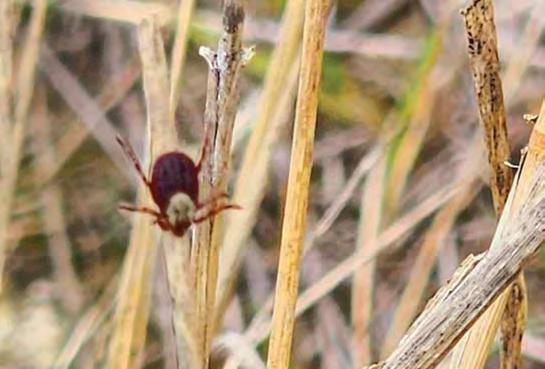
Ticks in a horse’s hair coat when not engorged can feel like a small bump. Investigate any bumps encountered while grooming as they could be a troublesome guest.


Manes are a common place to find ticks. Less common but important to check are the ears and nasal passages as the thin skin of these areas makes for easy feeding grounds.

there are many on the market, including mainstays such as Tick Off and Ultrashield®. But don’t waste your products by spraying the horse’s whole body, concentrate on the legs and underbelly, throatlatch, mane, and tailhead, which are favourite tick hangouts. Try to get product into the leg pits and especially along the backs of legs and behind the fetlock. Don’t apply to the forelock because the product can be carried into the eyes by rain or sweat. Apply tick repellent on the horse’s head by spraying it on a cloth and wiping the cloth around the horse’s muzzle and in and around its ears.
Instructions for home remedies can be found online but unless your horse has chemical sensitivities, stick to products that contain DEET or permethrin. Essential oils such as neem oil can prevent ticks but need to be reapplied every two hours. Diatomaceous earth is used by some people as a dusting treatment but can cause respiratory problems in horses and is not recommended. Tick and flea treatments used on horses and dogs should never be used on cats, as they are potentially toxic to our feline friends.
Even the most diligent prevention methods can be thwarted as ticks are not only opportunistic, they are sticky and adept at hiding. Ticks have tiny hooks at the end of their legs, enabling them to hang on to their host even after a swim, shower, or bath. Common places to find ticks on horses are on the fetlocks, legs, belly, throatlatch, chest, mane, tail, inner legs, and pubic areas.
While grooming your horse it is important to check any unusual bumps as these can indeed be ticks. Ticks don’t always look large and engorged; they only look like that after they have had a blood meal. If you find them before they have started their blood meal they will be flat and easier to remove; at this stage, pick the tick off and dispose of it by either dropping it into a container of rubbing alcohol or sealing it inside a piece of tape or a sealable container.
If you find a tick in its engorged state or at the beginning of its meal, its head will be embedded in its host’s flesh; at this point removal must be done more carefully as squishing it or waiting for it to detach itself is more likely to cause the tick to pass on any diseases it may be carrying. All ticks can transmit diseases, and in some cases multiple diseases in one bite. They can carry and transmit zoonotic diseases such as babesiosis, equine piroplasmosis, ehrlichiosis, anaplasmosis, tularemia, Lyme disease, tick paralysis, and more.
The recommended method of tick removal is as follows:
1. Wear gloves if possible.
2. Use clean, fine-tipped tweezers to grasp the tick as close to the skin’s surface as possible. If using a tick removal tool such as a key, card, or twist, secure the tool in between the tick’s head and body.
Don’t
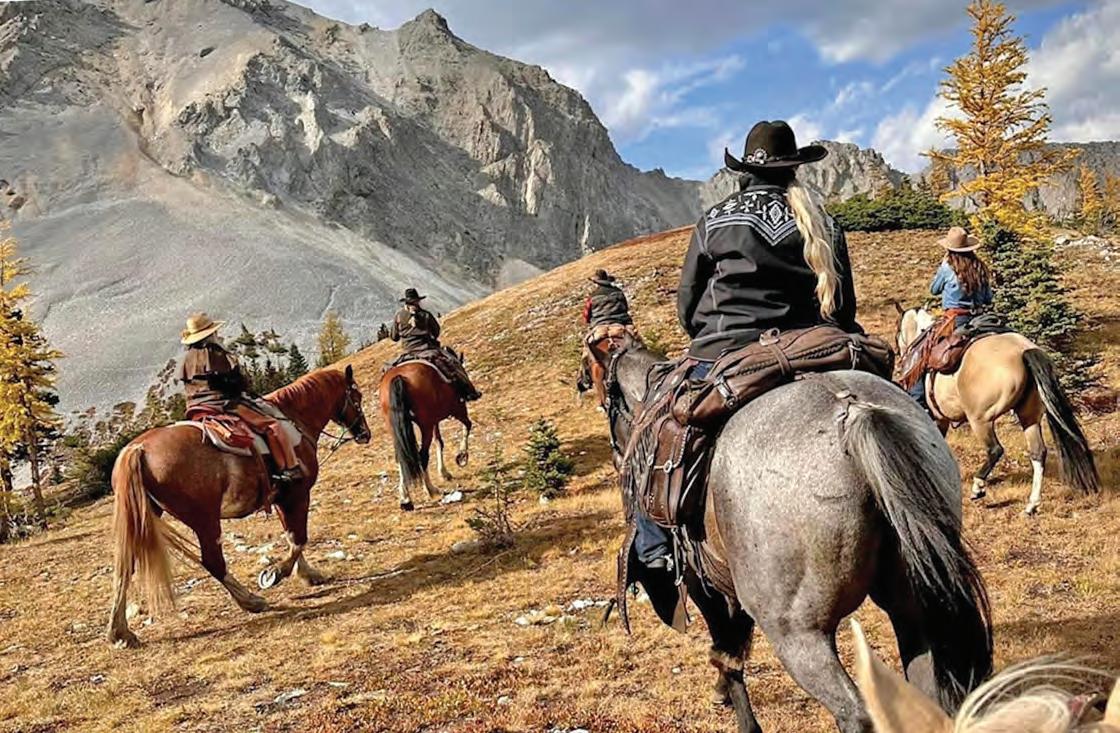
"As a professional horse trainer, Dynamint Equine Leg & Muscle Rub is an important aspect of my program. Dynamint is a natural product that has a cooling effect, it calms tired, sore muscles and rejuvenates horses keeping them feeling their best. I use Dynamint on my horses and myself. The results I have experienced have not been matched by any other product in the market. For long hauls and after hard workouts Dynamint is the only product I use on horse's legs. If you are looking for a product that is safe on skin and delivers results, trust Dynamint Equine Leg & Muscle Rub. Your horse will thank you!"
Jill Barron
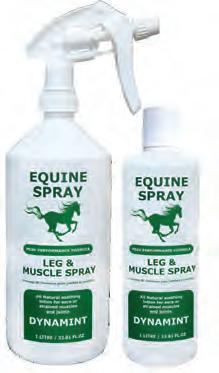
A soothing
All natural soothing lotion for sore or strained muscles and joints.
Available in 1L spray bottle for easy and quick application to larger areas, or a 500ml rub bottle.





Tick infestations when not controlled can cause all sorts of health issues for you and your livestock. Once ticks are in your area, they can be difficult to get rid of. This infestation was seen in an auction horse. This horse was successfully treated but it was a lot of hard, necessary, and disgusting work.
3. Pull upward with steady, even pressure. Don’t twist or jerk the tick; this can cause the mouthparts to break off and remain in the skin. If this happens, remove the mouthparts with tweezers. If you cannot remove the mouth easily with tweezers, leave it alone and let the skin heal.
4. After removing the tick, thoroughly clean the bite area and your hands with rubbing alcohol or soap and water.
5. You may want to preserve the tick for identification or testing purposes. To do this seal the tick inside a clear container or tape to a piece of paper leg-side down using clear tape.
6. Never crush a tick with your fingers. Dispose of the tick by putting in the trash after…
• Putting it in alcohol.
• Placing it in a sealed bag/container.
• Wrapping it tightly in tape.
• Feel free to do all three.
If you have a horse with an infestation of ticks, it is important to get a veterinarian’s advice. They will most likely treat your animal with Cyclence and suggest a deworming protocol. The vet may want to send some of the ticks away for testing and do a blood panel on your horse to test it for a variety of diseases and anemia, which are all possible side effects of a large infestation. Cyclence will kill all the ticks that are on your horse whether they are currently feeding or not, regardless of life cycle. Ivermectin will kill ticks that are currently feeding on your horse. As a

parasite can also carry parasites, Ivermectin will also kill microfilaria (baby worms) attached to the tick.
Unfortunately, it only takes one infected tick to pass on disease. Even if your horse isn’t infested, if you do find a tick it is a good idea to Cyclence and deworm the horse in case of hidden hitchhikers and/or larvae or eggs left behind. Keep a watchful eye on the horse for four to six weeks after the incident. Watch for any signs of bacterial infections around the wound sights. If at any point after being exposed to a tick bite your horse should exhibit a rash, joint pain, fever, lethargy, shortness of breath, swollen fetlocks, lack of coordination, or unwillingness to eat, this could indicate an illness related to a tick bite and you should call your veterinarian immediately.
If you want to be proactive and don’t want to play the waiting game, a preserved tick can be sent away for testing by your veterinarian or privately to rule out any diseases. These tests can be costly but may help your peace of mind in the event you find one on yourself or any of your animals.
Even one tick can cause a huge problem. One female tick can lay 4,000 to 6,500 eggs, after which she dies. The eggs hatch in about 36 to 57 days. The larvae crawl in search of a host and can live up to 540 days without food. Once ticks are established on your property, they can be extremely hard to get rid of.
In addition to animals, remember to check yourself thoroughly for ticks as people are often unaware carriers. It is also advisable to carefully examine any clothing you were wearing while removing ticks and wash it in hot water immediately (ticks can survive a cold or warm water wash) to make sure there is no opportunity for them to spread.
The best defense is a good offence, and as ticks expand their range and become more prevalent, it’s only a matter of time before you or your horse encounter one…tick tock. b



> Monique Noble is a new contributor to this magazine — read her bio on page 94.
RESOURCES
> www.ticktalkcanada.com
> www.tickawarenesscanada.net




How to reduce the risk, recognize the symptoms, and take steps to manage an outbreak.

The bacteria can spread via contaminated equipment such as shared feed tubs, halters, grooming equipment, stall walls, fencing, and even on the hair coat of other barn pets.


Strangles is a highly contagious infection caused by the bacterium, Streptococcus equi (S. equi). It is not an airborne virus. Rather, the bacteria spreads through contact, which could be direct nose-to-nose between horses, or via contaminated surfaces or equipment such as shared halters, lead shanks, cross-ties, feed tubs, stall walls, fencing, clothing, hands, the hair coat from other barn pets, grooming tools, water buckets, and communal troughs.
Although rarely fatal, strangles is a respiratory disease that can make your horse miserable for a few weeks, and recovering horses can shed the bacteria for four weeks or longer. Three to fourteen days is the typical length of time from infection to the manifestation of clinical sign. Swift control measures will help minimize transmission, reduce associated medical expenses, and decrease the duration of facility “lockdown.”
Severe inflammation of the mucosa of the head and throat, often with extensive swelling and rupture of the lymph nodes below and behind the jaw, which can produce large amounts of thick, creamy pus, are classic signs of strangles.

A purulent nasal discharge, which may initially be clear, is a typical symptom of strangles. Once strangles is confirmed, the horse should be isolated for at least four weeks AFTER the resolution of clinical signs.
Still, not all horses will develop enlarged and abscessed lymph nodes. Some will present with only slight nasal discharge, while others may be lethargic, lose their appetite, and have difficulty breathing and swallowing due to lymph node enlargement around the throat area. In very rare circumstances, “bastard strangles” may develop with abscesses in the abdomen, chest or brain; others may develop immunemediated diseases of skin or muscle.
Fever is an initial sign of strangles, and the beginning of a brief window of one or two days before the horse starts shedding

Helping horse owners understand the form and function of the hoof in easy to follow and effective hoof trimming clinics across Canada.


May 9-12 .............Anola, MB
May 23-26 ..........Kindersley, SK
May 30-June 2....Kaslo, BC
June 6-9 ................Winlaw, BC
June 13-16 ............Langley, BC
June 20-23 ...........Courtenay, BC
June 27-30 ...........Squamish, BC
July 4-7 .................Kamloops, BC
July 11-14..............Fort St. John, BC
July 18-21 .............Grande Prairie, AB
July 25-28 ............Olds, AB
August 1-4............Langdon, AB
August 8-11 ..........Balgonie, SK
To curb the spread of strangles, good hygiene is essential, including hand washing with soap immediately after handling horses and their gear.
the bacteria from the nose, contaminating the environment and infecting other horses. Swift isolation and control measures are important.
Good biosecurity practices should be employed both on and off your property. On the farm, these include establishing a twoto three-week quarantine period for new horses arriving, and screening horses for S. equi before or during quarantine after discussing with your veterinarian. Horses that travel should be grouped together in the same barn and paddocks, and equipment (leads, halters, tack, grooming) should not be shared between groups. Use a visitors’ log as part of your access management plan and implement a clean clothes and clean footwear policy for people accessing your facility. Use foot baths to mitigate risk.
Off the property, employ trusted haulers that clean and disinfect their trailers between loads. On arrival at your destination, disinfect your stall before use focusing on high contact areas such as the bars on stall doors and windows. On the grounds, refrain from grazing your horse in communal areas and sharing water troughs. Avoid handling horses that are not in your group and do not let horses have nose-to-nose contact with other horses. Take temperatures and monitor horse health while away and after return.
Immediately isolate horses with signs of strangles. Infected horses should remain in isolation until your veterinarian determines they are no longer infected. Testing should not occur until 30 days after the abscesses have healed, or other clinical signs have resolved.
Stop all horse movement on and off the premises and limit human traffic.
Set up red, yellow, and green zones and coordinate taping of halters, stalls, and equipment with matching colour tape or markers to avoid cross-contamination: red (isolated/infected), yellow (exposed/monitor), green (not exposed). Limit traffic and keep all but essential personnel out of red zones. Put up signs and clearly communicate the infection control measures you are implementing with your staff, service providers, customers, and community.
Monitor diligently. Take temperatures of all horses in the yellow zone twice a day and monitor for signs of infection. Fevers can be cyclical; some horses may develop fevers in the morning, while others may present with a fever in the afternoon.
Cleaning and disinfect. Stalls, trailers, and other areas that have contained horses with strangles should be cleaned of organic debris (manure, discharges, etc.) before being disinfected, as organic debris can deactivate disinfectants, particularly bleach. Prevail™ or Virkon® are the most common products used. It is important to make sure the disinfectant remains on the surface for the appropriate contact time as described on the label.
Practice good hygiene, paying particular attention to hand hygiene. Have staff dedicated to the different zones/horses (one for green, one for yellow, and one for red) but if that is not possible, green horses should be handled first, then yellow, then red, with staff changing clothes and boots or using foot baths before switching zones.
If foot baths are used, boots should be cleaned first with a scrub brush and detergent. Boots should be in contact with the disinfectant for the appropriate contact time listed on the product label. Boot baths should be changed as soon as they appear dirty and at least daily. Common disinfectants include Prevail™, Virkon®, and diluted bleach (1:10 with water). Bleach is particularly deactivated by organic debris so boots etc. must be clean prior to contact. An alternative to a foot bath is to use dedicated rubber boots, which should remain in the zone in which they are used. Use dedicated equipment (pitch forks, shavings forks, wheelbarrows, etc.) for each zone when possible. Coloured electrical tape on the handles can be used to indicate the appropriate zone. If this is not possible, clean and disinfect (using the appropriate contact time) between zones (going from clean to dirty or green to red). S. equi can survive in cold water for weeks and is easily transmitted in water, so don’t used shared water sources. Avoid submerging the end of a water hose in water buckets as you fill them to avoid cross contamination. Curtail environmental survival. S. equi can survive well in certain conditions such as wet and cold conditions. One study found the bacteria can linger in the webbing of polyester halters unless exposed to washing at a scorching 60 degrees C! Rest paddocks/ pastures that have housed infected horses for up to four weeks (depending on if it’s a grazing paddock or exercise paddock) to allow sunlight and dry weather to destroy the bacteria. Consult your veterinarian before administering any medication. Your vet is an excellent resource to help you with infection control measures and provide advice on testing so you can get your life back to normal as quickly as possible.

As the bacteria can survive in cold water for weeks and is easily transmitted in water, shared water can be a source of strangles. Even submerging the end of a water hose in water buckets can spread contamination.
A veterinarian examining a horse that is suspected of having strangles will usually test the horse in one of the following ways. If there is pus draining from the nose or abscessed lymph nodes, they may take a direct swab for S. equi polymerase chain reaction (PCR) (DNA) testing and/or bacterial culture. If the lymph node is large but hasn’t ruptured, the veterinarian may use a needle to aspirate the pus from the lymph node for testing. If there is no nasal discharge or the abscesses haven’t started draining, they


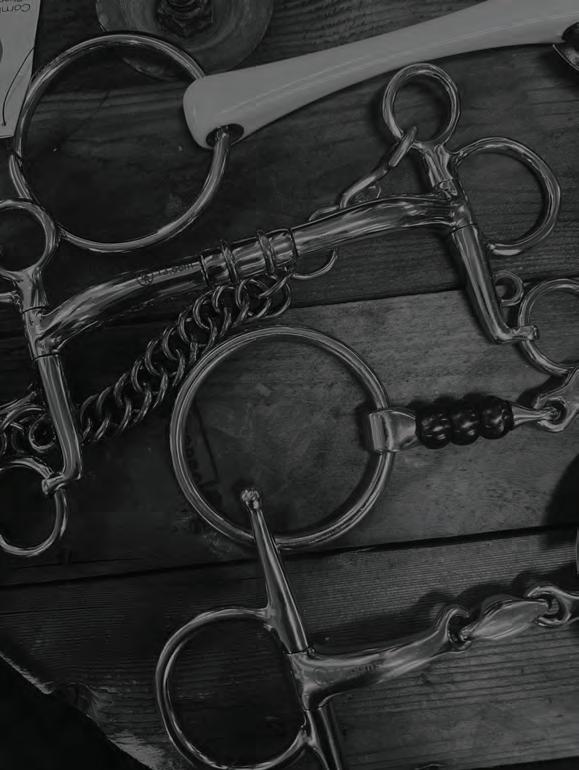
may take a sample from the back of the throat using a very long swab or inserting tubing and infusing fluid to wash the area and catch it as it comes out the nose. Some horses will have to be sedated for these latter procedures. The sample from the back of the throat is generally sent for PCR testing with or without bacterial culture.
Once strangles is confirmed, the horse should be isolated for at least four weeks AFTER the resolution of clinical signs. If the horse is tested too soon after clinical signs have resolved, it is more likely to be positive and increase the costs associated with repeated testing. After this time, it is recommended to test the horse to determine that it has cleared the infection.
The 2018 American College of Veterinary Internal Medicine (ACVIM) Consensus Statement on S. equi infection provides the following science-informed recommendations for determining that a horse is negative for S. equi infection: three negative PCRtested nasopharyngeal swab/lavages one week apart, or a single negative PCR-tested, pooled guttural pouch lavage. Some veterinarians are using a combined guttural pouch/ nasopharyngeal lavage, which is also appropriate.





Carrier horses have had strangles at one point in time and never cleared the infection from their guttural pouches. These horses show no clinical signs of infection and are thought to be significant contributors to the spread of strangles. They generally shed low numbers of bacteria from the nose and may do this intermittently. It is likely that some factors, such as environmental stress, cause these horses to shed more bacteria at certain times leading to an infected horse appearing in the herd. The dynamics of S. equi shedding in carrier horses is still unclear, and it is possible for these carrier horses to live in herds for months or years without a strangles outbreak occurring. The only way to detect these carrier horses is through testing. PCR testing of guttural pouch lavages is the most sensitive way to detect carrier horses. PCR testing of nasopharyngeal swabs/lavages can also be used but may miss horses as it is not as sensitive a technique. Carrier horses should have their guttural pouches evaluated by endoscopy to determine if there are chondroids present (pebbles of pus) and/or pus which would need to be removed. Most often the guttural pouches need to be treated directly with antibiotics to clear the infection.
Testing horses for S. equi should only occur after a comprehensive discussion with the veterinarian about what a positive test will mean for the horse and the facility, and considering the following:
• The availability of isolation areas for positive horses;
• Cost of testing and the possibility for repeated tests and treatment;
• The risk assessment — Is there a significant risk of exposure to S. equi to require testing?
• The risk generally for S. equi infection for the horses on the premises; for example, if they compete; whether they are vaccinated; if you test all horses on the property and clean up any S. equi positives, are you prepared to then test every new horse coming on the property; and your policy about competition horses that come and go.
It is not advisable to vaccinate horses for strangles during an outbreak due to the risk of purpura hemorrhagica (an immunemediated inflammation of the blood vessels in the skin) and confounding signs secondary to vaccination. An exception might be to do “ring vaccination” on large facilities where some barns
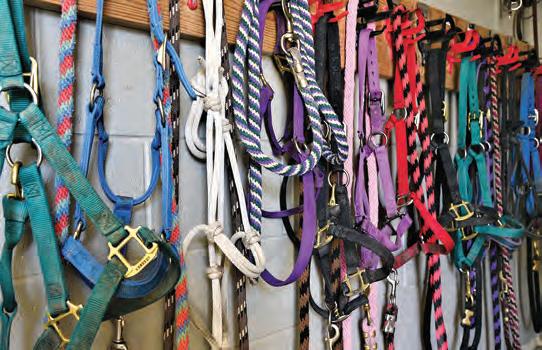

In a recent study, polyester halters underwent testing to evaluate cleaning protocols after contamination with S. equi. The study confirmed that unless exposed to washing at 60 degrees C (140 degrees F), bacteria can linger in the webbing of polyester halters. On the other hand, even without rigorous cleaning, leather appears to poorly support survival of S. equi.
If using foot baths as an infection control measure, boots must first be cleaned with a scrub brush and detergent, as organic debris can deactivate bleach.
are very far away from the affected barn with no possibility of contact. Your veterinarian will help you determine if this is an appropriate decision.
Generally, vaccinating for strangles will reduce the severity of clinical signs if your horse becomes infected with S. equi. It may also limit shedding of the bacterium. There are two forms of vaccine available; an injectable (killed vaccine) and intranasal (modified live vaccine).
Very rarely, horses which have been exposed to S. equi previously and vaccinated with either vaccine may develop purpura hemorrhagica. Performing a streptococcus equi M protein (SeM) antibody titre before vaccination can identify horses at risk of developing this complication. As well, some horses vaccinated with the intranasal vaccine may, in rare circumstances, show mild lymph node swelling after vaccination. The intranasal strangles vaccine should not be administered at the same time as other injections as there is a potential for contamination of those injection sites and subsequent abscessation. After intranasal vaccination, horses may test positive for S. equi by PCR testing for up to 60 days post vaccination. b
RESOURCES
Ontario Animal Health Network, Equine Strangles Resources > www.oahn.ca
More resources and an interactive Biosecurity Risk Calculator are available at > equineguelph.ca
More on access management in Section 7 of the National Biosecurity Standard for the Equine Sector > inspection.canada.ca








To navigate this show gate, the rider wraps her horse around her inside leg to create a nice arc as he follows his nose. Riding through a gate smoothly, without hesitation in the stride or resistance to the aids, could earn a top obstacle score.
...in the schooling ring and in the show ring
By Lindsay Grice, Equestrian Canada coach and judge

Essentially, a gate is a transition from here to there. It’s a transition from one pasture to another, replicated in competition.
Learning to work a gate can be part of your horse’s training transition into a more attentive, patient, and handy partner.
I use gate training as a transition in the rhythm of a schooling session. For example, after canter work, a slower maneuvering task such as a sidepass, backing obstacle, or gate provides a “commercial break.” The value of teaching your horse the steps to work a trail gate is comparable to the benefit of phonics in learning to read. Mastery of maneuvering his body parts and controlling his feet as well as the patience and listening skills your horse will develop will spill over into other dimensions of his training.
Beyond its cross-discipline educational benefit, competing in trail and other obstacle classes is a lot of fun and growing in popularity. As a judge, I assess and score riders working gates in show trail and ranch classes, Mountain Trail, Working Equitation and Extreme Cowboy. The common denominator across disciplines is style — finesse, flow, and efficiency.
3 ESSENTIAL INGREDIENTS
1 PATIENCE
Maneuvering obstacles — gates, sidepassing, and backing obstacles — require slow training, patience, and pausing between steps. Riders tend to find them boring and consequently, many just don’t practice them (until they get to the horse shows). Moreover, horses are inclined to want to get maneuvering obstacles over with. Not because they’re boring, but because they’re scary.
Naturally, a horse initially feels vulnerable while parked close beside a barrier while his rider reaches down to move it. Horses don’t like to feel trapped between the rider’s leg and an impediment to escape. I want my horse to learn that the gate is a happy place to be — a place to catch his breath, not hold his breath. Don’t work on a gate when your horse is fresh. Wait until he’s relaxed in your schooling session and welcoming a break.
Wait between each step until the horse is completely neutral and not anticipating what comes next. Gradually, you can shorten the wait time until it’s no longer visible — the steps become steady, but the pause is still understood. In other words, the horse never initiates a step but instead, waits to be asked.
2 COMMUNICATION CLARITY
Vague cues will only add to your horse’s feeling of vulnerability. Don’t make your horse guess what you want him to do with his feet. As with all training, start with clear distinction between your leg positions and rein signals in the skill acquisition phase. These aids can soften and become more subtle as your horse gets the idea.
3 CONTROL OF THE HORSE’S FEET
Don’t think of “riding through the gate,” but rather, as a sum of the multiple pieces involved. Before my students approach a gate, we have these five pieces firmly in place: turn on the forehand, turn on the haunches, sidepass, step-backward, and


Anticipation is the most common gate issue I see as a judge. As a clinician, a frequent horse puzzle I’m asked to help solve is how to untrain a horse that has learned to do the gate on autopilot. Of course, the best way to prevent an unwanted habit is not letting a groove ever get established. Interrupting a horse’s familiar pattern takes time — waiting in between steps until the horse settles and mixing up the routine. Keeping a horse guessing keeps him interested in his job and his expression fresh.
step-forward. If these movements aren’t deeply learned (working any time, any place, without anticipation), attempting to perform them with a gate in hand stirs up a mess of tension and confusion in a horse.
As a judge, I see tension and confusion at the trail gate more than I’d like at open shows. A competitor enters the trail class “exam” without having studied enough at home. With rusty lateral cues, they’re unable to step closer to the obstacle so they lean over and reach for the rope. The horse is unnerved and backs away as the rider valiantly holds on to the rope. Alas, without a reliable step-forward cue, the horse stays in reverse, the rope stretching more taught as I dictate accumulating penalties to my scribe. Occasionally, I must interrupt — LET GO! — before the gate starts to teeter and topple into a train wreck.
I start green horses or novice riders on a rope gate. It’s pliable and less confining than a solid obstacle. We’ll begin working the gate with the rider’s dominant hand, though of course you’ll need to be able to operate a left- or right-handed gate. That said, in the steps to follow, I have a solid gate in mind.
1 Halt with the gate opening near your leg, close enough that you don’t have to reach for it. Leaning to the side puts you and your horse off-balance, resulting in an unintentional sidestep to rebalance. Reaching may cause your leg to slip into your horse or your rein hand to give unintentional signals as you stretch for the latch. Mixed messages stress horses. Not only that but if you’re off-balance and he spooks away from the gate, you’ll be left near it…in the dirt.




2 Hesitate until your horse is relaxed, then back a few steps, sliding your hand along the top of the gate until your horse’s head is past the gate opening.
3 Open the gate away from you so the horse sees a way through it and discovers that the gate will move.
4 With the gate open, step your horse forward through the opening. Once his shoulders go through, pivot them around the opening with your outside leg at the girth. Eventually, as you refine the process, wrap your horse around your inside leg as you step to create a nice arc as he follows his nose.
5 To close, press your outside leg at the girth to sidepass. Back a few steps to latch the gate.
Mix up the routine to be prepared for whatever type of gate is asked for in competition.
• Sidepass away from the gate to create an opening for a pull gate.
• Work the gate from either side, using either hand to hold and latch it.
• Back through the gate. You will need a confident turn on the forehand to step the hindquarters around the opening.
In competitive show trail classes, one typically finds a rope gate. For ranch horse events, it’s more often a solid gate — wood or metal pipe. In Working Equitation, a solid gate is preferred for the Ease of Handling phase, whereas a rope gate is used in the Speed phase.
Which hand you open the gate with depends on how the pattern is set — to which side of the obstacle the pattern takes you. In Working Equitation, the exhibitor must use the same working hand to negotiate obstacles throughout their pattern. This may necessitate operating the gate with your non-working hand and backing through.
As a rule of thumb, approach the gate in trail classes in the most efficient manner to maintain the flow of the course. Though some ranch competitors choose to demonstrate their horse’s handiness by sidepassing a few steps to the gate, I coach my show trail class competitors to halt directly beside the opening to eliminate unnecessary steps. Working Equitation specifies a perpendicular approach, transitioning downward to the walk between the markers and swinging the horse’s quarters in a smooth turn on the forehand to stop parallel to the obstacle.
As a judge, in all competitive trail-type events I must assess for each obstacle a mark for style, with deductions for errors or penalties.
The maneuvre or obstacle score represents the style or quality of the obstacle execution. A perfect obstacle score for Working Equitation, Mountain Trail, or Extreme Cowboy is 10. A top mark for obstacle execution in show or ranch trail classes is 1 1/2.
• Efficiency means that you don’t let the cows out! Imagine cattle crowding around, waiting for the gate to open and a chance to file through. The opening’s got to be wide enough to avoid catching the rider’s leg and narrow enough for only the equine,
Green horses or novice riders are best started on a rope gate. It’s pliable and less confining than a solid obstacle. Distinction between leg positions is key with green horses. Note this rider’s leg is clearly signaling at the girth to move the horse’s front end around.
not the bovine, to pass through. Efficiency means no wasted steps or extra maneuvering.
• Flow. Riding through a gate smoothly, without hesitation in the stride or resistance to the aids, could earn a top score on an individual obstacle.
• Finesse. Willingness and softness in expression is the ideal. Tension such as gapping the mouth in response to bit contact or counter-bending in response to a neck rein cue will result in a lower score. Anything that makes the maneuvre look ugly — swishing tails, pinned ears, or rushed movements — will earn the lowest obstacle marks.
Check your equine association’s rule book for the full penalty list, but here are some highlights.
In Working Equitation, hitting the gate, inattentiveness while the rider latches and unlatches, or stepping back will earn a 4.5 or less out of a possible perfect 10.
In show and ranch trail classes, penalties are more specific.
• Backing, balking, or bucking — Any time your horse says “no,” you’ll have a five-point penalty deducted.
• Snacking on the foliage Every nibble at the flower decorations or equipment is a one-point error.

• Hitting the standard — A light tick is a half-point penalty; a good clunk is one point; and actually shifting the obstacle or the decorations will cost you three points.
• Letting go of the gate Five points are deducted. (Plus, the cows escape — and ultimately, that’s the point of the whole exercise).
> Lindsay Grice is a frequent contributor to this magazine, read her bio on page 94.


By Jec A. Ballou
While it is widely used for gentling young horses and teaching basic skills, groundwork also offers the possibility for a notable amount of conditioning. When consistently and strategically practiced, it can improve muscle tone, basic metabolic function, and neuromuscular patterns. Increasingly, evidence has shown that a large percentage of muscle activity can be maintained in non-ridden horses when groundwork sessions are performed six or more times per week.
Here are two groundwork workouts from my new book 33 Strength and Fitness
Workouts for Horses that I find particularly effective.
NOTE: Page numbers in the workout descriptions refer to pages of the book where full exercises are described.
DURATION: Approximately 35 minutes
KEY EXERCISES USED: Back-Up (p. 27), Turn-on-the-Forehand (p. 32), Turn-on-the-



Haunches (p. 33), Tight Serpentines (p. 34)
BENEFITS: This session can be performed pretty much anywhere with moderately level ground. It can help loosen areas where horses often hold tension. These gentle maneuvres can activate the postural muscle system (sensory pathways that transmit information to the central nervous system, thus controlling posture).
HOW-TO:
1 For 10 minutes: Walk, making speed changes every 15 strides (slow,
Back up
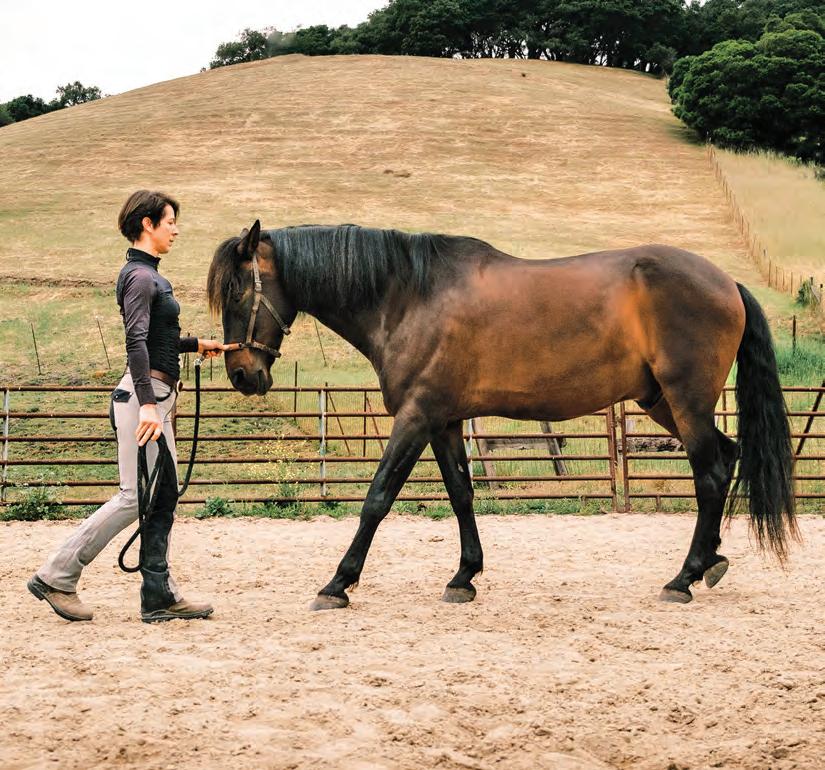
medium, very fast).
2 Back the horse up 30 steps (Photo A).
3 For 2 minutes: Walk-to-stop transitions (every 10 steps); repeat.
4 Turn-on-the-Forehand 3 times in each direction (Photo B).
5 For 2 minutes: Easy jog on straight lines and big circles.
6 Turn-on-the-Haunches 3 times in each direction (Photo C).
7 For 2 minutes: Walk briskly.
8 Repeat Steps 4 through 6.























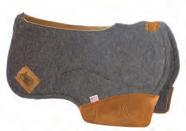




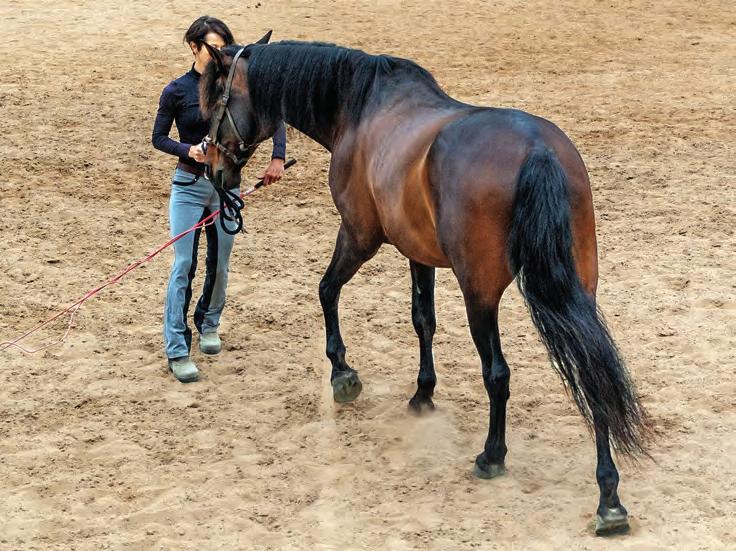
9 For 2 minutes: Walk Tight Serpentines (Photo D).
10 For 30 seconds: Lateral Yield in each direction. Repeat twice.
11 Finish with your favorite stretches, liberty play, or turnout for extra movement.
TIP: Aim to perform a full 360-degree turn unless your horse is just learning, healing from a lower limb or hoof injury, or particularly stiff, in which case perform a 180-degree turn.
DURATION: Approximately 25 minutes
KEY EXERCISES USED: Pre-Ride Circles (p. 35), Raised Uneven Poles (p. 36), Back-Up (p. 27), Tight Serpentines (p. 34)
BENEFITS: Combining different lines of travel, transitions, and ground poles, this simple routine is one to revisit frequently.
Be sure to have your ground poles set up ahead of time; you can perform reps either by setting up poles on one side of a large longe circle or by hand-walking back and forth across them. Choose the longe option if you have extra time; your horse spends more time walking with this one.
HOW-TO:
1 For 3 minutes: Perform Pre-Ride Circles continuously, alternating each direction (Photo E).
2 Walk over Raised Uneven Poles for 20 reps (Photo F).
3 For 3 minutes: Walk Tight Serpentines (Photo D).
4 For 4 minutes: Walk-to-Jog Transitions (every 20 steps). Ideally, jog alongside your horse on mostly straight lines.
5 Repeat Raised Uneven Poles for 10 reps (Photo F).
6 For 3 minutes: Walk 20 steps, stop, back up 6 to 8 steps (Photo A); repeat sequence.
7 Finish with 5 minutes of easy jogging. TIP: Be sure you do not tilt the horse’s head toward you when crossing ground poles. We want the horse’s head and neck to remain very straight over poles. b
This excerpt from 33 Strength and Fitness Workouts for Horses is reprinted with permission from Trafalgar Square Books (TrafalgarBooks.com).
> Jec A. Ballou is a regular contributor to this magazine — read her bio on page 94.
> Read our review of 33 Strength and Fitness Workouts for Horses on page 96.
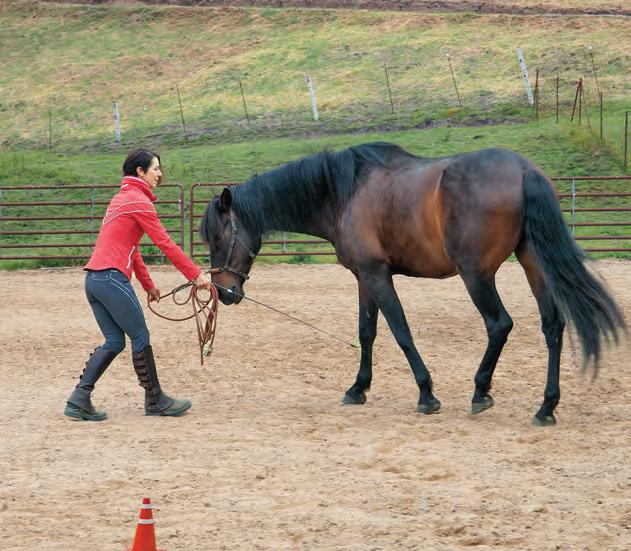












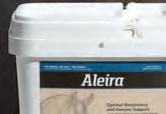


















































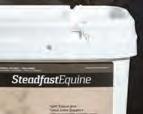




At Arenus, we believe in solutions not just supplements. The best solutions resolve the issue and prevent future problems.
At Arenus, we believe in solutions not just supplements. The best solutions resolve the issue and prevent future problems.
This is why I founded Arenus Animal Health. To offer long term solutions for the everyday health challenges that horses face.
This is why I founded Arenus Animal Health. To offer long term solutions for the everyday health challenges that horses face.
As a practicing veterinarian, I’ve spent many sleepless nights tending to colicking horses and decided there must be a better way to support these recurrent colic cases long term. After much research and careful attention to formulas, the Assure product family was introduced. Since that time over a decade ago, veterinarians across the United States have come to trust the Assure products to solve their toughest digestive cases.
As a practicing veterinarian, I’ve spent many sleepless nights tending to colicking horses and decided there must be a better way to support these recurrent colic cases long term. After much research and careful attention to formulas, the Assure product family was introduced. Since that time over a decade ago, veterinarians across the United States have come to trust the Assure products to solve their toughest digestive cases.
Most supplement companies are created without research or simply built on the grounds of other s’ ingredient research. Arenus Animal Health offers an exclusive line of unique products, extensively researched and clinically proven in their final form to offer lasting solutions to common health concerns.
Most supplement companies are created without research or simply built on the grounds of other s’ ingredient research. Arenus Animal Health offers an exclusive line of unique products, extensively researched and clinically proven in their final form to offer lasting solutions to common health concerns.
Every product, as with every effort of Arenus Animal Health, serves the singular purpose of supporting better, more complete health and wellness through nutritional science. Our philosophy is grounded in the thought that more is not always better. If you’re feeding a large cocktail of daily supplements to your horse, then something is wrong with the program or the supplements themselves. Many horses, particularly performance horses, will benefit from supplementation. However, you need to be critical about the supplements you’re giving your horse.
Every product, as with every effort of Arenus Animal Health, serves the singular purpose of supporting better, more complete health and wellness through nutritional science. Our philosophy is grounded in the thought that more is not always better. If you’re feeding a large cocktail of daily supplements to your horse, then something is wrong with the program or the supplements themselves. Many horses, particularly performance horses, will benefit from supplementation. However, you need to be critical about the supplements you’re giving your horse.
please let















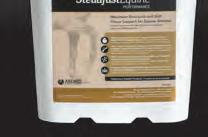








At Arenus, we don’t bring on new supplements to fill a catalog or sell more products. Our line of supplements is limited to those that provide optimum health and serve a purpose in solving a problem. Our products contain the highest formulation technology, the best ingredients, and proven researched results. For that reason, you will find simple, straightforward ingredients and a product lineup designed to work with your overall care program to promote long-term health and wellness.
At Arenus, we don’t bring on new supplements to fill a catalog or sell more products. Our line of supplements is limited to those that provide optimum health and serve a purpose in solving a problem. Our products contain the highest formulation technology, the best ingredients, and proven researched results. For that reason, you will find simple, straightforward ingredients and a product lineup designed to work with your overall care program to promote long-term health and wellness.
We guarantee that our products will help with the major challenges they are formulated to address. Whether it’s for digestive, reproductive, respiratory, structural, or overall health, our products simply work. Try them for yourself. If your horse isn’t healthier or you are not satisfied for any reason, just give our team a call. We will not only be happy to personally help you figure out a better solution for your horse, but we will also take the product back and give you a full refund.
We guarantee that our products will help with the major challenges they are formulated to address. Whether it’s for digestive, reproductive, respiratory, structural, or overall health, our products simply work. Try them for yourself. If your horse isn’t healthier or you are not satisfied for any reason, just give our team a call. We will not only be happy to personally help you figure out a better solution for your horse, but we will also take the product back and give you a full refund.
At Arenus we’ve dedicated ourselves to developing products that actually prevent and resolve the most challenging health issues that horses face. We look forward to working with you to enhance your animal’s wellness and longevity.
At Arenus we’ve dedicated ourselves to developing products that actually prevent and resolve the most challenging health issues that horses face. We look forward to working with you to enhance your animal’s wellness and longevity.
Sincerely,
Sincerely,
Jay Altman, DVM President, Arenus Animal Health
Jay Altman, DVM President, Arenus Animal Health
In working to bring the Assure line of products to Canada, it was discovered that the Assure name had been registered to another company. So, Canada gets the whole Assure line of digestive aids but under the new name Secure. The Secure products will bring the same great results with the same great guarantees as Assure.
SECURE ASSURE
Colic remains the number one killer for horses. Modern veterinary medicine has reduced and nearly eliminated colic caused by parasite infestations. Advancements in diagnostics, treatment and surgical methods have greatly improved the lives of horses suffering from colic episodes. However, with all these advancements, little has been done to address the management of stress that today’s horses suffer. Stress comes in many forms for our horses. Feed schedules, show schedules, training and exercise, separation from friends and everyday life in stalls and confinement all contribute to stress. For many horses this leads to varying degrees of digestive disturbance, leaky gut or even inflammatory bowel disease or colitis. These conditions are at epidemic levels among horses today. The worst part is that many riders are unaware their horses are even suffering. Digestive disturbance symptoms are too often dismissed because they’ve sadly become the norm. Bad attitudes, cinchy horses, difficult training and frequent bad performance days are all indicators of poor digestive health. Even overt symptoms like poor body condition and diarrhea get overlooked. It’s time that we started looking out for our horses and offered them the relief they deserve.
THE SECURE SYSTEM SOLUTION
The Secure System has become a staple for veterinarians across the country in the fight against tough digestive and gastric issues. The stressful challenges that horses face has made it necessary to not only resolve digestive health problems, but to prevent issues and maintain long term health. Today more than ever our horses need digestive maintenance and support throughout their lives. They need the help of a great digestive support program. The Secure System addresses these modern day challenges for optimal health, comfort and enhanced performance.
The Assure/Secure products were developed with a different approach than other digestive supplements. The goal was to provide the best support to all portions of the digestive tract by adjusting the physiologic disturbances that are the root cause. There is no pharmaceutical product that can achieve this goal, nor a single supplement ingredient that comes close. By combining all of the right ingredients in just the right amount and then utilizing our proprietary Gastrointestinal Stabilizing Technology (GST) to produce an enteric coated delivery system we are able to effectively reverse the causes of GI disturbance. Reducing acidity, improving enzyme digestive function, stabilizing the hind-gut microflora, reducing inflammation and accelerating colonocyte repair and regeneration are all part of the functions of each and every Secure product. Not only have the products been extensively researched, but they have been awarded patents for reducing recurrent colic, reducing ulcers, resolving diarrhea and improving GI motility. Secure provides the most complete and effective method to resolve digestive disturbance and provide a digestive maintenance program that will keep your horses healthy and “happy”.
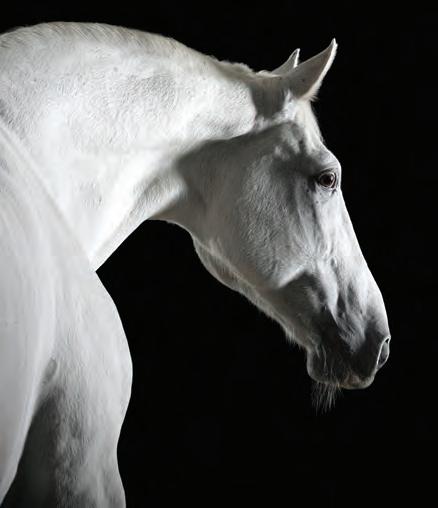
“I am amazed at the difference that I have seen in my horses on Assure Guard Gold, they are feeling better and performing better. I recommend Assure Guard Gold to anyone and everyone, even if their horses do not have diagnosed ulcer issues the GI improvements make a remarkable difference. GI health is so important to the overall health of the horse that the long-term benefits are tremendous!”
Laura Chapot
Professional Grand Prix
Show Jumper, Arenus Ambassador

Our horses lead stressful lives. Their genetics dictate they live free, roam large areas, graze 20 hours a day, and have established position in the “pecking order” of their herd. In captivity, our horses live in a confinement management system, are fed intermittent meals, and are often separated from other horses. Although there have been many advancements in horse care, it has been a constant struggle to address and manage the stress today’s horses suffer. Feed schedules, show schedules, training and exercise, separation from friends and everyday life in stalls and confinement all contribute to stress.
Our horses lead stressful lives. Their genetics dictate they live free, roam large areas, graze 20 hours a day, and have established position in the “pecking order” of their herd. In captivity, our horses live in a confinement management system, are fed intermittent meals, and are often separated from other horses. Although there have been many advancements in horse care, it has been a constant struggle to address and manage the stress today’s horses suffer. Feed schedules, show schedules, training and exercise, separation from friends and everyday life in stalls and confinement all contribute to stress.
Several studies have been conducted on the effect of stress on the horse. However, very few have focused on the influence of stress on digestive health. They often focus on heartrate, cortisol levels, or reproduction, which although important, fail to address one of the main systems most influenced by stress, digestion. Many times, we recognize this stress as acute or chronic diarrhea, weight loss and poor condition, or behavior changes. Horses with these conditions are living in a state of constant digestive disturbance and consequently predisposed to suffer from acute or recurrent colic episodes. Even a small amount of additional stress such as a change in temperature or a low water trough can tip these individuals into a state of digestive distress.
Several studies have been conducted on the effect of stress on the horse. However, very few have focused on the influence of stress on digestive health. They often focus on heartrate, cortisol levels, or reproduction, which although important, fail to address one of the main systems most influenced by stress, digestion. Many times, we recognize this stress as acute or chronic diarrhea, weight loss and poor condition, or behavior changes. Horses with these conditions are living in a state of constant digestive disturbance and consequently predisposed to suffer from acute or recurrent colic episodes. Even a small amount of additional stress such as a change in temperature or a low water trough can tip these individuals into a state of digestive distress.
You may be asking, if these issues are so prevalent, why haven’t more studies been performed to better understand this relationship? One key component is access to the affected area. As many of us have experienced firsthand, it is extremely difficult to image or enter the hindgut due to the horse’s anatomy, whether in cases of emergency or as a diagnostic tool. Consequently, with the development of the 3-meter endoscope, most of the studies involving digestive health have centered around gastric ulcers, a more easily accessible area. Work has been done observing the influence of psychological stress such as training and showing on gastric ulcer formation. Although the stomach is quite important it is still only a small portion of the total digestive system.
You may be asking, if these issues are so prevalent, why haven’t more studies been performed to better understand this relationship? One key component is access to the affected area. As many of us have experienced firsthand, it is extremely difficult to image or enter the hindgut due to the horse’s anatomy, whether in cases of emergency or as a diagnostic tool. Consequently, with the development of the 3-meter endoscope, most of the studies involving digestive health have centered around gastric ulcers, a more easily accessible area. Work has been done observing the influence of psychological stress such as training and showing on gastric ulcer formation. Although the stomach is quite important it is still only a small portion of the total digestive system.
Unlike the horse, the human digestive tract is more easily accessible, allowing for the use of many new technologies, including Positron Emission Tomography (PET) and Functional Magnetic Resonance Imaging (FMRI), helping physicians to better understand the causes behind many gastrointestinal (GI) diseases. These technologies have led many physicians to a shift in approach, from merely managing the symptoms to treating the root cause of the disease and its predisposing influences. New technologies have made it possible to classify all the GI diseases in humans by location and better understand the underlying causes of disease, leading to a new term Functional Gastrointestinal Disorders (FGID.)
Unlike the horse, the human digestive tract is more easily accessible, allowing for the use of many new technologies, including Positron Emission Tomography (PET) and Functional Magnetic Resonance Imaging (FMRI), helping physicians to better understand the causes behind many gastrointestinal (GI) diseases. These technologies have led many physicians to a shift in approach, from merely managing the symptoms to treating the root cause of the disease and its predisposing influences. New technologies have made it possible to classify all the GI diseases in humans by location and better understand the underlying causes of disease, leading to a new term Functional Gastrointestinal Disorders (FGID.)
Even though these new technologies are not available to the horse, we can still use the components of FGID in humans to better understand equine digestive disorders. There are many similarities between FGID in humans and horses. Both involve abnormal motility and inflammation. There is also a connection between the nervous and digestive systems, creating a negative feedback loop, often the cause of digestive disturbances such as hindgut inflammation and possibly even colonic ulcers. In the horse these FGIDs may start out small with weight loss or poor performance, but if left untreated can, over time, develop into ulcers, chronic and acute diarrhea, colitis, or even colic.
Even though these new technologies are not available to the horse, we can still use the components of FGID in humans to better understand equine digestive disorders. There are many similarities between FGID in humans and horses. Both involve abnormal motility and inflammation. There is also a connection between the nervous and digestive systems, creating a negative feedback loop, often the cause of digestive disturbances such as hindgut inflammation and possibly even colonic ulcers. In the horse these FGIDs may start out small with weight loss or poor performance, but if left untreated can, over time, develop into ulcers, chronic and acute diarrhea, colitis, or even colic.
But how does this process start? There are many different factors that can lead to hindgut disfunction including intermittent meals, sand irritation, antibiotics, NSAIDs, and large grain meals. These elements can lead to a buildup of lactic acid, altered motility and the death of beneficial hindgut microflora. Together, these negative effects merge leading to bacterial overgrowth, a change in mucosal secretions, and mucosal inflammation resulting in colitis. Underneath these changes are the everyday stressors our horses endure; confinement, trailering, separation, and the stress of performance and training all feed into this cycle, intensifying the underlying GI disorder.
But how does this process start? There are many different factors that can lead to hindgut disfunction including intermittent meals, sand irritation, antibiotics, NSAIDs, and large grain meals. These elements can lead to a buildup of lactic acid, altered motility and the death of beneficial hindgut microflora. Together, these negative effects merge leading to bacterial overgrowth, a change in mucosal secretions, and mucosal inflammation resulting in colitis. Underneath these changes are the everyday stressors our horses endure; confinement, trailering, separation, and the stress of performance and training all feed into this cycle, intensifying the underlying GI disorder.
This cycle can greatly alter GI function, not only affecting performance and overall condition but leading to various disorders including Leaky Gut Syndrome.
This cycle can greatly alter GI function, not only affecting performance and overall condition but leading to various disorders including Leaky Gut Syndrome.
Within traditional management practices the changes needed to reverse this stressful cycle are difficult and at times impossible to implement. Lack of real estate and the move of horse owners to more suburban areas limit the ability for the horse to live in its natural state, on pasture. Some changes can be made to their diet such as feeding less concentrate, higher quality and free choice forage, as well feeding more meals per day. Changing training and trailering routines may also help to reduce everyday stressors. However, these changes alone may not be enough to improve the horse’s stress level and mitigate its effect on their digestive health.
Within traditional management practices the changes needed to reverse this stressful cycle are difficult and at times impossible to implement. Lack of real estate and the move of horse owners to more suburban areas limit the ability for the horse to live in its natural state, on pasture. Some changes can be made to their diet such as feeding less concentrate, higher quality and free choice forage, as well feeding more meals per day. Changing training and trailering routines may also help to reduce everyday stressors. However, these changes alone may not be enough to improve the horse’s stress level and mitigate its effect on their digestive health.
Incorporating a high-quality digestive aid, such as Secure Guard Gold, into your feeding program is the best or only solution to stabilizing the negative effects caused by the plethora of stressors your horses encounter on a regular basis. Secure Guard Gold provides the most complete and effective method to resolve digestive disturbance and provide support to the entire digestive tract from the stomach to the hindgut, helping your horse face daily digestive disturbances and look and feel his or her best.
Our position meals, struggle from Several on the loss consequently temperature You One the of the area. Although Unlike Emission behind the to classify Functional Even understand motility often may diarrhea, But sand death secretions, confinement, disorder.
Incorporating a high-quality digestive aid, such as Secure Guard Gold, into your feeding program is the best or only solution to stabilizing the negative effects caused by the plethora of stressors your horses encounter on a regular basis. Secure Guard Gold provides the most complete and effective method to resolve digestive disturbance and provide support to the entire digestive tract from the stomach to the hindgut, helping your horse face daily digestive disturbances and look and feel his or her best.

Starter/Dispensing Pack Available for Veterinarians


FAST DIGES TIVE AILMENT RELIEF: Secure Guard Gold packs a powerful punch and delivers fast digestive conditioning. Many owners see results in less than one week!
FAST DIGES TIVE AILMENT RELIEF: Secure Guard Gold packs a powerful punch and delivers fast digestive conditioning. Many owners see results in less than one week!
FAST DIGES TIVE AILMENT RELIEF: Secure Guard Gold packs a powerful punch and delivers fast digestive conditioning. Many owners see results in less than one week!
ENHANCED PERFORMANCE AND WELLNESS: You don’t know how much of your horse you’ve lost to digestive health issues until you’ve addressed the problem. Having a calm and happy digestive system keeps your horse at the top of their game.
ENHANCED PERFORMANCE AND WELLNESS: You don’t know how much of your horse you’ve lost to digestive health issues until you’ve addressed the problem. Having a calm and happy digestive system keeps your horse at the top of their game.
ENHANCED PERFORMANCE AND WELLNESS: You don’t know how much of your horse you’ve lost to digestive health issues until you’ve addressed the problem. Having a calm and happy digestive system keeps your horse at the top of their game.
TOTAL DIGESTIVE SUPPOR T: Secure Guard Gold works to support the entire digestive tract from the stomach through the hindgut. You can trust that your horse’s total digestive health is being supported for optimal function.
TOTAL DIGESTIVE SUPPOR T: Secure Guard Gold works to support the entire digestive tract from the stomach through the hindgut. You can trust that your horse’s total digestive health is being supported for optimal function.
TOTAL DIGESTIVE SUPPOR T: Secure Guard Gold works to support the entire digestive tract from the stomach through the hindgut. You can trust that your horse’s total digestive health is being supported for optimal function.
ALL-IN-ONE DIGES TIVE AID : A single ingredient won’t fix a horse’s digestive system. It takes the right combination to ensure proper digestive health. Secure Guard Gold combines our proven pairing of Secure Guard and Secure Plus into an all-in-one digestive aid. It’s the only product on the market that blends the quality ingredients necessary for a complete, daily solution.
ALL-IN-ONE DIGES TIVE AID : A single ingredient won’t fix a horse’s digestive system. It takes the right combination to ensure proper digestive health. Secure Guard Gold combines our proven pairing of Secure Guard and Secure Plus into an all-in-one digestive aid. It’s the only product on the market that blends the quality ingredients necessary for a complete, daily solution.
ALL-IN-ONE DIGES TIVE AID : A single ingredient won’t fix a horse’s digestive system. It takes the right combination to ensure proper digestive health. Secure Guard Gold combines our proven pairing of Secure Guard and Secure Plus into an all-in-one digestive aid. It’s the only product on the market that blends the quality ingredients necessary for a complete, daily solution.
This patented and veterinary approved supplement provides a powerful digestive support solution for enhanced performance and conditioning. Our proprietary psyllium process and special enteric coated pellets ensures delivery of beneficial microbes and ingredients. It addresses common ailments like colic, ulcers and more.
This patented and veterinary approved supplement provides a powerful digestive support solution for enhanced performance and conditioning. Our proprietary psyllium process and special enteric coated pellets ensures delivery of beneficial microbes and ingredients. It addresses common ailments like colic, ulcers and more.
This patented and veterinary approved supplement provides a powerful digestive support solution for enhanced performance and conditioning. Our proprietary psyllium process and special enteric coated pellets ensures delivery of beneficial microbes and ingredients. It addresses common ailments like colic, ulcers and more.




SOOTHING ULCER RELIEF: Ulcer treatments can wreak havoc on any horse by throwing off the normal balance of the digestive system. Secure Guard soothes the system and is patented to ameliorate ulcers to keep your horse feeling healthy and comfortable.
IMPROVED HEALTH AND OVERALL WELLNESS: Any digestive issue can disrupt your horse’s performance and comfort. Cinchy and irritable horses often have underlying digestive health problems. Ulcers are painful and make travel, training and riding a nightmare for your horse. Having a calm and happy digestive system keeps your horse relaxed and focused.
WHOLE DIGESTIVE SUPPOR T: Secure Guard works to support the entire digestive tract from the stomach through the hindgut where additional gastric conditioning is required.
FLEXIBLE, TA R GETED COVERAGE: Use Secure Guard daily for cost-effective maintenance of difficult gastric problems.

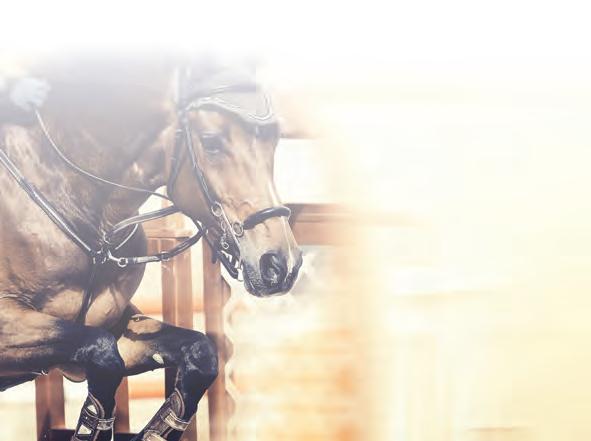


64 equine veterinarians and owners throughout the United States volunteered 144 horses with challenging gastrointestinal disorders to be enrolled in a research trial using the commercially available and patented Secure System. The cases were chronic or recurrent and trial periods were variable and limited for each particular digestive disorder. The trial established expectations for resolution within these limited feeding periods.



100% of horses with recurrent colic had shown a decrease in frequency of episodes.
Horses saw an average of 90% fewer colics within the initial treatment period.
80% of horses with chronic diarrhea were fully resolved or improved in 30 days.
81% of horses suspected with gastric ulcers were resolved or improved in 60 days.
100% of horses with sand accumulation were resolved or improved in 45 days.
94% of horses with poor body condition or weight loss were resolved or improved based on desired weight in 60 days.
Treatment during a relatively short term research trial has shown The Secure System of digestive aids to be excellent support products for both challenging digestive cases as well as regular daily support with proper dosing and duration.
Improvement and resolution has been seen in all forms of digestive health issues including horses with chronic gastrointestinal disorders, particularly recurrent colic, chronic diarrhea, weight loss, and motility disturbances.
Reference: [1] Brendemuehl JP, Altman J, Kopp K, Blikslager A. A multi-center clinical trial utilizing a combined probiotic, prebiotic and psyllium product for the management of chronic gastrointestinal disorders (diarrhea and colic) in clinically affected horses. 2010; Novus Nutritional Brands, LLC.
UR COLIC COVERAGE PRODUCT GU ARANTEE
Up to $15,000 in coverage
Coverage for horses with PRIOR HISTORY OF COLIC*
Coverage for horses with one abdominal surgery
Coverage for multiple colic incidents
MEDICAL and SURGICAL colic coverage
Coverage while horses are TRAVELING INTERNATIONALLY*
PURCHASING directly through Arenus, veterinarians or veterinary clinics for program eligible products
NO AGE RESTRICTIONS once horses are weaned
NO LIMIT on the number of horses an owner can enroll
Coverage for LEASED HORSES
*Some restrictions and requirements may apply.

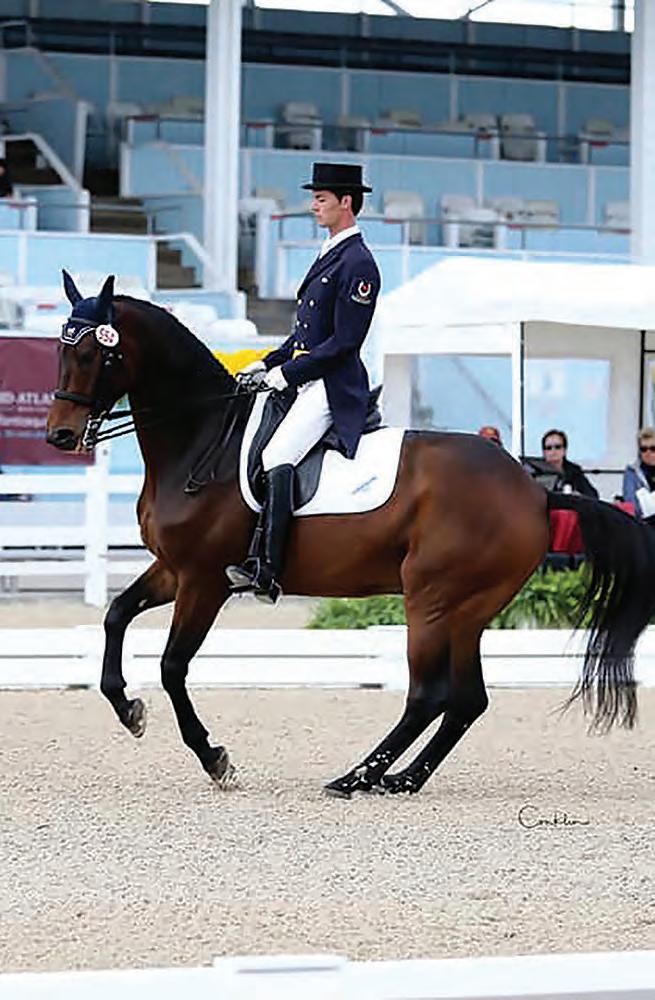

Note:

David Ziegler
Arenus Ambassador


“Aleira’s use as a therapy in both acute and chronic cases has impressed me to the degree that it has become a go to product in my practice and one that I highly recommend. In EIPH, IAD and severe dermatitis cases, Aleira has been a great success as an adjunctive therapy. A grand prix jumper I worked with who suffered from severe, chronic EIPH on a daily basis, showed marked clinical improvement after 45 days on Aleira. Other therapies and treatments had been unsuccessful in this horse. This is one of the many cases where I have witnessed significant improvement while using Aleira.”
Meg
Miller-Turpin DVM, DACVIM
When it comes to Omega-3 products, not all are created equal. This is because not all Omega-3s contain DHA, one of the most beneficial, natural Long Chain Omega-3 Fatty Acids. DHA provides advanced cellular support for reproductive, respiratory and immune health.
Omega-3 supplements commonly source their Omega-3 Fatty Acids from low-DHA fish oil or non-DHA flaxseed. These sources do little to support your horse’s respiratory and immune health. Fish oil also exposes horses to the risk of heavy metal toxicity. Flaxseeds, although vegetarian, don’t provide the right type of Omega-3 Fatty Acids to optimally support respiratory and immune functions, yet can be of benefit to other body systems.
Our Omega-3 products are made from the same, safe algae-derived DHA used in human infant formula. As herbivores, horses are able to naturally absorb this bioavailable, algal-DHA for maximum health benefits. This is why we use it as the base of our respiratory and reproductive health supplements. Aleira is a unique blend of algal-DHA, antioxidant-rich mushrooms, vitamin C and MSM. This effective combo addresses inflammation and immune responses for horses with a range of respiratory issues.
Stall confinement. Tighter living quarters. Travel and trailering. Indoor exercise and dusty arenas.
All of these factors have led to a significant increase in allergic reactions and low level respiratory disease. More horses than ever before show symptoms of low level cough, drippy noses and low level breathing difficulties due to the early effects of airway inflammation. These horses need daily support instead of a medical treatment alone.
Even when it comes to severe respiratory disease issues such as Heaves or Inflammatory Airway Disease (IAD), anti-inflammatories and steroids are not always the best answer. Like a band-aid they offer a quick fix and at times are very necessary, but often don’t get to the root of the problem. Cellular support addresses the underlying issue and offers consistent, daily maintenance.
Years of research by our veterinarians and nutritionists have resulted in an algal-DHA based formula that makes a dramatic difference in horses with breathing and allergy challenges. Our formula can also be safely used in conjunction with traditional treatments. In many cases, horses are able to be supported on Aleira alone. If your horse is a bleeder or struggles with other respiratory or immune problems, then Aleira is the answer you’ve been waiting for.


IMPROVED PERFORMANCE: Addressing airway challenges keeps your horse comfortable and at the top of their game. Aleira offers effective support for bleeders and horses with respiratory or immune responses. Aleira combats performance limiting conditions like Recurrent Airway Obstruction (RAO), Inflammatory Airway Disease (IAD), allergies, hives and dermatitis.
IMPROVED PERFORMANCE: Addressing airway challenges keeps your horse comfortable and at the top of their game. Aleira offers effective support for bleeders and horses with respiratory or immune responses. Aleira combats performance limiting conditions like Recurrent Airway Obstruction (RAO), Inflammatory Airway Disease (IAD), allergies, hives and dermatitis.
NON-MEDICINAL ALTERNATIVE: Powerful respiratory support without the negative side effects of traditional treatments like steroids. Safe for horses that are sensitive to traditional medications. In many cases, horses using Aleira are able to be supported on Aleira alone!
NON-MEDICINAL ALTERNATIVE: Powerful respiratory support without the negative side effects of traditional treatments like steroids. Safe for horses that are sensitive to traditional medications. In many cases, horses using Aleira are able to be supported on Aleira alone!
SAFE TO USE: Can be safely combined with conventional treatments for additional respiratory health support. Safe for long-term maintenance.
SAFE TO USE: Can be safely combined with conventional treatments for additional respiratory health support. Safe for long-term maintenance.
Our research-proven formula combines algal-DHA, an immune-modulating and anti-inflammatory proprietary Mushroom Blend, Vitamin C and MSM into a powerful supplement. It addresses inflammation and immune responses for horses with a range of respiratory issues.
Our research-proven formula combines algal-DHA, an immune-modulating and anti-inflammatory proprietary Mushroom Blend, Vitamin C and MSM into a powerful supplement. It addresses inflammation and immune responses for horses with a range of respiratory issues.
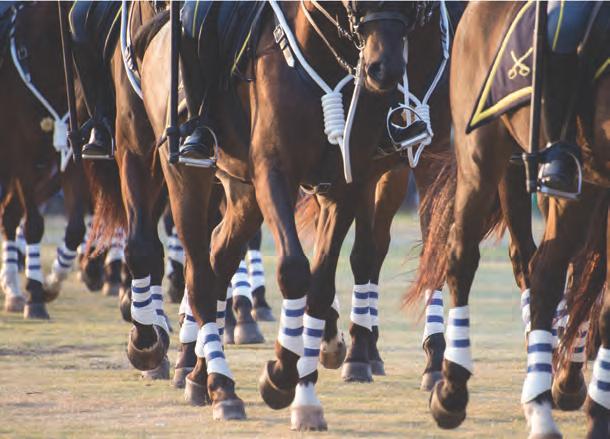




“Managing equine asthma (RAO and IAD) cases has been easier thanks to Aleira. After research in my lab as well as recommending it for use in the field, I have found Aleira to be a valuable tool in managing difficult respiratory cases. My goal is to reduce equine asthma burden and find a cure that would reduce the reliance on prescription drugs, especially steroids, in managing these cases. It is helpful to horse owners and veterinarians to have at their disposal a non-drug therapy that has proven efficacy and is easy to administer. I have many cases that are now well controlled by proper management of environmental conditions and replacing or reducing drugs with Aleira.”
“Managing equine asthma (RAO and IAD) cases has been easier thanks to Aleira. After research in my lab as well as recommending it for use in the field, I have found Aleira to be a valuable tool in managing difficult respiratory cases. My goal is to reduce equine asthma burden and find a cure that would reduce the reliance on prescription drugs, especially steroids, in managing these cases. It is helpful to horse owners and veterinarians to have at their disposal a non-drug therapy that has proven efficacy and is easy to administer. I have many cases that are now well controlled by proper management of environmental conditions and replacing or reducing drugs with Aleira.”
This study was designed to examine the effects of ALEIRA® on coughing, respiratory effort and performance. Aleira is a patented formulation of ingredients including a specific and purified omega-3 fatty acid, DHA (docosahexaenoic acid). Through the research conducted at the Purdue University College of Veterinary Medicine, Aleira was fed in conjunction with a low dust diet to 35 client-owned horses with chronic inflammatory diseases both recurrent airway obstruction (RAO) and inflammatory airway disease (IAD). Evaluation of laboratory and clinical parameters were made as well as assessment of daily on farm performance and results.



Overall, both clinician assigned VAS scores and owner assigned VAS scores improved 8 weeks in to the trial however, the clinician assigned VAS receiving Aleira supplementation reached statistical significance. Placebo clinician assigned VAS score increase was not significant.
VAS cough scores improved significantly in all 3 treatment groups but horses with 1 times per day dose of DHA exhibited a significantly higher VAS score 2 months later than placebo.
The effect of Aleira supplementation and pelleted feed on VAS scores was noticeable first at 2 weeks.
The effects of Aleira supplementation and pelleted feed reached maximum benefit for coughing between weeks 2 and 5.
The effects of Aleira supplementation and pelleted feed reached maximum effect for respiratory effort between weeks 5 and 6.
The effects of Aleira supplementation and pelleted feed reached maximum effect for poor performance between weeks 3 and 5.
Aleira Supplementation for 2 months resulted in a significant reduction in neutrophils in BALF which was not observed in placebo fed horses.
Aleira Supplementation for 2 months saw a significant improvement in lung function in horses supplemented with DHA.
Aleira Supplementation for 2 months resulted in a 10-fold increase in plasma DHA levels. No other fatty acid was affected.
Supplementation of ALEIRA to horses with RAO or IAD, in combination with a complete pelleted feed, showed significant improvement in clinical signs, including cough, respiratory effort and performance as well as lung function and BALF compared to the placebo group.
This formulation conducted horses laboratory

Reference: Nogradi disease.
Low conception rates. Mares taking multiple cycles to become pregnant or not conceiving for the year at all. Stallions with low sperm counts, poor quality and motility. Late-born, smaller foals at a disadvantage in yearling sales and competition.
These are some of the most pressing challenges in today’s breeding industry. These common reproductive issues are reduced with the help of a good DHA and cellular support supplement.
We developed Releira because there were no supplements available to help mares with fertility issues. There were only a few designed for stallions, but the reproductive health of mares was being ignored. Our research-proven formula offers a unique solution for a wide range of reproductive health issues, including problems with difficult mares. Supplementing with Releira helps mares that have difficulty conceiving become pregnant in fewer cycles. It reduces post-breeding uterine inflammation and fluids for higher pregnancy rates and it safely supports the mare and foal throughout gestation.
The same supplement can be fed to stallions to improve fertility. Pure algal-DHA works to not only increase sperm production, but to improve the quality of the cellular structure and progressive motility of the sperm for successful AI and live cover breedings. Even stallions with normal sperm counts often have numbers dip mid-season. Releira keeps numbers high throughout the entire season and improves numbers in stallions with low counts.
DHA improves molecular development of foals, creating a better cell membrane and more foals carried to term. Studies have proven that foals of mares supplemented with Releira have increased cognitive function and trainability. This is because quality DHA transfers to the foal during gestation and nursing.
If you’re ready for a more productive breeding season, try Releira. Our algal-DHA, research-proven formula is the solution for today’s most common fertility challenges in mares and stallions.
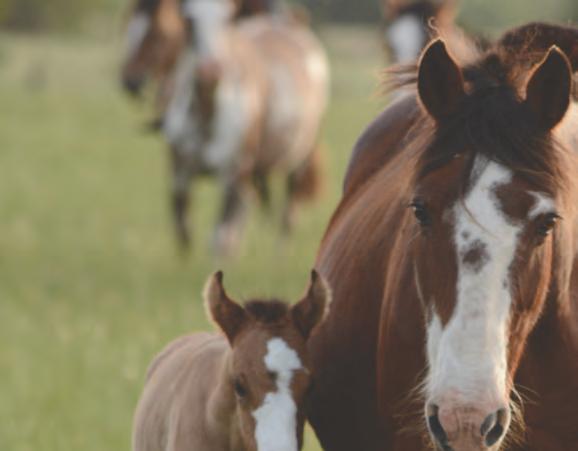


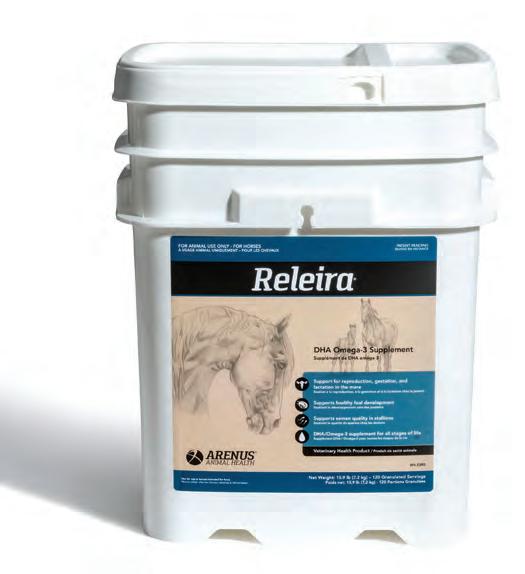
“I conducted a controlled trial utilizing a very robust frozen semen challenge that demonstrated a significant influence of supplementation with Releira on reducing the post breeding inflammatory response in all classes of mares.
A subsequent clinical trial involving thoroughbred mares and stallions in a commercial breeding environment further demonstrated the benefits of Releira in reducing breeding induced inflammation and improving per cycle pregnancy rates.”
Jim Brendemuehl DVM, PhD, DACT


The goal of this study was to determine if a significant difference existed in the uterine inflammatory response to frozen semen in response to supplementation with a blended algal and flaxseed source (RELEIRA) of the omega-3 fatty acid DHA. 15 mixed breed horses were used in the study. 10 mares were classified as resistant based upon uterine biopsy scores of I-A or I-B and ability to clear all mating induced endometritis at 24 hours post insemination. 5 mares were classified as susceptible with uterine biopsy scores of II-B or III and the presence of uterine hyperechoic fluid at 24 hours post insemination.
Essential reproductive support, Releira helps mares and stallions reach their full breeding potential in a daily, DHA supplement. This research-backed Omega-3 formula provides reproductive health benefits for mares, stallions, and foals. It addresses common fertility issues with a readily-absorbed, vegetarian algae source.
KEY BENEFITS FOR MARES:
Success in fewer cycles: Releira significantly improves conception rates in broodmares with a history of complications. Our DHA helps difficult mares that are typically bred in three to seven cycles to become pregnant in one cycle.
Reduced costs: Mares that don’t become pregnant still need care and resources. Quicker, successful pregnancies reduce the expenses for unbred mares and eliminates the missed opportunity of not having a foal to sell or compete with for another year.
Improved conception rates: Releira reduces post-breeding uterine inflammation and fluids for higher pregnancy rates.
Support throughout pregnancy: Safely provides constant reproductive support throughout the entire gestation period.
KEY BENEFITS FOR STALLIONS:

Boosts fertility: Improves pregnancy rates from stallions with a history of common fertility issues.
Increased sperm count: Stallions with normal sperm counts often have numbers dip mid-season. Releira keeps numbers high throughout the entire season and improves numbers in stallions with low counts.
Improved sperm quality and motility: Pure DHA works to not only increase sperm production, but to improve the quality and motility of the sperm for successful AI and live cover breedings.
KEY BENEFITS FOR FO ALS:
More live foals: DHA improves molecular development. This creates a better cell membrane and more foals carried to term.
Less late season foals: Mares bred in fewer cycles result in foals born on time. Late-born, smaller foals are at a disadvantage against older foals in yearling sales and competition.
Improved cognitive health: Studies have proven that foals of mares supplemented with Releira have increased cognitive function and trainability. Quality DHA transfers to the foal during gestation and nursing.
A very significant reduction in uterine fluid accumulation and neutrophil infiltration was noted in the five mares classified as susceptible. Plasma DHA levels were significantly higher at day 28 and day 60 as compared to day 0. The inflammatory response, as indicated by uterine fluid presence and neutrophil infiltration, was significantly reduced at 12 and 24 hours in both resistant and susceptible mares fed RELEIRA for 63+ days.
Oral supplementation of RELEIRA given to susceptible and resistant mares significantly
The daily physical demands on performance horses and changes in modern footing have resulted in new challenges for our equine athletes. Soft surfaces and deeper footing puts horses at increased risk of soft tissue injuries. Orthopedic diseases like osteoarthritis only add to the problem.
The daily physical demands on performance horses and changes in modern footing have resulted in new challenges for our equine athletes. Soft surfaces and deeper footing puts horses at increased risk of soft tissue injuries. Orthopedic diseases like osteoarthritis only add to the problem.
But it takes more than traditional joint support to protect our horses. Today’s athletes need broader protection from tendon, ligament, joint capsule, muscular and soft tissue damages.
But it takes more than traditional joint support to protect our horses. Today’s athletes need broader protection from tendon, ligament, joint capsule, muscular and soft tissue damages.
Equestrians today must find and use the best tools available to avoid major soft tissue injuries and control small, undetected strains and sprains before they become a major problem. This is the reason it’s crucial for riders to use great nutritional support and topicals to protect their horses.
Equestrians today must find and use the best tools available to avoid major soft tissue injuries and control small, undetected strains and sprains before they become a major problem. This is the reason it’s crucial for riders to use great nutritional support and topicals to protect their horses.
Our Steadfast line goes beyond the abilities of traditional joint supplements. Most supplements ignore bone and soft tissue health, leaving your horse exposed to a variety of painful or career-ending injuries. Our clinically proven Steadfast formulas offer total structural support for the most comprehensive protection available today.
Our Steadfast line goes beyond the abilities of traditional joint supplements. Most supplements ignore bone and soft tissue health, leaving your horse exposed to a variety of painful or career-ending injuries. Our clinically proven Steadfast formulas offer total structural support for the most comprehensive protection available today.







“RC Fancy Step has been great his entire career and he seems to be getting better with age. We attribute some of his success to using a great product like Steadfast Equine. I also use Steadfast Equine on some of my derby horses and all of my futurity horses.”
“RC Fancy Step has been great his entire career and he seems to be getting better with age. We attribute some of his success to using a great product like Steadfast Equine. I also use Steadfast Equine on some of my derby horses and all of my futurity horses.”
Shawn Flarida NRHA Champion and Arenus Ambassador
Shawn Flarida NRHA Champion and Arenus Ambassador

Steadfast Equine Performance protects and preserves your horse’s joint health to extend their career and keep them comfortable in training and competition.
No other equine joint supplement offers the unique formulation and scientific backing of Steadfast Equine Performance.

2X NATURAL PROTEIN NEM: Each packet of Steadfast Equine Performance contains a double dose of NEM compared to our original formula. Natural Eggshell Membrane provides a naturally occurring matrix of joint and structural support components that are synthetically manufactured in other supplements. NEM is a natural protein source that’s easily absorbed by horses for maximum structural support benefits. NEM results are proven more effective and faster acting than using traditional chondroitin and glucosamine. In a human study, NEM provided significant improvement to knee and hip osteoarthritis pain and stiffness within 10 days [1].
HIGH LEVEL PERFORMANCE PROTECTION: The lifestyle of equine athletes is stressful on joints, soft tissue and bone. Heavy training schedules, regular competition, frequent travel and uneven footing can lead to career-altering soft tissue injuries and chronic pain. Steadfast Equine Performance protects and preserves your horse’s joint health to extend their career and keep them comfortable in training and competition.
IMPROVED MOTION AND FLEXIBILIT Y: Performance horses with stiff, painful movement need total structural support for relief and comfort. Steadfast Equine Performance works fast with a powerful dose of Natural Eggshell Membrane to make your horse feel better for a longer stride length and more fluid motion.
RAPID REPAIR AND PREVENTION: Horses on Steadfast Equine Performance have the structural support to avoid time consuming and costly soft tissue injuries. Increased bone density, tendon strength, ligament strength and healthier soft tissues help prevent injury. Horses in training and competition need maximum support to keep them feeling and performing at their best.
TOTAL S TRUCTURAL AID: Complete structural support for healthy joints, soft tissue and bones. Made with the highest level of naturally occurring glucosamine, chondroitin, collagen and hyaluronic acid available. No other equine joint supplement offers the unique formulation and scientific backing of Steadfast Equine Performance.
PRE-MEA SURED SINGLE DAILY PA CKETS: Convenient, daily dose pouches come pre-measured for easy feeding and storage. No need to use two packets for a loading dose or during times of added stress. Your horse receives the maximum level of joint support in a single packet. Easy to travel with or store.


More than a joint supplement, Steadfast Equine offers complete structural support for all horses. The patented formula contains Natural Eggshell Membrane (NEM ) and TêlaFIRM.
®
More than a joint supplement, Steadfast Equine offers complete structural support for all horses. The patented formula contains Natural Eggshell Membrane (NEM ) and TêlaFIRM.
®
These proprietary ingredients combine to provide your horse with a bioavailable source of glucosamine, chondroitin, collagen, hyaluronic acid and chelated minerals for maximum joint and soft tissue support and performance recovery.
These proprietary ingredients combine to provide your horse with a bioavailable source of glucosamine, chondroitin, collagen, hyaluronic acid and chelated minerals for maximum joint and soft tissue support and performance recovery.
IMPROVED MOTION AND FLEXIBILIT Y: Horses with stiff, painful movement need total structural support for relief and comfort. Steadfast Equine works fast to make your horse feel better for a longer stride length and more fluid motion.
IMPROVED MOTION AND FLEXIBILIT Y: Horses with stiff, painful movement need total structural support for relief and comfort. Steadfast Equine works fast to make your horse feel better for a longer stride length and more fluid motion.
REPAIR AND PREVENTION: Horses on Steadfast Equine have the structural support to avoid time consuming and costly soft tissue injuries. Increased bone density, tendon strength, ligament strength and healthier soft tissues help prevent injury.
REPAIR AND PREVENTION: Horses on Steadfast Equine have the structural support to avoid time consuming and costly soft tissue injuries. Increased bone density, tendon strength, ligament strength and healthier soft tissues help prevent injury.
A CTIVE HORSE SUPPOR T: The lifestyle of a performance horse is stressful on joints, soft tissue and bone. Preserve your horse’s joint health to extend their career and keep them comfortable in training and competition.
A CTIVE HORSE SUPPOR T: The lifestyle of a performance horse is stressful on joints, soft tissue and bone. Preserve your horse’s joint health to extend their career and keep them comfortable in training and competition.
SENIOR SUPPOR T: Horses of all ages benefit from structural support maintenance. Arthritic and aging horses have additional stress on their joints that require support for optimal health. Steadfast Equine helps senior horses feel younger and more agile.
SENIOR SUPPOR T: Horses of all ages benefit from structural support maintenance. Arthritic and aging horses have additional stress on their joints that require support for optimal health. Steadfast Equine helps senior horses feel younger and more agile.
PRE-MEA SURED POUCHES: Convenient, daily dose pouches come pre-measured for easy feeding and storage.
PRE-MEA SURED POUCHES: Convenient, daily dose pouches come pre-measured for easy feeding and storage.
TOTAL S TRUCTURAL AID: Complete structural support. No other equine joint supplement available offers the unique formulation and scientific backing of Steadfast Equine.
TOTAL S TRUCTURAL AID: Complete structural support. No other equine joint supplement available offers the unique formulation and scientific backing of Steadfast Equine.
RESEARCH PROVEN
16 mature horses with OA were fed STEADFAST® Equine or a placebo for 42 days. Blood was collected every two weeks and levels of the biomarkers CTXII, PIIANP, and osteocalcin were measured. CTXII collagen is a byproduct of cartilage breakdown, PIIANP is a protein found in cartilage and blood increases indicate cartilage regeneration while the protein osteocalcin is important in bone mineralization and increases suggest chondromodulation.
16 mature horses with OA were fed STEADFAST® Equine or a placebo for 42 days. Blood was collected every two weeks and levels of the biomarkers CTXII, PIIANP, and osteocalcin were measured. CTXII collagen is a byproduct of cartilage breakdown, PIIANP is a protein found in cartilage and blood increases indicate cartilage regeneration while the protein osteocalcin is important in bone mineralization and increases suggest chondromodulation.
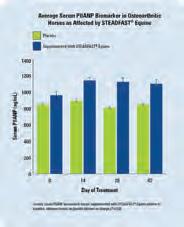





The decrease in serum CTXII and increase in serum PIIANP and osteocalcin suggest slowing of cartilage loss and rebuilding of cartilage and bone tissue in horses fed STEADFAST® Equine.
The decrease in serum CTXII and increase in serum PIIANP and osteocalcin suggest slowing of cartilage loss and rebuilding of cartilage and bone tissue in horses fed STEADFAST® Equine.
References: [1] Wedekind KJ, Coverdale JA, Hampton, TR,
L,
[2] JL, Zhao J, Knight CD. Efficacy of an equine joint supplement, and the synergistic effect of its active ingredients (chelated trace minerals and natural eggshell membrane), as demonstrated in equine, swine and an osteoarthritis rat model. Animal Physiology. 2015; 7: 13-27.

This study was designed to evaluate the effectiveness of a commercially available, herbal, nonheating liniment, Sore No-More Performance Ultra, in reducing pain and inflammation in horses with mild back pain. Conducted at Truman State University, 18 university-owned horses were randomly assigned to either a Sore No-More Performance Ultra treatment group or control group. Back pain scores in both groups were evaluated regularly over 44 days with a pressure force gauge.


Average Pain Score for Area Treated
As published in the Journal of Animal Science Average Pain Score for Area Treated with Sore No-More® Performance Ultra on Right Side
Overall, horses in the treatment group had a statistically significant decrease in pain score from the beginning to the end of the trial (44 days total).
Horses in the treatment group had a 2.87 decrease in pain score compared to a 0.72 decrease in pain score in the control group.
Thermal imaging also demonstrated a significant impact on temperature readings both at the time of the trial as well as after exercise and application of Performance Ultra.
Near the end of 30 days, horses in the treatment group had a lower average back temperature.
Horses treated with Sore-No-More Performance Ultra showed decreased back pain scores within the first two days of treatment.
For over 25 years, SNM has been the trusted source of pain relief for professional equine athletes, trainers, therapists, and vete rinarians.
For over 25 years, SNM has been the trusted source of pain relief for professional equine athletes, trainers, therapists, and vete rinarians.
SNM provides potent pain relief, targeting inflammation at the source with its proprietary blend of all natural herbs.
SNM provides potent pain relief, targeting inflammation at the source with its proprietary blend of all natural herbs.
Our herbs are carefully chosen, extracted and monitored for purity and strength. No harsh chemicals such as menthol or capsaicin are used in our formula.
Our herbs are carefully chosen, extracted and monitored for purity and strength. No harsh chemicals such as menthol or capsaicin are used in our formula.
SNM can help put a stop to the never-ending cycle of soreness, tiredness, and inflammation that can wreak havoc on muscles, ligaments, and other soft tissue.
SNM can help put a stop to the never-ending cycle of soreness, tiredness, and inflammation that can wreak havoc on muscles, ligaments, and other soft tissue.










“My 8 year-old gelding slipped real bad at a barrel race about a month ago and his lumbar area in his back got real sore to touch and the points of his shoulders got big knots in them. I had my chiropractor adjust him and I started using the SNM Performance Ultra Gelotion daily after workouts and within 3 days those muscles began to soften. I’ve since just made it a part of my daily regimen.”
“My 8 year-old gelding slipped real bad at a barrel race about a month ago and his lumbar area in his back got real sore to touch and the points of his shoulders got big knots in them. I had my chiropractor adjust him and I started using the SNM Performance Ultra Gelotion daily after workouts and within 3 days those muscles began to soften. I’ve since just made it a part of my daily regimen.”
Lynnzie Lindstrom, Arenus Ambassador, World Champion Barrel Racer
Lynnzie Lindstrom, Arenus Ambassador, World Champion Barrel Racer
“I like to use the SNM Gelotion on all of my horses after a long day in the arena. SNM is my go-to favorite because it helps to relax and relieve sore muscles and fatigue. The Gelotion with its thicker consistency helps to keep the back muscles nice and soft. Using SNM keeps my horses feeling good!”
“I like to use the SNM Gelotion on all of my horses after a long day in the arena. SNM is my go-to favorite because it helps to relax and relieve sore muscles and fatigue. The Gelotion with its thicker consistency helps to keep the back muscles nice and soft. Using SNM keeps my horses feeling good!”
Shawn Flarida, Arenus Ambassador, NRHA Reiner
Shawn Flarida, Arenus Ambassador, NRHA Reiner
“Every horse I own, or train uses SNM products daily, simply because there’s no question they work and are the best liniment product on the market. We all want our horses nice and supple in their muscles and SNM helps me get that. A horse that feels good will give you his all and SNM makes sure they feel their best.”
“Every horse I own, or train uses SNM products daily, simply because there’s no question they work and are the best liniment product on the market. We all want our horses nice and supple in their muscles and SNM helps me get that. A horse that feels good will give you his all and SNM makes sure they feel their best.”
David Ziegler, Arenus Ambassador Professional Dressage Rider
David Ziegler, Arenus Ambassador Professional Dressage Rider






PERFORMANCE
D aily use fo rmulation
D aily use fo rmulation
Soothing antiinflammatory
Soothing antiinflammatory
Use bef or e and af t er rides f or injury pr evention
Use bef or e and af t er rides f or injury pr evention
FEI compliant
FEI compliant



PERFORMANCE ULTRA


PERFORMANCE ULTRA
Clinical strength version of SNM
Clinical strength version of SNM
Most p ow erful & fastestacting SNM pr oduct



Most p ow erful & fastestacting SNM pr oduct
Soothing long lasting antiinflammatory
Soothing long lasting antiinflammatory
FEI compliant
FEI compliant
LINIMENT
· Great for sensitive skin
· Great for sensitive skin
· Can be sprayed on or rubbed in
· Can be sprayed on or rubbed in
· Safe to use on entire body
· Safe to use on entire body
· Can be diluted for a body brace
· Can be diluted for a body brace
GELOTION
· Slightly thick er consistency to make it easy to apply to hard-to-reach areas
· Slightly thick er consistency to make it easy to apply to hard-to-reach areas
· Safe to use on entire body
· Safe to use on entire body
POULTICE
· Ideal for use on lower limbs
· Ideal for use on lower limbs
· Pair with or without wraps, paper or plastic
· Pair with or without wraps, paper or plastic
· Effecti ve at pulling out heat and swelling
· Effecti ve at pulling out heat and swelling
Order directly from ARENUS.CA or call us at: 866-791-3344.
Order directly from
Reviewed by Sarah Mellings, EC Licenced Competition Coach
Can this horse really be sore no more?
I recently acquired a seven-year-old AQHA gelding named Playboy. Never in my career have I seen a horse holding that much tension in his body. His entire neck felt like one gigantic stone. I was told that he had been a rope horse at some point, was very cold-backed, had suffered some physical abuse, and that last year he endured a full rotational fall in a horse trailer and had torn his latissimus dorsi muscle.
Everything about this situation told me to turn and run, but there was something about his eyes that made me act immediately and go pick him up. There started our journey together of recovery and building trust.
Upon my initial assessment using some basic “carrot stretches” (dynamic mobilization stretches), Playboy was unable to move his head laterally more than five percent in either direction. He was also unable to reach a carrot held about a foot away from his chest. I immediately had the vet out to float his teeth, as well as vaccinate and deworm him. He also had some heat and swelling occasionally in each leg on various days.
I researched Arenus Animal Health, the makers of the Sore No-More (SNM) products. It was encouraging to read on the Arenus Animal Health website that SNM is the only liniment with university published research related to back pain, and that its herbal solution has been trusted by equine professionals and top competitors for over two decades, with research and published evidence to prove it works. I ordered both the SNM Performance Ultra Liniment and the SNM Performance Ultra Gelotion, which are their clinical strength, FEI-compliant herbal formulas designed for fast-acting pain relief in performance horses.
I started on a daily routine of using the SNM Performance Ultra Liniment, doing massage and release work on Playboy’s neck, back, and girth area. I also applied the gel when rubbing down his legs. The Gelotion formula foams up in areas with a lot of heat, helping to pinpoint areas of inflammation. At this time, I was only hand-walking him and doing light stretches.
After building up to some light work on the lunge line and under saddle, I put the SNM Performance Ultra Liniment into a spray bottle so that I could easily apply to all areas of concern both before and after I worked him, including the soles of his feet. I was very impressed to learn that it is safe to apply the liniment under saddle pad, polos, and stable wraps, and it will not cause blistering.
The SNM Performance Ultra Liniment is the most powerful liniment in the product line from Arenus, and Playboy needed as much strength as possible. It provides longlasting, rapid pain relief while still being gentle on both your hands and your horse’s skin. It has a highly concentrated blend of herbs that limbers up and prepares muscles and soft tissue before exercise, and it has really proven to relax and soothe Playboy’s sore muscles, back pain, and leg fatigue. I use a grooming mitt to curry it into his muscles and legs before and after riding to
promote circulation and to draw out heat and toxins.
After the first month of use, day by day I saw an improvement in Playboy’s mobility, and the muscles that originally felt like solid rock were starting to soften.

After two months of use combined with a slow and gradual increase of work, when doing “carrot stretches” Playboy is now able to reach around to his girth area on both sides. He is also now able to reach down to his knees and we are slowing working toward reaching his fetlocks. This is a MASSIVE improvement from where he started!
I have found the SNM Performance Ultra Liniment products to be highly effective for soft tissue rehabilitation and will continue to use them as part of my daily routine to quickly reduce pain, inflammation, and reduce the risk of injury. I love that it is effective, fast-acting, and convenient as a direct spray, massage, or invigorating bath brace, and safe to use under my saddle, wraps, and bandages.
A huge thank you to Arenus Animal Health, as Playboy is now on the road to recovery and to being Sore No-More! b


By Sarah Mellings, EC Licensed Competition coach
Whenever I coach a new group of riders at a clinic or in a lesson, I am always surprised at how few people can tell me the five different rein aids and the purpose of each. Therefore, it is always a question I like to throw out to the group. I usually see people looking down and moving their hands around, some vague stares, and the occasional rider being able to describe at least one or two of the five.
Rein aids are fundamental communication tools between rider and horse, facilitating direction, balance, and connection during riding. Each rein aid serves a specific purpose, allowing riders to communicate their intentions effectively. Let’s delve into the five different rein aids and explore examples of when to use each one.

The most basic and commonly-used rein aid is the direct rein. This rein aid acts directly to the rear and controls forward movement with two hands. The direct rein influences the horse from front to back longitudinally and can be used for turning and to maintain straightness. For instance, when turning left the rider applies pressure with the left rein while maintaining contact with the right rein to support the horse’s balance.
Indirect rein in front of the withers: This rein aid acts indirectly to the rear, in the direction of the rider’s opposite hip. The indirect rein is used to guide the horse’s shoulder and encourage lateral movement. It has the effect of displacing the horse’s weight onto the opposite shoulder. To execute this aid, the rider brings one hand slightly to the side and backward, positioning the rein against the horse’s neck in front of the withers. This aids in bending the horse around a circle or maneuvering through obstacles without losing forward momentum.
Indirect rein behind the withers: Contrary to the previous aid, the indirect rein behind the withers targets the horse’s hindquarters, influencing direction and impulsion. By moving one hand slightly to the side and backward, the rider applies pressure on the rein behind the withers, encouraging the horse to yield its hindquarters and move sideways. This aid is useful for executing lateral movements such as leg-yields and half-passes.



The opening rein is employed to create space for the horse’s shoulder or to encourage straightness. It involves moving one hand outward and slightly forward, opening the rein away from the horse’s neck. For instance, during a turn or circle the rider may use the opening rein on the inside to allow the horse to bend around the rider’s leg while maintaining balance and alignment.
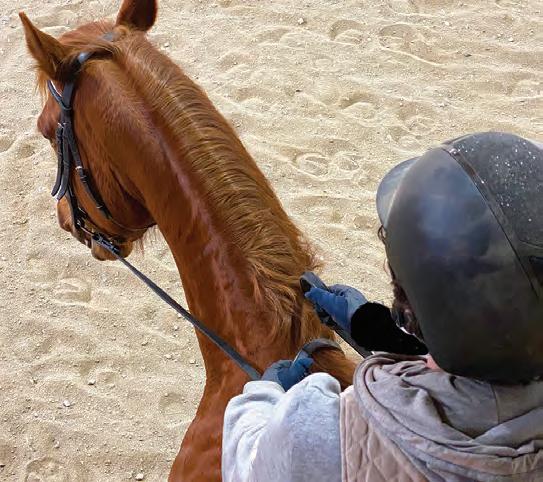
The bearing rein, also known as the neck rein, is commonly used in Western riding to guide the horse by laying the rein against the neck rather than pulling directly on the bit. When riding with a bearing (neck) rein, the rider applies pressure on the opposite side of the desired turn, prompting the horse to move in the intended direction. This aid allows for precise control and is particularly useful for one-handed riding, such as when working cattle or performing intricate maneuvres.

The pulley rein is an advanced rein aid used to halt or control a strong, resistant, or bolting horse. I like to call it the “emergency stop rein.” With this technique, the knuckles of the rider’s inside hand press against the crest of the horse’s neck while the outside hand pulls back and up. This action creates leverage and encourages the horse to yield to the pressure, gradually coming to a halt or returning control to the rider.
Understanding and mastering the various rein aids in riding is essential for effective communication and harmony between rider and horse. By utilizing these aids appropriately, riders can achieve precise cues, maintain balance, and guide their horses with clarity and finesse.
> Sarah Mellings is a new contributor to this magazine — read her bio on page 95.
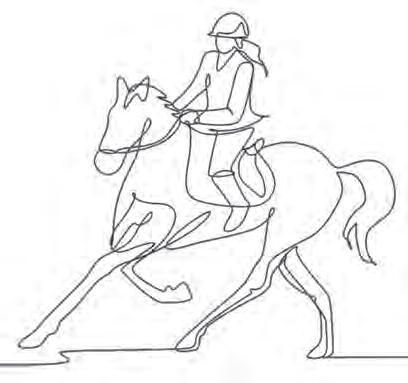




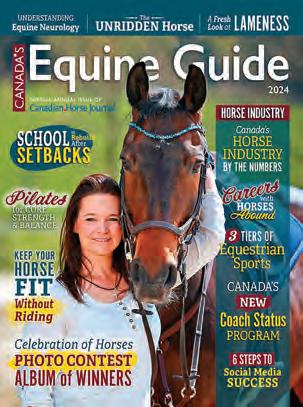

Calling all young riders! It’s time for some Fit To Ride Fun! This article is for those of you who want to have fun, improve your riding, and ensure your horses are happy and comfortable.
In general, movement and physical activity promote good mental and physical health, supporting motor skill development and social interaction. From exercises on and off the horse to interactive games and arena patterns, there are many ways to improve your
posture, balance, coordination, and overall fitness. As coaches and parents, recognizing that when youth associate exercise with enjoyment and fun rather than obligation they are more likely to be active throughout their teens and beyond. Explaining to young riders the benefits of fitness for themselves and their horses can help to build a foundation for a positive partnership and encourage life-long habits of physical activity and longevity in sport.
Equestrian sports require riders of all levels to have core strength, balance, flexibility, and coordination. These skills
By Sandra Verda-Zanatta SVZ Dressage & F2R Fit To Ride Pilates for Equestrians
are crucial to improve rider posture, alignment, and overall performance while promoting safety and horse wellbeing. A fit rider is better equipped to communicate effectively with their horse and maintain balance and symmetry while mounted.
A strong core is a key component for developing a stable, effective riding position. Core strength helps maintain stability in the saddle, enables better balance, and minimizes the risk of injury. Maintaining dynamic balance and having flexibility are also key factors for upright posture and an independent

When youth associate exercise with enjoyment and fun rather than obligation, they are more likely to be active throughout their teens and beyond.
seat. A combination of stability and relaxation promotes fluidity, improving the rider’s ability to follow the horse’s movement with ease. Seat independence gives riders the opportunity to develop “feel” and elasticity through their arms allowing consistent rein contact, while simultaneously using their seat and legs to influence the horse’s tempo, direction, and balance.
Being balanced in the saddle and developing an independent seat allows the rider’s weight to be distributed evenly
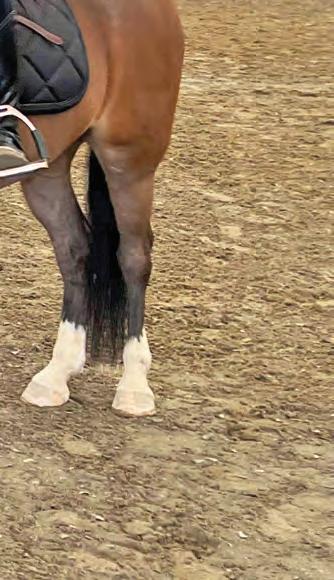
If you had to carry a backpack that was heavy and off-balance for a length of time you’d be uncomfortable and muscle-sore, just like a horse feels when the rider is uncoordinated and unbalanced.


Horses and ponies should be familiarized and comfortable with the exercise equipment.

• Stand facing your partner with knees bent slightly and shoulders flat on your back;
• Hold the flex band like reins with arms/hands in riding position, practice fluidly keeping slight tension on the band while drawing your belly button towards your spine to engage your core and moving hands forward and back.
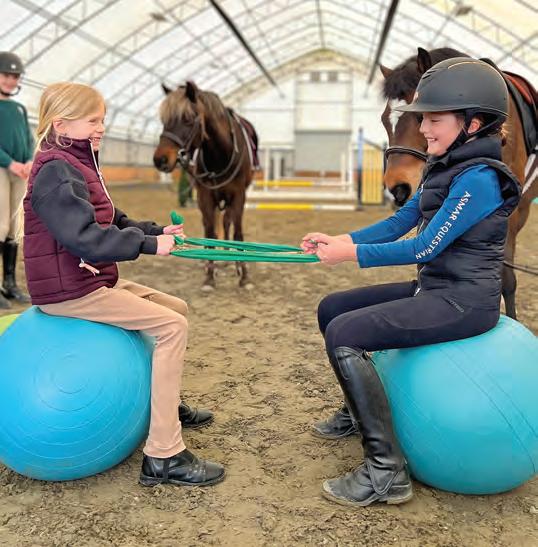



• Sit on the ball facing your partner, hold flex band like reins, and gently start bouncing on the ball with your core engaged and your seat maintaining contact with the ball at all times. Count the two-beat rhythm of trot to keep in unison with your partner, keeping slight tension on the flex band, and practice opening rein (external rotation) with elbows staying elastic (opening and closing as you bounce).

on the horse’s back. Rider balance and symmetry directly influence the horse’s physical development and affect training progress. When a rider is off-balance, sitting or leaning to one side, it can cause discomfort, potentially leading to muscle soreness, gait irregularity, and sometimes injury. Imagine how uncomfortable, fatigued, and muscle-sore you would be if you had to walk or run up a hill carrying a backpack that was heavy and hanging off to one side. This is similar to what a horse feels when carrying an unbalanced, uncoordinated rider for an extended period of time.
Furthermore, consistent imbalances in the rider’s position can eventually
• With the ball between you, stand back-to-back with your partner, feet hip-width apart, knees slightly bent, shoulders back.
• Keeping your upper body tall and straight, push gently into the ball without leaning back, and draw your belly button towards the ball to engage your core.
• Holding arms and hands in riding position, do 10 squats in unison with your partner without dropping the ball. Repeat three times.
NOTE: You can also place a flex band around your back and hold the ends like reins in riding position, and as you squat you press hands forward stretching the band.









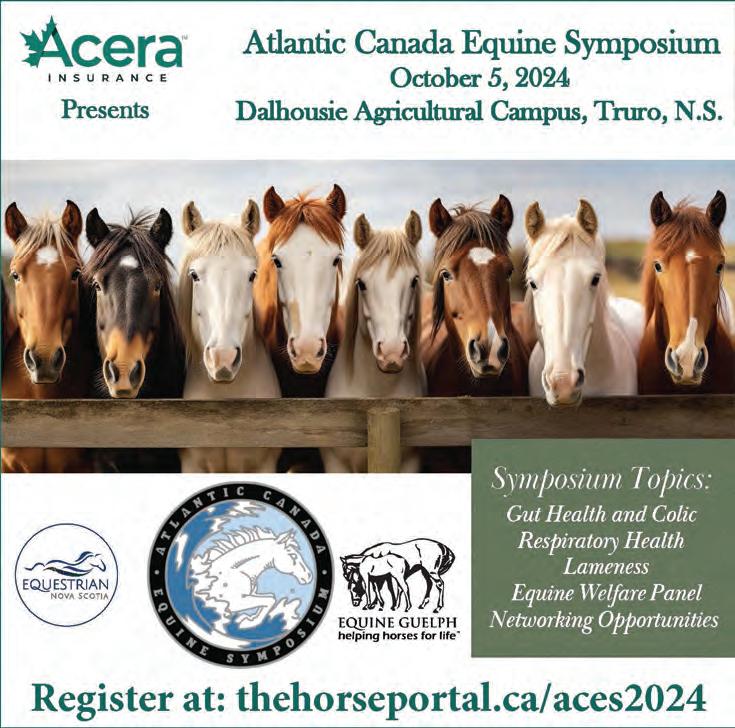





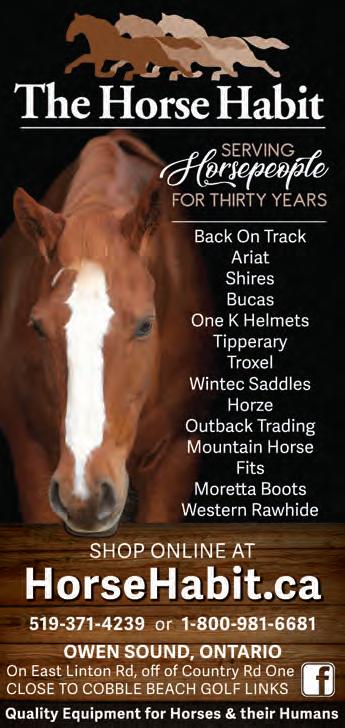

• Hold fitness circle just below belly button, press inward with hands while keeping shoulders flat on your back and core engaged;
• You can do this standing in riding position or mounted as shown here.
NOTE: Make sure your pony is comfortable with any exercise equipment you are using, and someone is holding your pony for safety.
lead to issues such as muscle asymmetry, back pain, or joint stiffness in both horse and rider. Being fit, developing body awareness, and working towards being a balanced rider can minimize potential problems and aid in the development of the horse-and-rider partnership. An independent seat can help the horse build strength, flexibility, and coordination evenly on both sides, resulting in a more balanced and supple equine athlete.
Along with the physical development of the horse, a balanced rider also directly affects the horse’s mental welfare and willingness to work with the rider. The bond between horse and rider is crucial to success in both training and in competition. A horse that is

• Same as Core Awareness with Fitness Circle exercise
• Then rotate to one side focusing on keeping seat bones equal in the saddle and shoulders square; the fitness circle should stay in the middle of your body; grow tall through the top of your head as you rotate;
• Return to centre and rotate to the other side, repeat each side eight times.
NOTE: On a safe, reliable pony with someone leading, this exercise can also be done at the walk.
uncomfortable or in pain will often approach their training session with anticipation of discomfort resulting in tension and negative behaviours, and over time they may develop other health issues such as ulcers. The significance of a rider’s physical fitness in achieving a cohesive partnership with their equine partner and realizing optimal performance is often overlooked. Whether you’re a high-performance competitor or a recreational rider, prioritizing fitness can support your journey by enhancing your riding experience and improving your skills, while helping promote the safety and well-being of both you and your horse. As a young equestrian, investing in your fitness by incorporating strength, balance, flexibility, and coordination training into your routine is invaluable in helping you

• Start facing your partner; bend knees slightly and lean forward with your upper body by closing your hip angle. Hold hands, draw your belly button in towards your spine to help stabilize your core to stay balanced, lift one leg off ground and extend it back, holding for five seconds — count out loud together.
• Extend leg three times, then switch legs and repeat.

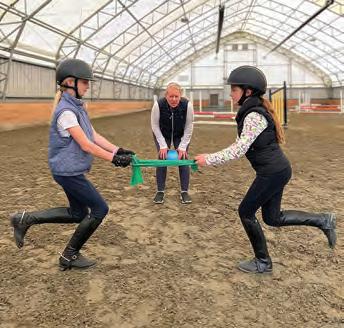
• Same as above
• Hold flex bands like reins and practice moving hands forward and back following your partner (you can extend your leg or hold it in
become a more confident, capable rider while fostering a deeper connection with your horse. The benefits of taking care of yourself and prioritizing your fitness extend far beyond the competition ring or trails. Integrating fitness into your daily routine is easy. Coaches can also encourage riders to have a pre-ride routine involving two or three exercises with a partner to promote fun and teamwork. Keeping exercise for youth fun and interactive can develop a lifelong love for both horses and physical activity, and establish trust and camaraderie with fellow riders.
This article shares some fun exercises you can do with your friends at the barn to improve your core strength, balance, and coordination! b
> Sandra Verda-Zanatta is a new contributor to this magazine — read her bio on page 94
bent-knee position off the ground) maintaining balance for 10 seconds each leg
• Repeat three times.

• Same as above — toss ball back and forth to your partner maintaining balance for 10 seconds each leg;
• Repeat three times.
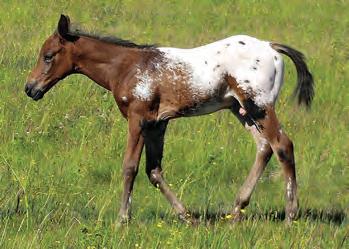
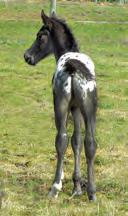
• Cost-effective • Safe around animals and people
• Fly parasites kill the developing flies before they hatch
“I can wholeheartedly recommend not only the bugs themselves as a very effective, environmentally-friendly part of a fly prevention strategy, but also Alan and as a very reliable and friendly source of predators.”

- Amanda J. Booth, DVM, M.VetSc, Dip. ACVIM

Don’t Wait! Start immediately at first sign of flies and reapply regularly through the fly season for optimal benefit. biological fly control has been used effectively in barns and stables across Canada for 20+ years with excellent results!



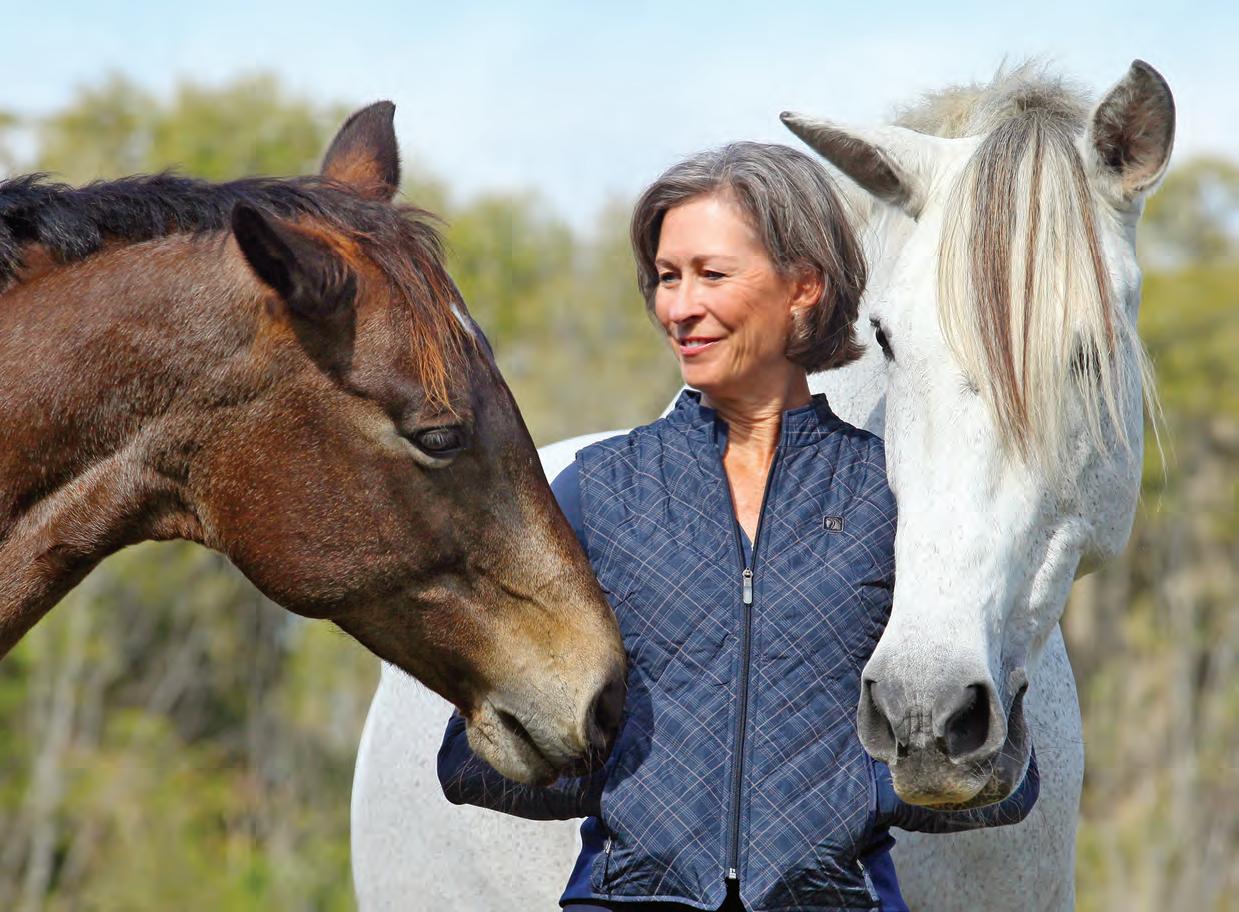
There’s a reason some call it “stressage.” Like ballet, dressage is an art form that balances grace with strength and athleticism, a feat demanding extraordinary mastery of the body. Unlike ballet, in dressage that feat is dependent on cooperation between members of two different species — cue the stress! And when riders are stressed, so are the horses. As a result, riders sometimes turn to dubious methods in an attempt to gain control of their equine partner.
In an era of growing awareness of horse welfare, dressage has been under the microscope. Case in point: in Danish TV2’s 2023 “Operation X” broadcast “Secrets of the Horse Billionaire,” an undercover journalist, working as a groom for Helgstrand Dressage, uncovered significant ill-treatment of horses. The exposé resulted in Olympic medallist Andreas Helgstrand being banned from riding on the Danish national dressage team until at least 2025 — after the Paris Olympics.
More recently, American grand prix rider Cesar Parra was provisionally suspended by the Fédération Équestre Internationale (FEI) after videos emerged of him “training” horses in ways described by the FEI as
By Li Robbins
“disturbing and abhorrent.” But the issue isn’t just about individual bad actors. It’s about the beliefs humans hold when it comes to the needs and rights of horses. Enter Karen Rohlf. Her approach, dubbed “Dressage Naturally,” prioritizes a horse’s happiness over performance and competition. It focusses on making learning dressage enjoyable for both rider and horse and emphasizes healthy biomechanics. Rohlf, a former dressage competitor at the grand prix level, reminds us that dressage is meant to be for the horse, improving balance and freedom of movement as the horse learns to carry a rider with ease, a goal that doesn’t always equate to the highest scores come show day.


“Competitive riding is a skill that ought to be layered on top of artful training,” says Rohlf, “but too often the techniques are different. Competition riding is often about getting it to look like it’s working even if it isn’t — make it look better NOW. Training is the art of riding today so tomorrow is better.”
The competitive world is “a tough place to do right by horses,” Rohlf says, something that demands a willingness to not let external pressures (e.g., sponsors, money, wins) lead to decisions that are bad for horses. Most of all, doing right by a horse means letting go of what Rohlf calls “the assumption of obligingness,”
“Competitive riding is a skill that ought to be layered on top of artful
the belief that horses should work for us. Embracing this point of view means acknowledging that horses don’t inherently owe humans a thing; that it’s up to the rider to inspire the horse.
“Too many dressage riders struggle pushing their low-energy horses around a dressage arena with bigger and bigger spurs and more and more leg when simply doing the same movements or exercises in a field or along a trail will naturally inspire much better results,” she says, citing one example.
The concept of “relationship first, dressage second” has considerable appeal, as evidenced by Rohlf’s growing number of followers, including those listening to her podcast, Horse Training in Harmony, rated by Listen Notes in the top one
percent of all podcasts globally. Part of her appeal lies in her delivery — she speaks to listeners as though confiding in a friend — not to mention that she does so with a healthy helping of humour. Her ability to lighten the stress around training dressage is one of the keys to her success.
Take Rohlf’s “Dressage Training Scale for Happy Athletes,” for instance. The traditional dressage training scale, developed in the 20th century from a German calvary manual, begins with “rhythm” followed by suppleness, contact, impulsion, straightness, and collection. Rohlf’s scale, on the other hand, starts with the word “happy,” followed by harmony, communication, and techniques only then addressing “dressage.”
Underlying any hint of whimsy is a serious message. The phrase “happy athlete” itself comes from the FEI dressage rule book — or at least it did until recently. Prior to the publication of FEI Dressage Rules 2024, article 401 stated that “the object of Dressage is the development of the Horse into a happy Athlete through harmonious education.
Creating a happy equine athlete starts with the concept of “relationship first, dressage second” and a consent-based approach tailored to training the individual horse.
As a result, it makes the Horse calm, supple, loose, and flexible, but also confident, attentive, and keen, thus achieving perfect understanding with the Athlete.” As of this year that wording, while existing elsewhere in FEI literature, is no longer in the rule book.
“An obvious downgrade in my opinion,” says Rohlf. “Perhaps the FEI is stating that it believes the art of dressage and competitive dressage are, indeed, two
separate and unreconcilable things. That would be a shame. I do believe it is possible to perform the art of dressage inside a competition arena.”
In Rohlf’s view, and the view of others concerned with horse welfare, both art and sport would benefit by being open to evolving ideas about what is and isn’t acceptable tack and equipment. There is, in fact, some movement in that direction — notably the recent decision making spurs
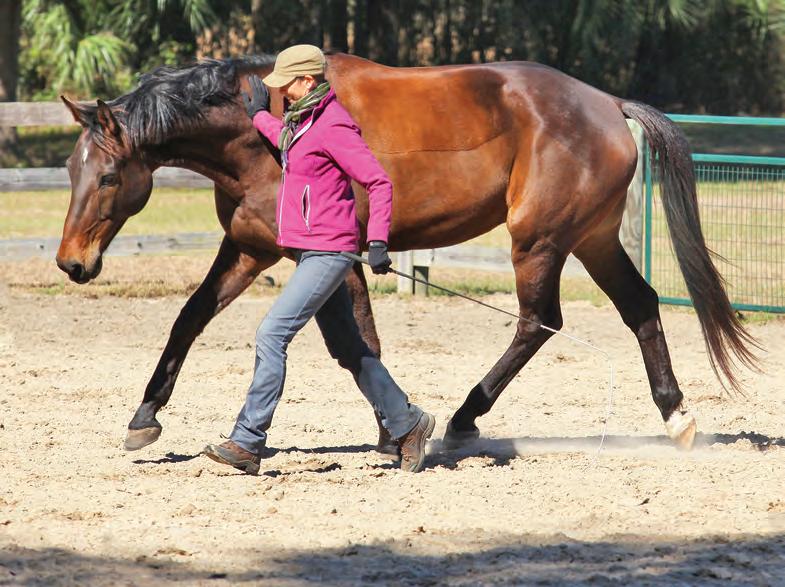



at FEI competitions optional. But other, more dramatic changes have been met with resistance. For example, the World Bitless Association’s formal request, in 2023, that the FEI allow bitless bridles in competition, was rejected.
Rohlf, who rides both bitless and not, says that when she asked a top FEI judge about allowing bitless bridles, she was told it would require “too much work” to rewrite the dressage section of the rule book, a response she views as “a big cop out.”
“A question I like to ask is whether bitless is an advantage or a disadvantage. If they can’t definitively answer that question then it is neither, so why not allow it and the scoring will work itself out…? All the qualities of dressage, including the connection through the reins, can be assessed with or without a bit. It requires artful training and decisionmaking to do dressage well with either.”If not bits, then perhaps nosebands will be the next frontier. While proponents of noseband use suggest they are needed to stabilize the bit (something Rohlf disputes), all too often in dressage nosebands are cranked tight in order to keep the horse’s mouth shut. Keeping the horse’s mouth shut may also prevent that horse from licking, chewing, and swallowing, while putting painful pressure on a delicate facial structure. Rohlf sees no good reason to use nosebands — and doesn’t.
But most of life is not lived inside the competition arena, notes Rohlf, meaning that as an individual horse person you have the power to lay the groundwork for “a happy athlete” before you even get into the saddle. Choose to focus on your horse’s fundamental needs such as “The Three Fs” (access to forage, freedom, and friends). When it comes to training, tailor your approach to your individual horse, a.k.a. consent-based training.
“Consent is an important concept for the modern equestrian to understand,” says Rohlf. “It requires self-control from the human as well as a willingness to adjust one’s plans. In the moment it may require more time to get what you want done, but the trust built through making things a good experience will often make it go much more quickly and easily in future.”
Consent-based training is sometimes misunderstood as “letting the horse get away with something,” says Rohlf, while in reality it is about listening to the horse and giving them “a voice and some choice.” For example, if a horse is resistant to having a
fly mask put on, rather than reprimanding her or holding her head down, a consentbased approach would be to consider how to make the process more palatable for that specific horse — an attitude requiring “compassion and curiosity.”
That said, putting on a fly mask is not training a horse to piaffe. Rohlf points out that by the time you’re teaching dressage movements a consent-based foundation will have created a deep understanding of your horse. This in turn will help you to easily gauge your horse’s reactions, such as whether any resistance is based in fear or lack of understanding or physical ability, rather than concluding, as some do, that the horse is simply saying “I won’t.”
Embracing consent-based training makes training dressage “a dance in connection rather than a wrestling match.”
No doubt there are some who view Rohlf’s approach to dressage — and to horse training in general — as neglecting to take into account some of the challenging physical realities of training a 1,200-pound prey animal, but Rohlf would disagree.
“Of course I don’t live in a magical unrealistic Disney movie,” she says. “There are rules and boundaries that keep us and the horses safe. And I don’t think any horse wakes up and says ‘Ooo, please
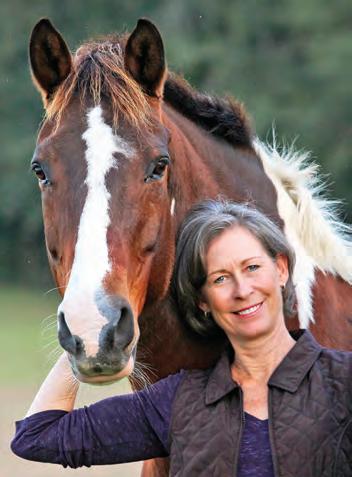
do dressage with me.’ But I do believe we can train in a way that is as generous to the horse as possible. And when a horse really does engage mentally, emotionally, and physically with what you have taught him, it is amazing!”
> Li Robbins is a new contributor to this magazine — read her bio on page 95.
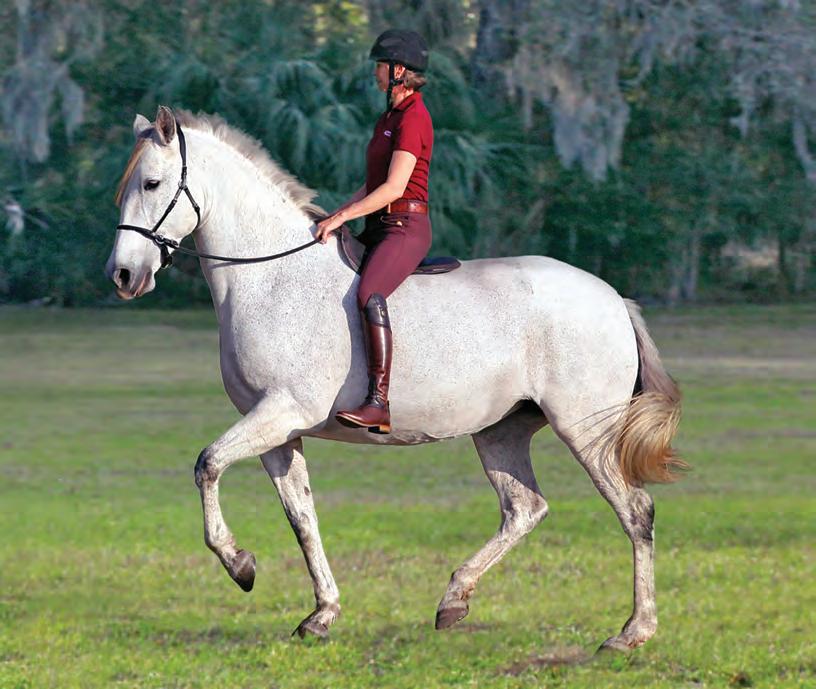
Rohlf believes that the qualities of
can be assessed with or without a bit.

By Annika McGivern, MSc, Sport and Exercise Psychology

What do you believe is more important in our work with horses: knowledge or curiosity? It’s easy to see why knowing the answer is desirable, but valuing knowledge over curiosity can create pressure, frustration, and low confidence. Not being able to use curiosity as a mental skill can cause us to wind up in never-ending cycles of frustration and perceived failure in our journey as equestrians.
Curiosity is having an open mind and the willingness to ask questions. It is the ability to go looking for more information, inspiration, new ideas, and new ways of thinking. I like to think about curiosity as a secret weapon for the mental game of
performance. Just by learning how to become more curious, we can improve our self-confidence, regulate our nervous system, and regulate our emotions. Not only that, activating our curiosity is also an excellent way of practicing the mental
skill of directing focus. Curiosity allows us to shift our internal state very quickly from unhelpful to helpful. There is no doubt that curiosity is an extremely useful mental skill.
Imagine that you are trying to train a young horse to move sideways away from single-leg pressure. You are doing your best to ask clearly and consistently, but the horse is not getting it. She is also getting increasingly tense and reactive as you continue to ask. She is stepping forwards instead of sideways and beginning to barge through your “woah” aids. You are feeling increasingly frustrated and tense. You are struggling
to come up with a solution or an idea of what to try next. Unhelpful, self-critical thoughts start popping into your head, and you feel lost and discouraged. What might block you from being curious in a situation such as this? Lots of things, as it turns out! Putting pressure on yourself to know the answer can do it, or buying into the mindset that smart or talented riders should always know exactly what to do. When this happens, you can get caught up in the desire to prove yourself, but there isn’t space for curiosity in the pressure to always know the answer. Your own brain can sometimes block you from being curious through its desire to stick to the safety of the familiar, which can make new thinking and ideas, or new approaches, seem risky or uncomfortable. Despite the many obstacles to curiosity, we can teach ourselves to use it as a tool by learning to slow down, take a breath, and ask ourselves high-quality questions.
What are high quality questions?
The human brain loves answering questions and will immediately get to work finding an answer to any question we pose to ourselves. It’s important to recognise that all questions are not created equal. For example, asking ourselves Why am I terrible at this? would not be helpful because the answer is likely to be steeped in negative thinking and emotion. We want to encourage a more helpful style of thinking and creativity in the face of challenge. A high-quality question produces a new, helpful thought or perspective on the problem. Here are some examples of high-quality questions:
1 What else could I try?
2 How can I help my horse learn this?
3 How can I make this five percent better?
4 What do I need to learn to solve this challenge?
By remembering to use high-quality questions as a tool in our imagined scenario above, you will start to experience benefits such as increased confidence, less negative emotion, and a calmer nervous system.
Every time we get curious in the face of a challenge, we encourage new thinking, to help solve the problem. This proves to us that we’re capable of getting unstuck, moving through challenging situations, and finding a solution. We are strengthening our self-confidence muscle which helps us to believe in ourselves, and in our capacity to learn, improve, and solve problems.



Z was an exceptional stallion: beautiful, correct conformation, powerful and elegant movement, combined with incredible scope made him an all-around exceptional athlete. Intelligent, engaging personality, brave and willing partner, and a quick learner. His foals all seem to have his temperament. Leeto Z’s elegant, modern type, tremendous work ethic and even temperament are passed on to his progeny.
FROZEN SEMEN FEE: $1500 (includes $250 booking fee) LFG

DARCONIDO Z is a big, fancy, young stallion with incredible suspension and tremendous power. Brave and scopey through the chute, with an incredible working attitude. His pedigree boasts Darco, the stallion who has the most offspring in the world to have competed to Grand Prix level, and Contender who has dominated German breeding values for many years now and continues to produce exciting young jumpers.
STUD FEE: $1250 (includes $250 booking fee) LFG
NIGHT’S WATCH is an exciting new stallion prospect. His pedigree is filled with top level show jumpers like Voltaire, Furioso, Nimmerdor, Gotthard, Farn, and Le Mexico, who are all great progenitors of modern jumper breeding. Night’s Watch is noted for his style, balance, temperament and good mouth. On his dam’s side we have Cantos, a reknowned Contender son and Indorado, well-known for producing big, long lined horses with an unlimited amount of scope.
STUD FEE: $1250 (includes $250 booking fee) LFG


Curiosity also helps us to regulate our emotions. Emotional regulation is the ability to recognize when we’re in an unhelpful emotional place and utilize mental tools to diffuse or moderate negative emotions, such as frustration. Frustration happens when we feel stuck or trapped. We often feel frustrated when we can’t see the way forward. Research demonstrates that when you take a frustrated person and engage their curiosity, multiple different areas of the brain start to communicate with each other. This suggests that activating your curiosity wakes up your thinking, problem-solving mind and your creativity.
This is the part of the brain that helps us to solve the problem and move forward. Curiosity encourages us to see options when we’re stuck in the “deep end” of negative emotion, and find our way to more stable emotional ground. If negative emotion is the deep end, then curiosity is a lifejacket we can throw ourselves to moderate the negative emotion and create more positive emotions for ourselves.
The way that curiosity regulates our nervous system is quite similar. Frustration
and other negative emotions are stressful and can activate the fight-or-flight part of our nervous system, further reducing our capacity to think clearly and creatively. By using high quality questions to activate curiosity, we’re redirecting the blood flow back out to the prefrontal cortex, which helps to regulate our nervous system to help us feel safe. Using high quality questions brings us back to focusing on the aspects of the situation we can control and influence, which will help us feel safer. By using curiosity, we can move from feeling unsafe to feeling safe, and further enable our thinking mind to come back online and solve the problem or find a solution.
Curiosity is a great way to practice shifting our focus, a key mental skill for performance. When we are feeling challenged, it’s easy to become fixated on the problem. Curiosity helps us shift our focus to solutions.
There are four styles of focus used in sport:
1 BROAD EXTERNAL: In a broad external focus we are paying attention to lots of the details in our environment.
2 BROAD INTERNAL: In a broad internal focus we are paying attention to different internal aspects of the self simultaneously, picking up on different sources of information from our internal state.
Curiosity is a keystone habit which unlocks a host of benefits, allowing us to quickly shift our internal state from unhelpful to helpful.
3 NARROW EXTERNAL In a narrow external focus we are focusing in specifically on one aspect of our environment.
4 NARROW INTERNAL: In a narrow internal focus we are focusing specifically on one aspect of our internal experience.
All four focus styles can be useful depending on the context and situational demands of the task at hand; however, they are not all helpful in every situation. A key mental skill for athletes is the practiced ability to switch between the four focus styles when appropriate.
A narrow internal or external focus often accompanies frustration. We have become overly fixated on one thing that we’re not doing right, or on the one thing that our horse isn’t doing right. In that moment, we might benefit from switching our focus style. For example, in our imagined scenario above, you could move to a broad external focus to consider what you could use in your environment to help your horse learn or understand what you’re asking. The highquality question: How else can I help my horse understand what I’m asking? helps us switch focus and find new ideas.
There’s a lot to learn in the world of mental skills for performance. I love finding and teaching simple skills like curiosity, which unlock a whole host of benefits. This type of skill is often referred to as a keystone habit. A keystone habit is one habit that, once mastered, unlocks many other helpful habits automatically. By mastering the skill of curiosity and turning it into a habit, riders will experience the benefit of improved self-confidence, improved emotional regulation, and improved nervous system regulation. In other words, consistently curious riders find it easier to believe in themselves, take on challenges, manage any negative emotions that arise, and stay calm in the face of difficult situations.
I challenge you to let go of the unhelpful belief that skilled riders always know what to do and instead embrace the belief that skilled riders do a great job of using curiosity to manage themselves and problem-solve to the benefit of themselves and their horses. b
> Annika McGivern is a new contributor to this magazine — read her bio on page 96.








By Will Clinging, CJF, AJFC
Over the past 30 years, I’ve worked as a horse trainer, a cowboy, and a farrier. Today, I’m a full-time farrier and have always been very active in our horse community. I would like to share how my perspective has changed over the years and how my experiences as cowboy, farrier, and trainer have influenced how I work today. I also want to talk about safe spaces, safe horses, and share some insight into the farrier industry and what is happening with farrier training and qualifications.
I am a career horseman and have made my living on or under a horse for three decades. During that time, the type of horse I will get on or under has changed. As a younger man there were only two things that should have stopped me from working on many of the horses I was tasked with riding or shoeing — fear and common sense. I soon learned not to be afraid, so when things got a bit wild, I was not intimidated. I have never had common sense, but rather an uncommon sense that allowed me to understand the horse’s perspective. Once I understood how the horse would respond and what caused the horse to respond the way he did, it gave me the confidence to work through whatever storm I was in the middle of.
I do not have that same confidence anymore. In fact, when I was training, one thing I heard from many of my clients was that they did not have the confidence to ride or even handle their beloved horse. I did not understand then, but I understand now. Confidence is fragile,
and in my case, just dealing with the volume of difficult horses became a challenge. I never thought I could fail, but a few less-than-stellar results can plant the seeds of doubt.
Now I only work on horses’ feet, and although I have a few difficult ones, fortunately they are not the same scale of difficult that I used to deal with. As a farrier, it is no longer my job to train your horse to behave. It took me a lot of years to realize this. For good clients I will still take the time to make Pumpkin’s first set of shoes a good experience, but I don’t have the same amount of time to spend with the horse. I don’t get to know the horses the way I did as a trainer or a cowboy. I see them for an hour every six weeks, not an hour a day for three months or have them in my string for years.
Many farriers do not share my horsemanship skillset. While some are proficient horsemen and women, their enthusiasm for handling challenging horses may pale in comparison to simply avoiding the hassle.
From your farrier’s perspective, if they are injured working on Pumpkin, they’re out of work, and the hundreds of horses they care for are not going to get their feet seen to on time. They may need to ask colleagues in the farrier community to help them catch up their schedule. We all try to help an injured colleague as a way of paying it forward, knowing that one day we’ll need the help. Even if they don’t get hurt, the farrier doesn’t have enough time to spend with your unruly Pumpkin to get the job done safely without being late for the rest of the day’s appointments. Keep in mind that if your farrier does arrive late, there may be a good explanation.
If the farrier works with an apprentice who is less experienced, does your horse create a workplace hazard? I was at a stop today to trim a couple of young warmbloods that are four years old, and today was the first time since they were born that I was actually able to trim them without first having them tranquilized. That’s because the owner has finally started working with them to get them
Standing quietly to be shod during Hurricane Bill in 2009, this draft horse is a well-behaved client.
It isn’t the farrier’s job to catch your horse or train him to behave. For the safety of your farrier and everyone else who handles him, your horse should lead well, tie quietly, and be comfortable being handled and picking up his feet.







Your farrier needs a large, bright, flat, uncluttered work area with dry rubber mats that extend at least four feet in front of the crossties.
ready to ride. It does not take much to make your horse easy to work on. Teach him to lead well (without being pulled on or pulling on you). Teach him to tie, whether in crossties or to a hitching post or a fence — he should stand tied and not be afraid. Teach him it’s okay to be touched and petted and patted. If your horse can do all of those things, his feet will not be a problem and your farrier will not dread working on your horse.
Safe spaces are one of my biggest concerns. I have worked with apprentices for many years. When they are less experienced, they do not always recognize trouble before it happens. I have been in enough wrecks that I can see it as soon as I get out of the truck. I am now at the point in my career where all I want to do is get home without an injury at the end of the day. This thought never used to cross my mind. As a cowboy I was too young. As a trainer I was usually in control of the environment in which I was working the horse. As a farrier we have to deal with the facility, or lack of, that the horse is housed in. The perfect area for a farrier to work in is large, deep enough for your big warmblood to have backed up to the end of the crossties and still have room for me to pick up a hind foot and be able to use my shoeing box. It’s bright — as bright as a school classroom. Light fixtures should not cast shadows or be mounted in the centre of the shoeing area where Pumpkin’s body creates a huge shadow, but mounted on each side of where the horse might stand. It’s flat with no drains; the drain creates a slope in the floor which makes it hard to judge the static balance of your horse’s feet and legs. It has rubber mats that extend four feet out the front of your crossties. These mats are not full of holes, and do not have gaps in between them. A rubber mat that ends at the crossties just gives your horse something to paw at. There are no blankets, saddles, tack boxes, and grooming kits in the shoeing area. The floor is dry and clean; rubber mats are slippery when wet and full of poop slime.
In reality, no barn I go to is ideal. Now I will briefly describe the conditions we work in every day, and every one is a WorkSafe hazard:
• 8 x 8-foot side-by-side crossties with the back wall full of blankets, and more
A poorly lit work area with a single florescent light in the middle of the ceiling creating shadows on both sides of the horse. The horse is turned around so the farrier can see by the light from the doorway.
blankets, halters and saddles hanging on the partition between the crossties.
• A barn isle with tack boxes along the walls and nothing to safely tie a horse to.
• Old, wet, slimy rubber mats.
• One fluorescent light fixture overhead with one burned out bulb.
• Cross ties that barely latch. I tell clients that I will not be responsible when the hot shoe I am trying to fit on their horse burns a hole in an expensive blanket hanging on the wall or in the new saddle they plan to use when Pumpkin’s shoes are done.
You may not be able to increase the size of your farrier’s work area, but it can be clean, dry, bright, and free of clutter. My reading glasses and a headlamp are my most important tools. If it’s dark I can’t see, which makes it very hard to do good work, therapeutic work, performance work, or even a regular trim.
Now if you combine an unsafe workspace with a difficult horse, you are



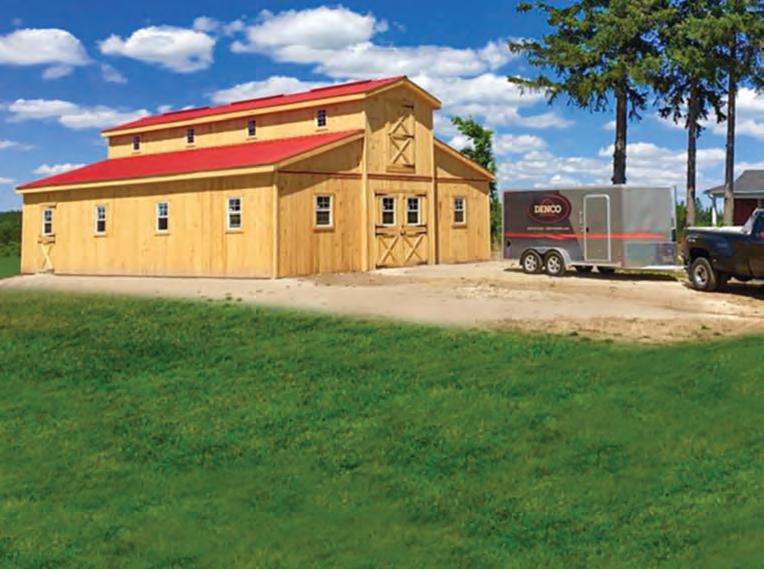










Apprentice farriers are important members of your horse care team. They work under the direction of your regular farrier and are dedicated to learning and improving their skills.
putting your farrier in a perilous position. Being a farrier already has many recognized physical workplace hazards such as awkward posture, repetitive actions, heavy lifting, bending and twisting, working in the heat and cold, working on uneven surfaces, and the need to hold up the horse’s leg for minutes at a time. Most farriers are chronically in pain. Our job is almost guaranteed to cripple us. Please do not put us at more risk than the job at its best already does.
Do you know if your farrier went to school to learn their trade, and where they went to school? Did they serve an apprenticeship and if so, with whom? Are they accredited? Do they participate in continuing education events? Do they have liability insurance? Do they have WorkSafe coverage for their apprentices? In Canada, farriers are totally unregulated and therefore, all the things just mentioned are voluntary. If your farrier can answer these questions, they likely take their vocation seriously. The farrier industry is in a huge training and education bubble right now. There is a farrier-related competition, clinic, conference, or exam every week of the year somewhere in Canada. The access to information, research, and modern materials is almost overwhelming. If your farrier is not involved, they are not keeping up and doing your horse a disservice. If they are not actively pursuing continuing education, they are ignoring the resources this industry is willing to share with them.
In Canada there are several large farrier associations. The Western Canadian Farriers Association (WCFA) for BC, Alberta, Saskatchewan, and Manitoba. The Ontario Farriers Association (OFA), and the Association des Faréchaux-Ferrants du Québec or Quebec Farriers Association (AMFQ). These associations have joined forces to create the Association of Farrier Trainers of Canada (AFTC). The AFTC has created a learning pathway for a new three-year Farrier Apprenticeship with three levels of exams before a farrier is recognized as an Approved Journeyman Farrier of
Canada (AJFC). The AFTC has created an exam process that is national in scope and has established a consistent standard for education, skills, and behaviour.
There are two other major associations internationally that grant qualifications after an exam process. The American Farriers Association (AFA), and the Worshipful Company of Farriers (WCF) from the UK (founded in 1356).
If your farrier has any accreditation from the AFA, WCF or the AFTC they have undergone a very difficult series of skills and knowledge tests, including anatomy, physiology, disease and lameness, forging and shoeing. The average farrier takes four attempts to successfully complete the process of certification. If your farrier has letters behind their name CF, CJF, DipWCF, AWCF, AFC, AJFC, be proud of them as they are among the few prepared to stand up and be judged by their peers.
The farrier culture in North America is not really used to apprentices. Many of us work with one or more apprentices, but it’s not the norm. I have been fired, and I’ve fired clients, because of my apprentices.
Think of apprentices as the best students, dedicated to learning to be better than the average farrier. If your farrier has an apprentice, take an interest. Learn the apprentice’s name (many clients don’t). You want apprentices working on your horse. They are working under direction, if not direct supervision. Apprentices are cautious, diligent, and possibly the only reason your farrier has the time to shoe or trim your horse. With a busy practice and an efficient apprentice, a farrier can do at least 50 percent more horses in a day than if working alone. Will your horse be the one that gets dropped because you don’t want the apprentice working on him?
My apprentices are an extension of my business, my training, my education, and my professionalism. Treat them like the important member of your horse care team they are.
If you trust me to work on Pumpkin and I send my apprentice instead, it’s because I trust them and believe them capable. I work on plenty of horses alone for various reasons and am aware of the horses that need more experience than an apprentice has. I will not put your horse at risk. Apprentices get better, faster, more confident, and become a huge asset to my business and the care
of your horse. I have had great apprentices that have gone on to be great independent farriers. They have made me a better farrier by questioning why I do something, pointing out my mistakes, asking me to check their work as I would ask them to check mine. They have certainly allowed me to shoe more horses for more years without becoming a total physical wreck. If your farrier has an apprentice, get to know them because they might just take over one day.
> Read Will Clinging’s bio on page 94.
b
RESOURCES:
Western Canadian Farriers Association
> www.wcfa.ca
Ontario Farriers Association
> www.ontariofarriers.ca
Quebec Farriers Association
> www.amfq.org
Association of Farrier Trainers of Canada
> www.farriertrainersofcanada.ca
American Farriers Association
> www.americanfarriers.org
Worshipful Company of Farriers
> www.wcf.org.uk








By Jacqueline Louie
The Painted Warriors Horseback Riding Backcountry Boot Camp is all about building skills and independence in riders of all levels. The five-day camp is one of a variety of horse- and naturebased programs offered at Painted Warriors Ranch, located in the foothills of the Canadian Rockies about an hour-anda-half northwest of Calgary, Alberta. Painted Warriors creates authentic outdoor experiences from an Indigenous perspective, based on co-owner Tracey Klettl’s Cree and Mohawk heritage and on the Ojibway heritage of her partner and
business co-owner, Tim Mearns.
The Horseback Riding Backcountry Boot Camp (Levels 1 and 2) is “a great program for experienced riders who don’t really have backcountry skills. To truly be able to go out and enjoy a backcountry trip when you’re educated, it’s safer,” Klettl says. “These are skills that don’t just make you more comfortable — they can potentially save your life. I think it gives people who want to ride in the mountains a holistic view — because being on the horse is just a small part of what happens.”

The backcountry boot camp is also designed for people who are not experienced riders but have always wanted to go into the backcountry.
“It gives them better insights as to how going out with an outfitter will feel and look,” says Klettl, a nationally certified English riding instructor. “It’s important for people to have the full picture and to be involved in that picture, right down to catching your horse, grooming and saddling it, and understanding how to put the horse away.”
“Preparation is everything,” adds




Animal Structural Kinesiology

Tom Durocher, Monty Roberts
Certified Instructor
Bringing a fresh perspective to the world of horses.
In his work with horses and riders, Monty Roberts Certified Instructor Tom Durocher goes far beyond “horse whispering.” He helps people gain a deeper understanding of horses, and reinforces the importance of connection and the relationship with their horse.
“We don’t use violence with the horses we work with. We don’t wait for the horse to make a mistake — we wait for the horse to do something right and reward the horse for that. Everything we do with the horse is communication,” says Durocher, who is from Fishing Lake Métis Settlement in east-central Alberta.
Durocher became the first Monty Roberts-certified instructor in Canada in 2005 and is also the first Indigenous Monty Roberts instructor. “We don’t run sessions for an hour-and-a-half straight. If it’s five, ten, or fifteen minutes a horse is going to give us, we’ll take that.

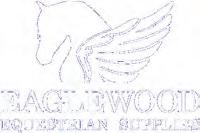

“It’s the silent language behind horses. What we’re talking about is the body language of the horse. Every gesture the horse makes means something,” explains Durocher, who has been a horse trainer for more than four decades and is also a retired farrier. “We study the body language of the horse and the psy-chology behind the horse — how he thinks, how he moves. We look for trust, respect, and leadership.”
In autumn of 2023, Durocher held a weekend demonstration at Painted Warriors Ranch in Alberta. A small group of attendees gathered at the round pen and watched Durocher calmly and patiently work with each horse. He pointed out small nuances in the horses’ responses, whether it was eye contact, ears, carriage, or the way the horse was breathing or standing. What also stood out was his gentleness.
“It’s by invitation and choice,” observes Ross MacInnes, who attended the demonstration weekend with NiChi, a 10-yearold draft-cross gelding. A retired police officer, MacInnes is a 30-year veteran with the RCMP and Calgary Police Service. He has been riding horses since he was seven years old and completed equitation training under the protocols of the RCMP Musical Ride. MacInnes, now the national training director with Equine Assisted Learning (EAL) Canada, an organization

Roberts Certified Instructor Tom Durocher works with NiChi, a 10-year-old draft-cross gelding, who was gifted to Ross MacInnes by a Cree elder. “NiChi” is a Cree word meaning “friend who is closer than a brother” or “two who travel together.”
that provides instruction to those working in the EAL field, appreciates how Durocher explains the “why” behind what’s happening in the round pen.
Over the course of the weekend, NiChi, formerly a feral horse, transformed from being very reluctant and fearful about loading in a trailer, to calmly self-loading.
“What Tom does is provide a process for the horse to be comfortable with the human and confident that he’s safe,” MacInnes says. “We watched NiChi become progressively more comfortable until he was loading by himself.”
On the second day of the demonstration weekend, MacInnes pointed at the horse trailer and asked NiChi — without using any kind of rope — to step into it from the middle of the round pen. “Away he goes, and he waits for me to close the door.
“I would encourage anyone, whether they are new to the horse world or an experienced horse owner, rider, or trainer, to spend time with Tom,” MacInnes says. “He brings a fresh perspective to the world of horses that will be of great benefit regard-less of your background. He is an out-standing clinician. He is easy to talk to, with a great sense of humour, and lots of good stories.”
Tom Durocher holds a variety of horse clinics and courses for all experience levels across Western Canada. He also coaches with EAL Canada.
> montyroberts.com/learning-center/ certified-instructors/canada
> ealcanada.com


Matthijs Duijs, a hiking guide and hiking and survival instructor from the Netherlands, showing how to make fire without using matches or a lighter.
Mearns. “We always say, ‘Knowledge is key.’ The more we know out there, the safer and more comfortable we can feel about going into the backcountry.
“If you have a better understanding of your surroundings and really know your horse’s ability, along with your own ability, you can further challenge yourself and see more of the countryside, and you can grow together. Where you can get to in the backcountry on a horse is just breathtaking, and you are bonding with this animal.
“It’s soul food. It brings you back in time, to be on the back of a horse. It’s how we used to move — we relied on our brother, the horse.”
I attended Level 2 boot camp in summer 2023, as well as the autumn camp, and thoroughly enjoyed each one. The group sizes are no larger than six participants, so there is ample opportunity to ask questions and practice skills. There were riding lessons and a trail ride, along with instruction on everything from navigation to fire building using alternate methods to matches and lighter, including ferrocerium rod, and a variety of materials (cotton balls, char cloth, feather stick, dried spruce twigs gathered from the forest floor, and even fluffy dandelion seed heads).
Matthijs Duijs, a hiking guide and hiking and survival instructor from the Netherlands, completed an internship at Painted Warriors in the autumn. “For me, the value is in the experience, knowing your surroundings and knowing what you’re seeing,” he says









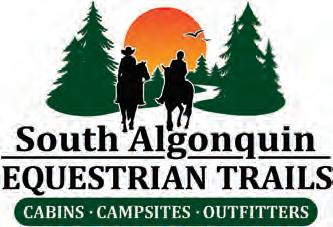
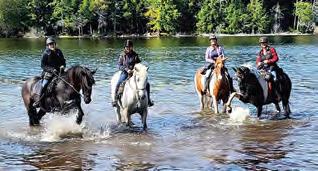



Ever-patient, and clearly explaining the “why” behind what he’s telling us, Duijs goes over the basics of what to bring into the backcountry. Even on a day trip, include a medical kit, tarp, emergency blanket, a variety of fire lighting tools, GPS, map, and compass.
“Technology can fail, but if you know basic orientation skills, you can read a map and your surroundings, which is really important — anything that gives you information about where you are and where you have to go,” says Duijs.
“Matches and lighters can get wet and stop working,” he explains. “When you’re making a fire with a fire striker, you’ve got something that always works. The more you learn skills like this, the more you can trust yourself and build confidence in uncomfortable situations. You are aware of the risks of your activities, but can make it as safe as possible for yourself and the people you take with you.
“These skills fit in well with what Tracey and Tim are trying to do here, which is bring us back to who and what humans originally were. That makes you more grounded and more capable of being independent.”
Boot camp participants were hands-on with all activities, including helping to prepare meals and cleaning up. After the fire lighting lesson, there were opportunities to put newfound skills into use. It was inspiring to watch the “Aha!” moments of other participants, for example, when they started the campfire for dinner using a feather stick.
Meals, overseen by Klettl, were incredibly delicious. Some of our dinners cooked over the campfire featured wild game — including curried antelope, served with rice; and shish kebab elk with mushrooms, onions, red and yellow peppers, rice, and coleslaw salad.
At this backcountry boot camp, it was Wendy Urton’s first time on a horse.
“This was SO much more than I expected. The first and most obvious thing is the love — love of the animals, nature, and every one of us,” says Urton, who lives in rural Alberta. “The quality of teaching was so intuitive and skillful — it was amazing to me. You couldn’t help but feel part of a family while you were here. I loved it.”
Barbara Morgan is an experienced English rider; the summer boot camp was the first time she had ever ridden Western.
“For me, it’s really about the whole approach to the program,” Morgan says. “The first day we got to study the herd and then do some groundwork. It’s about building trust and the relationship with your horse. I think that’s a good foundation, and by having that, it felt very comfortable to actually ride the horse.”
Mel Lamadeleine signed up for the autumn horse backcountry boot camp because she wanted to broaden her riding experience and learn new skills from a different perspective. “This wrapped it all together. It walked you through an entire day in the backcountry working with the horse,” says Lamadeleine, who lives in Edson, Alberta. “The relationship between horse and rider is the most important thing, before you even think about getting out into the backcountry. That is so crucial — building trust with them, understanding their needs and understanding their language.
“And these are not just backcountry or horsemanship skills — they’re also skills you can take into your daily life,” she adds. “You’re learning things about yourself. You learn that you’re capable of more than you think you are.” b > www.paintedwarriors.ca
> Jacqueline Louie is a frequent contributor to this magazine — read her bio on page 94.

Tim Mearns teaches bear awareness and wildlife safety as part of the Horseback Riding Backcountry Boot Camp. He imparts essential knowledge for anyone venturing into the backcountry. Basics are key, including proper handling of food, using bear-resistant pack boxes, knowing how to use bear spray and having it ready to go at an instant’s notice. Equally important is understanding bears and what is important to them, such as the changing of the seasons and the types of environments they prefer. In the spring, for example, females will be out and about with cubs, and in the autumn bears are intensely focused on food and fattening up for winter.
“Here comes a big berry patch, and we can be loud,” Mearns explains — to let bears know that people are nearby. It’s all about learning to coexist peacefully.
“The more we are aware of how they operate and how they think, the better off we are. We owe that to the wildlife, to get educated about wildlife,” Mearns says.
Klettl shares teachings passed down to her sister, Brenda Holder of Mahikan

Trails (www.mahikan.ca) from their grandmother, about why the bear is a sacred animal to the Cree people. The bears and people were killing each other; finally, everyone agreed to live in harmony. “The bears saved our lives, because everything a bear can eat, we can eat,” Klettl explains. “We followed what they would eat. They taught us medicine, they taught us foods, and they taught us how to get through the winter by slowing things down. By following what the bears did, we learned to survive… It’s so important to respect them for the animal they truly are, especially the more we go into bear country.”



By Shawn Hamilton

There are many things that make a pack ride unique, such as the remoteness, the feeling of self-sufficiency, packing everything in by horse, and the sense of going back in time. On a four-day pack ride into the Cloud Peak Wilderness Area of Wyoming with Mark Patterson of Cross Country Equine, it was getting over the tricky parts of the trail to get to stunning scenery, accessible only by foot or horseback, that did it for me. Navigating through rushing waters, over wooden bridges, and across steep rocky terrain took us to pristine lakes, waterfalls, and mountaintops that offered breathtaking views of the Big Horn Mountains. Canyon, a draftcross gelding built for the job, carried me safely through even my scariest moments, making it a memorable and rewarding trip.

Mark picks me up in Sheridan, Wyoming early in the morning for our uphill drive to Spear-O-Wigwam ranch where the pack ride would begin. The road, recently graded, is only passable between June and September. “We are lucky, it can get really washed out,” Mark tells me.
Lush green valleys bordered by tall
pine forests lay in the foreground of the snow-capped Big Horn Mountains. Mark points to one of the peaks to show me where the ride will take us.
At an elevation of 8,500 feet, the snowtopped peaks reflect onto Cloud Peak Reservoir, a mountain lake below Cloud Peak, as we drive through the entrance of Spear-O-Wigwam ranch with its 100th anniversary banner proudly on display.

Originally built in 1923 by Willis Spear, the main lodge was constructed to resemble a wigwam as an eight-sided lodge, 40 feet in diameter; later the shaft and spearheadshaped buildings were added. From the air, the building shape resembles the Spear cattle brand. Over the years, thousands of guests have come here to explore the high country and experience the rugged natural beauty of the area.
Spear-O-Wigwam is named to represent a combination of ranching life and native culture. Purchased in 2011 by the Northern Wyoming Community College District, it was used by Sheridan College as a nature retreat. In March of 2020, a group of investors with local ties bought the property with a vision of returning it to its original guest ranch roots, providing fishing, horseback
riding, biking, kayaking, and canoeing. There are multiple cabins on the 17-acre grounds, with trails leading to the vast Cloud Peak Wilderness Area, a 189,039acre parcel designated for preservation by The Wyoming Wilderness Act of 1984 Making our way to the dining room of the main lodge, we pass the crackling fire in the huge stone fireplace of the lounge area. Arriving just in time for breakfast,

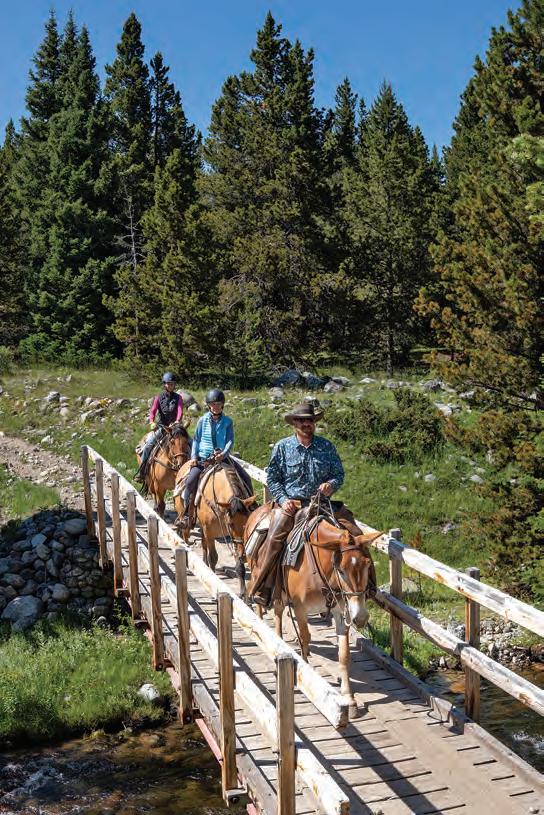

I meet two husband-and-wife couples from Eureka, Montana who will join us on the ride.
We all head to the corral with our bags and place them on two large tarps, where Mark weighs and marks the weight on each of them. As he carefully fills the packs for the five packhorses, Mark meticulously checks for equal weight on both sides. Along with our clothing, personal amenities, and food for the next four days, chain saws are added to the packs.
“This is the first pack in for the year,” Mark tells us, “So we might have to cut our way through on some of the trails, especially if the snow hasn’t receded enough to pass in some places.”
I was amazed to see his concentration and the accuracy of the packing process.
“If you do it right the first time,” he says, “you don’t have to stop on the trail.”
Finishing off with a few box hitches, Mark explains, “I don’t need a diamond hitch because the load isn’t top heavy; without a top load the diamond hitch doesn’t stretch well.”
I know I’m in good hands. Mark has been doing pack trips since 2006, his first being a 30-day pack ride along the Arizona Trail from the Grand Canyon. It’s obvious that this is his true passion.
I’m handed the reins of Canyon, a stalky draft-cross horse,
and am told he’s the photographer’s horse. “Like you, he’s a professional,” says Mark.
Everyone is mounted up and Mark, on a large blonde mule named Honey, leads the string of five pack horses out of the corral, over the creek, and into the forest. We follow with Wes, a wrangler from Arkansas, taking up the rear on Sherpa, a blackand-white pinto gelding with attitude. Fellow visitors Gina and Heather are on Norwegian Fjord crosses Baby Doll and Princess, while their husbands, Randy and Curtis, are on Fjords named Chester and Swede.
Heading northeast from the ranch, we navigate some tight spots between trees before passing a small lake, which eventually disappears below us as the trail winds uphill. Views of Black Tooth and Penrose Peaks can be seen through small openings of the forest. Above the tree line a large green valley spotted with lupins, Indian paintbrush, and deep purple snapdragons reveals breathtaking views of the Big Horn Mountains in every direction. As we cross the valley and begin to descend, the trail becomes steep and rocky. Canyon appears to be quite sure-footed and experienced at this, so I let him choose his way.
Mark points out some fresh moose tracks just before coming to a small dirt path.
“Camp is not too far now,” he assures us all. I can tell that Randy and Curtis are eager to dismount and give their bodies a rest. They’re on the trip for the fishing, not so much for the 15mile horseback ride on the first day.
We arrive at an open field of lush green grass next to Kearney Creek, commonly called Beaver Creek, which receives its water from Princess Falls. Following the path to the tack hut, we dismount and untack the horses. Mark attaches large cow bells to a few of the horses before turning them out into the fenced pasture encompassing the camp. They instinctively head to the creek for a drink before crossing it to graze.
Camp consists of one main lodge, three small cabins, a tool hut, and an outhouse. The cabins have four-foot log walls with heavy canvas roofs draped over frames. The main cabin houses a dining area and kitchen with a large woodstove in the corner for heat and boiling drinking water. Mark and Wes unload the pack horses while Curtis and Randy grab their fishing gear to head to the creek. I lay down on the giant picnic table to stretch my legs and look up at the tall lodgepole pine trees swaying in the breeze; birds hop from branch to branch against a deep blue sky, their chirps drowned out by the flowing of the creek and a few cow bells ringing.
Once the packhorses are unloaded, Wes cuts wood while Mark heads to the kitchen to make spaghetti and meatballs with salad. It is a happy surprise to have greens on a trip like this. Randy and Curtis return with a few small fish, eager to catch enough tomorrow for a fish fry. We dine around the campfire, I force myself to stay awake long enough to see the night sky fill with stars before heading to bed.
I spent a warm, comfortable night in my sleeping bag and cot, woken only by the morning sunlight streaming in through the window. It’s cold enough to see my breath, so I head to the cook cabin to make a cup of tea, sit by the fire, and watch the horses roam through the creek, which is backlit by the rising sun.
Mark is busy in the kitchen again, making scrambled eggs, pancakes, and sausages. Occasionally, a horse wanders through camp checking things out while we eat breakfast at the picnic table.




Chores done, Wes gives me a few roping lessons before he begins to cut wood for the stove, providing hot water for morning showers — quite a luxury on a pack trip.
Having a base camp further into the mountains allows us to explore deeper into the wilderness area. Without the packhorses we can get to some of the harder-to-reach places. When the terrain
becomes steep and requires navigation over large flat rocks, my anxiety heightens.
“Kick him on when going uphill,” Mark guides me. “It’s more dangerous going uphill on flat rocks as it’s harder for them to get their feet and legs from underneath themselves if they slip. Momentum is your friend,” he explains. I take his advice and nudge Canyon forward.
On the downhills, Mark suggests to “plant the palm of one hand on the horn


to support your weight and sit back on your sit-bones. Many people will tell you to stick your legs out in front of you in the stirrups to support yourself, but if the horse stumbles your feet will catapult you forward over the horse.”
I do as he says and feel much more confident on the rocky terrain. At one point Canyon places his foot in the middle of a large flat rock on a steep downhill stretch — I hold my breath — then he twists his foot, gets a good grip, and takes his next step.
“Like I said, he is a pro, just let him do his job,” says Mark.
We arrive at Princess Falls whose roaring waters flow into Spear Lake, which offers a grassy shore and the perfect picnic spot. Colourful buttercups, anemones, and asters surround us. It is unbelievably peaceful as the sun glitters off the surface water, with snow still clinging to the rocky cliff on the far side. After a relaxing break we mount up to head back to camp on a trail that follows a skinny ridge with rushing water below. I take a deep breath and put my trust in Canyon.
Back at camp we are greeted by happy fishermen who have caught enough fish for tomorrow’s dinner. We untack the horses and turn them loose to head to the creek for a well-deserved drink and a roll in the refreshing water. Wes stokes the fire for grilling steaks, with Navajo beef tacos on the menu followed by roasted marshmallows for dessert.
With a later start the next morning, we







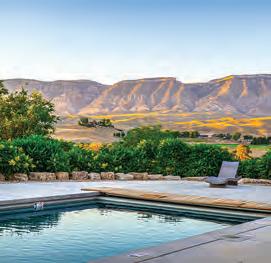















have time to linger. After breakfast of steak and eggs, Randy and Curtis begin to prepare the fish for tonight’s dinner. I spot a guitar hanging from the wall of the cook cabin and eventually get it tuned using pliers, as the tightening screws are stripped. Gina and Heather practice their roping skills with Wes.
We hit the trails late in the morning to ride to Willow Park Reservoir and Penrose Creek, where we take the horses into the deep water. It’s not quite warm enough to untack, put on our bathing suits and swim with the horses, but it’s still a lot of fun. A wooden bridge crossing doesn’t faze Canyon one bit, nor does the bushwhacking we do in search of a new trail. The grass is deep green, the sky is as blue as it gets, and a slight breeze keeps the bugs away — it is a perfect day. When we return to camp, I can’t believe it’s our last night. I feel like I’m just getting settled in and now understand why Mark is so passionate about his pack trips. Being away from it all in these surroundings makes one content with just being alive.
After our exquisite dinner of surf and turf and a few songs around the fire, we make it an early night as Mark suggests.
“It is the first time this year taking this trail back to the ranch, so we might
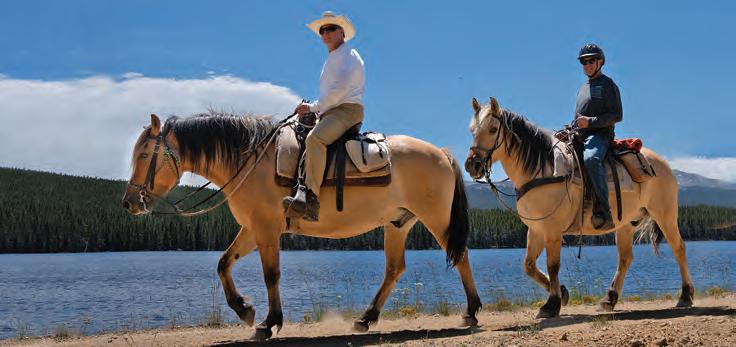






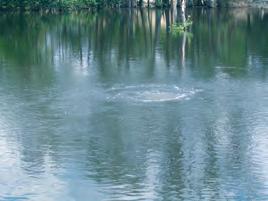


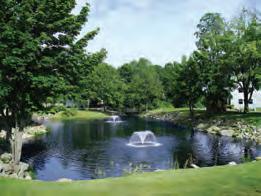










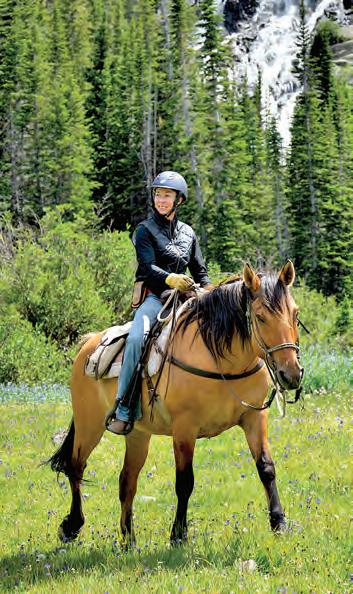
have to stop a few times to cut our way through. If we leave early enough, we should arrive back in daylight.”
By the time I wake up, pack my belongings, and leave my cabin, the horses are already tacked up and Mark and Wes are loading up the pack horses. After breakfast we all help clean the
The

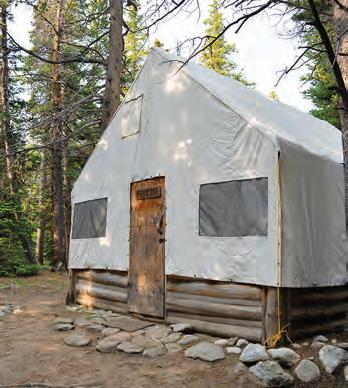

campsite before mounting up for the ride out. Completely comfortable now in the steep rocky terrain, I enjoy the spectacular views as we wind around and through interesting rock formations before descending into the forest. As predicted, there are a number of stops to cut away fallen trees along the trail, but our early start returns us to SpearO-Wigwam Ranch in daylight. I gather everyone for a group photo before saying our goodbyes and thanking both the horses and our wranglers for such a memorable ride. A special thank you to our host, wrangler, packer, chef, and riding coach Mark. It was a pleasure to be part of his passion — next time I will sign up for a longer pack ride! b
Mark Patterson of Cross Country Equine:
> www.instagram.com/ crosscountryequine
> www.facebook.com/ CrossCountryEquineKMarkPatterson
SPEAR-O-WIGWAM:
> spearowigwam.com/
> www.facebook.com/SpearOWigwam/
> Shawn Hamilton is a frequent contributor to this magazine — read her bio on page 94.



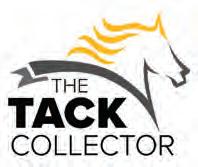







BY RHIANNON KING
Available now, all 2024 HCBC Memberships will be available for purchase!
2024 HCBC Membership Rates:
2024 Adult Membership:
$67.00 + tax = $70.35/member (19 or over as of January 1, 2024)
2024 Youth Associate:
$49.00 + tax = $51.45/member (18 or under as of January 1, 2024)
2024 Family Enrollment:
$158.00 + tax = $165.90/family*
*Family Enrollment: Minimum of three people defined as parent(s) or legal guardian(s) and their minor children residing at the same address. Maximum two seniors per family. Each member will receive their own number and card. New for 2024
HCBC is going green! All HCBC Membership cards will be sent digitally. Printed cards will be available for purchase for $5.60 each — just check the box to indicate that you would like to receive the printed version.
OFFICE HOURS:
Monday to Friday, 8:30 am to 4:30 pm
OFFICE ADDRESS:
27336 Fraser Highway, Aldergrove, BC, V4W 3N5
PHONE: 604-856-4304
FAX: 604-856-4302
TOLL-FREE: 1-800-345-8055
WEBSITE: www.hcbc.ca
EXECUTIVE DIRECTOR: administration@hcbc.ca
AGRICULTURE & INDUSTRY: industry@hcbc.ca
MEMBERSHIP: membership@hcbc.ca
COACHING & EDUCATION: coaching@hcbc.ca
MARKETING & COMMUNICATIONS: communication@hcbc.ca
RECREATION & TRAILS: recreation@hcbc.ca
COMPETITION: competition@hcbc.ca
COMMUNITY DEVELOPMENT: development@hcbc.ca
HCBC BOOKSTORE: bookstore@hcbc.ca
FINANCE & GRANT FUNDING: finance@hcbc.ca
After much deliberation over the many fantastic candidates, we officially announced our winners of the HCBC Annual Awards! The award categories for this year were: Coach of the Year, Bob James Volunteer of the Year, and Sherman Olson Lifetime Achievement Award. The winners of each award are as follows:
• Coach of the Year — Lisa Schultz
• Bob James Volunteer of the Year — Michelle Brittain
• Sherman Olson Lifetime Achievement Award — Diane Spencer
For 2024, Horse Council BC will be hosting the EQUUS Film Fest October 26. Mark the date in your calendars and be sure to stay tuned for more details coming soon!



Congratulations to the three winners and thank you from all of us at Horse Council BC for your contributions to the equestrian community. Stay tuned for this Fall when nominations for the 2025 HCBC Annual Awards will open.





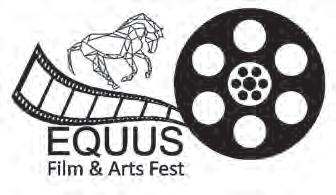




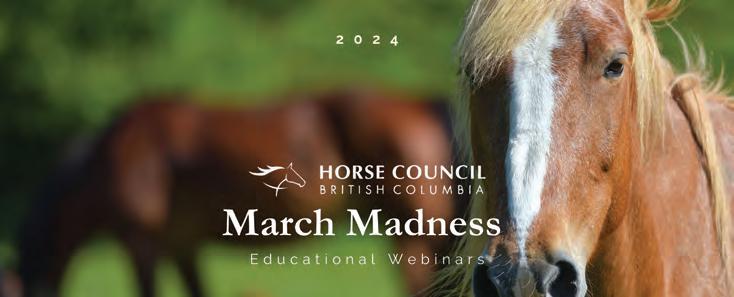
This past month, HCBC hosted our annual March Madness Educational Webinar Series. Several different speakers were invited to host webinars every Monday night for the month of March. A free event that is open to all HCBC members, the series saw great success this year with many people attending each week. Our speakers included:
• Dr. Clair Thunes — Vitamins Found in
Forage and Not Found in Forage;
• Dr Julia Montgomery — Equine Gastric Ulcer Syndrome;
• B. Grace Goderre — Equine Heart Health for Horse Owners;
• Dr Jane Westendorf — Lumps, Bumps, Scratches, and Scabs: Skin Issues in Horses. Thank you to all our speakers and to everyone who attended.



By Laurie Haughton, Chair, CQHA Media, Marketing & Communications Committee
The Canadian Quarter Horse Association (CQHA) was reestablished in 2001 to address the specific needs and concerns of Canadian Quarter Horse owners in Canada. In the two decades since that time, a lot has happened! If we look to just the past five years, many major events have begun to shape our horse industry and the world in ways previously unimagined.
CQHA invites all members and friends to join us at the Calgary Stampede — Thursday, July 11th
Strategic Meeting: Imagining the Future of the Quarter Horse in Canada
Special Guests: Members of the AQHA Executive Committee and the AQHA International Department
Location: The Quarter Horse Room located in BMO Centre
Time: Please check the CQHA website for exact times and meeting agenda.
The New AQHA Ranch Horse Classes: A Judge’s Perspective
Presentor: Lyle Jackson, AQHA, ApHA, NRCHA, NSBA Carded Judge
Location: The Quarter Horse Room located in BMO Centre
Time: 2:00 pm
CQHA Reception
Come and enjoy mingling with members of the Canadian Quarter Horse community while we watch the Working Cow Horse class. Refreshments and hors d’oeuvres will be provided.
Location: Suite 1 of the Nutrean Western Events Centre Studio 1
Time: 5:00 pm to 10:00 pm
The emergence of new equine sports, such as Versatility Ranch, has provided a new avenue to appreciate the value of traditional ranch horse work so that the skills required can be showcased, shared, and learned. The adoption of new technology, such as microchips, which became mandatory for all competing American Quarter Horse Association (AQHA) racehorses as of January 1, 2024, is providing us with new data and improving our traceability efforts through bettering our ability to identify horses and increase biosecurity. Most daunting perhaps in recent years was the huge socioeconomic disturbance that the pandemic created. By shutting down the majority of equine activity in Canada, it not only limited our ability to share our horse interests in the typical communal fashion, but also stunted our ability to showcase our horses in their respective disciplines for a prolonged period of time. All these activities have and will continue to impact and change the way Quarter Horses are enjoyed and perceived in this country.
The directors and committee members of the CQHA are dedicated to developing programs that support the growth and sustainability of the Quarter Horse breed in Canada. As a community of Canadians who enjoy the versatility of the breed and its disposition, we hope to

In the Spring 2024 issue of this magazine, the photo of Craig Cunningham in the CQHA article on page 92 was incorrect. The photo of Craig Cunningham, CPA, CA, MBA, an AQHA amateur competitor from Toronto, ON, shown here, is correct. The CQHA apologizes for any inconvenience this oversight may have caused.

develop opportunities to encourage new people to discover their love for Quarter Horses; create programs that support our breeders and owners; and partner with organizations that host both competitive and non-competitive events, where Quarter Horse owners and enthusiasts can share their passion for the horse, pursue equestrian-based education, and engage in activities that will contribute to the overall betterment of their horsemanship skills. All of this will culminate in culture that supports the welfare of the horses we love and admire. Imagining the future of the Quarter Horse in Canada cannot happen within a vacuum! Members of the Canadian Quarter Horse community are invited to participate in a nation-wide survey which will allow CQHA and its advisors help map out the future of the association.
CQHA members are urged to scan the QR code and complete the survey.

CQHA and AQHA have partnered to offer survey participants the chance to win some great prizes just for sharing your thoughts and ideas and dedicating a little bit of your time to help us imagine the future of the Quarter Horse in Canada. b
For more information about the Canadian Quarter Horse Association please visit > www.CQHA.ca or email > info@cqha.ca. Follow us on Facebook and Instagram @cndquarterhorseassoc, and on X @CndQuarterHorse.

At Therapeutic Riding centres across Canada, children and adults with special needs arrive for their weekly riding lessons. Riders are greeted by their instructor and their volunteer leader and side-walkers. On the same horse each week, riders have a happy reunion with “their horse.” Team members remain consistently the same as they build a rapport with the rider for the best possible therapeutic outcomes.
This therapeutic riding team works its magic with children and adults representing a wide range of physical, cognitive, and emotional special needs. The horse is a powerful motivator and at therapeutic riding centres remarkable things happen every day.
The Canadian Therapeutic Riding Association (CanTRA) trains and certifies instructors in preparation for their work with children and adults with special needs. There are three levels of instructor certification (see right) and a mentorship program to support instructors-in-

training. Certified by both CanTRA and Equestrian Canada, therapeutic riding instructors work closely with consultant occupational therapists, physiotherapists, and speech language pathologists to set therapeutic goals. CanTRA instructors bring a high level of professionalism and skill to their team leadership.
CanTRA Instructor Certification:
CTRBI/BI-2 Canadian Therapeutic Riding Basic Instructor
CTRII — Canadian Therapeutic Riding Intermediate Instructor
CTRSI Canadian Therapeutic Riding
Senior Instructor
Therapeutic riding centres are almost always nonprofit organizations and/or registered charities with a small staff. They rely on volunteers to assist with program delivery as leaders and sidewalkers, as well as with farm property maintenance, office tasks support, and fundraising. But volunteers provide much more than helping hands. The commitment and passion they bring to their volunteerism infuses the program with a sense of community and joyfulness. Volunteers unfailingly say they receive much more than they give through the meaningful connections they make as part of a therapeutic riding team.
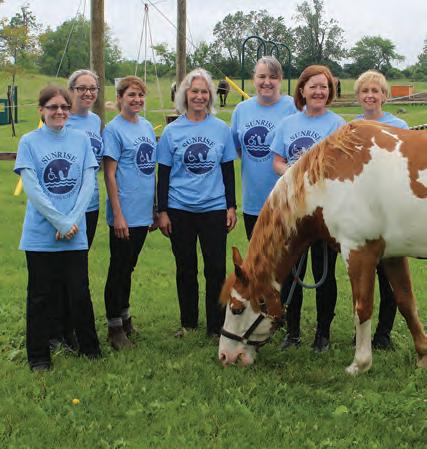
By Lynne O’Brien, Executive Director Sunrise Therapeutic Riding & Learning Centre (former CanTRA ED)
The acute awareness of horses makes them exceptional teachers, and therapy horses in particular are chosen for their steady, gentle temperaments. The foundation of therapeutic riding, these intuitive animals build relationships with their riders.
On a summer day at a therapeutic riding centre in southwestern Ontario, a young participant arrived for day camp. It was his first day and this little six-year-old boy with special needs was filled with anxiety and would not get out of the car.
Family members and centre staff worked to reassure him. Almost three-quarters of an hour later, moving across the barnyard very tentatively, this camper crossed paths with the therapy horse, Jack, who was being led into the barn. Jack stopped and gently stroked his big head alongside the boy’s arm. Jack stood and watched the little boy for a while until the youngster had the courage to raise his hand to touch him. Suddenly, “bye mom!” and Jack and his new friend entered the barn together.
As with most therapeutic riding horses, Jack just knew what was needed that day. b
For more information or to find a centre near you please contact our Head Office at ctra@golden.net. Follow us on Facebook @ Cantra. ACET and visit > www.Cantra.ca or donate at > www.CanadaHelps.org.


Tania Millen is an award-winning freelance writer and author with a Master’s in Journalism and a BSc in Environmental Science. She’s written four books, including Go Horse Camping and Pack’em Up, Ride’em Out: Classic Horse Pack Trips in BC and Alberta A former 3-day event rider, she now enjoys mountain pack trips. www.TaniaMillen.com

“Is it me or my horse?”
Horse show judge, coach, trainer, and specialist in equine behaviour, Lindsay Grice helps riders solve their “horse puzzles,” sharing keys from the science and research of how horses think and learn. She holds judging certifications in multiple disciplines — Western, hunter/ jumper, dressage and obstacle events. Lindsay has taught classes and seminars in Equitation Science for provincial equine associations, therapeutic riding facilities, and courses offered by the University of Guelph. She regularly conducts clinics for horse clubs and private farms. www.LindsayGriceRidingCoach.com

Jec Aristotle Ballou trains in Santa Cruz, CA, when not giving clinics around the United States. She is the author of 101 Dressage Exercises for Horse and Rider, Equine Fitness, and 101 Western Dressage Exercises for Horse and Rider. For further resources on the above topics, she recommends Beyond Horse Massage by Jim Masterson. Jec’s newest books are 55 Corrective Exercises for Horses, and 33 Strength and Fitness Workouts for Horses www.JecBallou.com
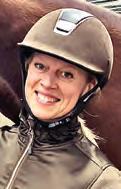
Sandra is a Licensed High Performance Dressage Coach, FEI grand prix rider, Equestrian Canada Coach Developer/Evaluator, and Certified Pilates Instructor. She has over 25 years of experience working with riders of all levels to improve position and overall effectiveness in the saddle. Sandra has extensive experience coaching internationally and conducts clinics and workshops in dressage, rider crosstraining, and instructor development.
Sandra operates her dressage training business SVZ Dressage and Fit To Ride (F2R) Pilates for Equestrians in Langley, BC.
She is currently working towards her Master’s degree in High Performance Coaching and Technical Leadership at the University of British Columbia. www.fit2ride.ca

Madeline Boast is an independent equine nutritionist based in Ontario. Upon completing her Bachelor’s Degree in Equine Management and Master’s Degree in Equine Nutrition, she launched Balanced Bay, a full service and independent equine nutrition consulting company. Through Balanced Bay she works with horses across North America, from competing Thoroughbreds to companion ponies and everything in between. Her primary focus is to create optimal and personalized foragebased nutrition plans as well as educate horse owners on equine nutrition. www.balancedbay.ca

Jacqueline Louie is a Calgarybased freelance writer and editor, and a member of the Travel Media Association of Canada, the Canadian Freelance Guild, and the International Association of Business Communicators. She won a 2022 Travel Media Association of Canada Certificate of Excellence for Second Place for Best Indigenous Tourism Experience Story. Jacqueline has taken the Painted Warriors Horseback Riding Backcountry Bootcamp (Levels 1 and 2) and is inspired to learn more. Currently, she is taking bareback riding lessons at Eagle Feather Riding west of Calgary. www.jacquelinelouie.ca

Annika McGivern is a Mental Performance Consultant who grew up as a Three-Day-Event rider in British Columbia. Her passion for eventing took her to Ireland, Australia, and America as a working student to world class riders, where she developed a keen interest in the psychological side of sport and performance. Annika has a BA in Psychology, an MSc in Sport and Exercise Psychology, and seven years experience as a certified Equestrian Canada Competition Coach. Annika works with athletes and coaches, in person and online, to help them find enjoyment and satisfaction in their sport through achieving their best possible results and outcomes.
www.annikamcgivern.com

Will Clinging, CJF, AJFC, started his journey to being a career horseman in 1994. As a cowboy, trainer, and farrier Will has spent 30 years on or under a horse.
Although no longer training, Will and his beautiful wife Shauna run a busy multi-farrier practice on Vancouver Island in BC. Will is active with both regional (Western Canadian Farrier Association) and national (Association of Farrier Trainers of Canada) farrier associations, recently being awarded the Industry Architect award by the WCFA. Will continues to be an advocate for farrier training, education, apprenticeship, and accreditation. www.willclinging.ca

Monique Noble is an awardwinning Alberta-based photographer whose talent behind the lens developed with old school film and dark room technology, which naturally progressed into digital single-lens reflex cameras and the digital lightroom. Monique’s photojournalistic style, coupled with her love of horses and the written word, led to a flourishing freelance writing career, which allows her to wander mountains with her horses, travel, and compete at national and international reining competitions all while working wherever her computer plugs in. www.facebook.com/Starizonimages

Shawn Hamilton
Shawn Hamilton is a freelance equine photojournalist based in Ontario. She has operated Clix Photography since 1984, offering a full range of photography services for editorial and commercial use from health to Olympic sports. Her photography can be found on the covers and inside numerous magazines in Canada and the US, including Canadian Horse Journal. Shawn has coauthored four non-fiction children’s books published by Scholastic Canada. Her written articles specialize in equestrian travel. www.ClixPhoto.ca

Dr. Crystal Lee
Dr. Crystal Lee, DVM, DACVS, is a veterinarian, owner, and board-certified surgeon at Burwash Equine Services. She graduated from the Western College of Veterinary Medicine in Saskatoon, SK, and went on to complete an internship at the University of Missouri and an equine surgical residency at Oklahoma State University. Burwash Equine Services is a locally owned, exclusively equine practice in Calgary, Alberta, that offers a wide range of veterinary services including reliable emergency services, surgery, sports medicine, podiatry, reproduction, and dentistry. www.burwashequine.ca/crystallee

Sarah Mellings is an EC Licensed Competition Coach. Having coached thousands of riders in her career, Sarah has the proven ability to have her students and horses progress and achieve their riding goals. Sarah has most recently developed a passion for reining and is pursuing her own riding goals in this discipline. Sarah is currently training horses and coaching at a brand-new indoor facility in Princeton, BC. sarahmel98@gmail.com

Li Robbins is a freelance writer and former CBC producer whose work has appeared in the Globe and Mail, the Toronto Star, Horse Sport and Horse Canada, among other publications. A hunter-jumper rider in her youth, Li has become a dedicated “re-rider,” thanks to her young half-Arab halfPaint mare, Pippin. www.lirobbins.ca


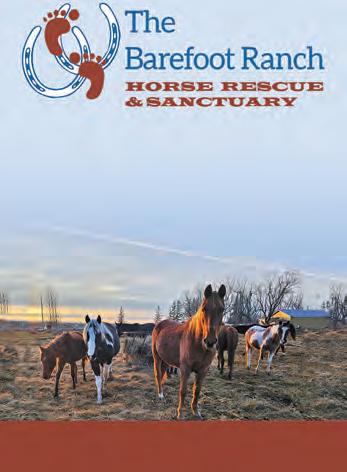
The Barefoot Ranch Horse Rescue is 30 minutes north of Winnipeg, Manitoba, near Teulon. We are a registered charity that takes in unwanted, neglected, and mistreated horses, provides them with loving care while we rehabilitate them, and helps them find a forever home. Giving them their best lives is our passion, and we are committed to this mission.
By Jec Aristotle Ballou
Trafalgar Square Books, 2024
ISBN 9781646011865
132 pages; hardcover
Reviewed by Tania Millen
Riders often focus on training their horses to do specific movements such as those needed for dressage, show jumping, cutting, reining, or myriad other sports. However, focusing on teaching skills rather than increasing strength and fitness can lead to potential unsoundness or a shorter competitive lifespan.
Jec Aristotle Ballou believes that lack of fitness reduces performance and “a well-prepared body can do incredible things.” Her new book, 33 Strength and Fitness Workouts for

Do you need to —
• Renew your subscription?
• Give a gift subscription?
• Change your address?
• Report a delivery problem?
• Ask a question? subscriptions@horsejournals.com www.horsejournals.com 1-800-299-3799 • (250) 655-8883

Horses, is based on the premise that well-designed workouts can help horses remain sound and healthy over the long term.
The first section of the book describes how to use it and who it’s for. Ballou writes that fitness relies on intensity, frequency, and duration, not just doing a bunch of exercises. She explains how to build more complete baseline fitness using groundwork routines — something that is often forgotten in the haste of starting young horses. Baseline fitness is generally achieved after horses have been exercised three or four times per week for at least 25 minutes over six weeks.
Ballou then provides numerous strength and endurance exercises for horses that already have a fitness base. The variety of exercises allows riders to “change it up” every two weeks so that their horse’s muscles continue to develop, and their fitness doesn’t plateau. Extensive photographs help explain the exercises while helpful tips keep riders on track. Some exercises require poles; others a simple elevated platform (bridge or pallet) or slight incline, but minimal equipment is needed.
The text is accessible; readers don’t need a scientific background to understand the concepts. However, for those keen on deeper understanding, Ballou does a great job of explaining exercise principles and how different exercises build fitness in one of three systems: cardiovascular, strength, or coordination/proprioception.
Full workouts are also provided so that riders can structure their weeks and months to achieve both fitness and competitive or skills-based goals. The benefits of every workout are summarized along with tidbits of information about how the horse’s fitness will increase. The “how-to” sections are excellent, with clear descriptions of what to do. Brief success stories are also scattered throughout, offering inspiration and real-world examples of how riders have used the exercises.
All told, this is a must-have book for every rider’s tack locker. Whether you’re fitting up a youngster, rehabilitating an injured equine partner, or looking for a competitive edge, this book will make it easy to create fitness plans. Just follow the workout “recipes” and reap the benefits of a sound, healthy, happy horse. b
> See page 46 for an excerpt from 33 Strength and Fitness Workouts for Horses. Publication date: June 2024.
> Tania Millen is a frequent contributor to this magazine. Read her bio on page 94.
ADVERTISING: sales@horsejournals.com
EDITORIAL, GENERAL INQUIRIES: editor@horsejournals.com
SUBSCRIPTIONS: subscriptions@horsejournals.com OR www.horsejournals.com

NEWS, SHOW REPORTS: news@horsejournals.com
PHONE (ALL DEPTS): 1-800-299-3799 • (250) 655-8883
MAIL: 10148 Bowerbank Road, Sidney, BC, V8L 3T9


